Wanderlust Travel & Photos
Seeing the world one trip at a time.
- Work With Me
- Travel Journal
- Privacy Policy
- Browse by Continent
- Tanzania Travel
- Thailand Travel
- Dominican Republic Travel
- Italy Travel
- Spain Travel
- Canada Travel
- Australia Travel
- New Zealand Travel
- Peru Travel
- Browse by Region
- East North Central
- East South Central
- Mid-Atlantic
- New England
- South Atlantic
- West North Central
- West South Central
- Central America
- North America
- South America
- Travel Vlog
- Instagram Photos

A Complete Indiana Dunes Park Guide for National Park Travelers
Last Updated: 2/9/24 – Complete Indiana Dunes Park Guide for Travelers
One of the newest national parks in the United States is quickly becoming known as one of the most fun parks to visit in the summertime. With an abundance of fantastic beaches, miles and miles of great hiking and biking trails, and some of the biggest sand dunes you will find in North America, Indiana Dunes State, and National Parks are a summer hot spot in the Midwest United States.
If you are into hanging out by the lake, camping out on a beautiful summer night, and doing some challenging hiking, then you will absolutely love Indiana Dunes. The park has some of the most beautiful beaches in the Great Lakes, which should come as no surprise as the park is known for its gigantic coastal sand dunes. These same dunes create some of the most unique and beautiful landscapes for hiking as well.
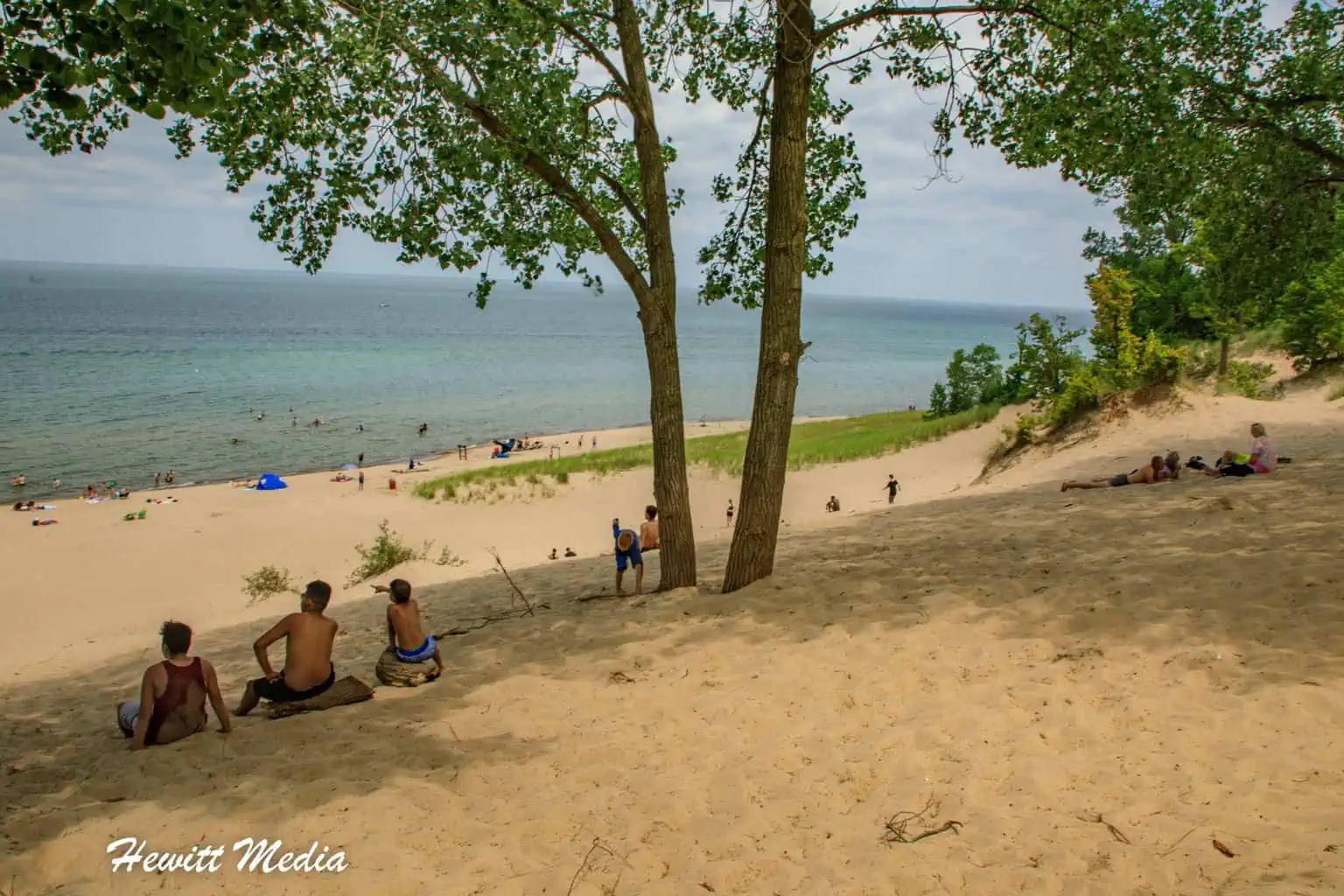
If you would like to visit the park, I would definitely plan ahead. Since becoming America’s newest national park in early 2019, Indiana Dunes has become inundated with visitors. People are flocking to the park to enjoy the beautiful summer days on the park’s beautiful beaches and amazing hiking trails.
In this Indiana Dunes park guide, I am going to give you all of the information that you need to make your visit to Indiana Dunes State and National Parks a success. I will outline the top things to see and do within the parks and give you some advice on when to visit, where to stay, and where to eat. I will also discuss the other things to see and do on an extended trip to the area.
Indiana Dunes National Park Guide Navigation Menu
How to get to indiana dunes national park.
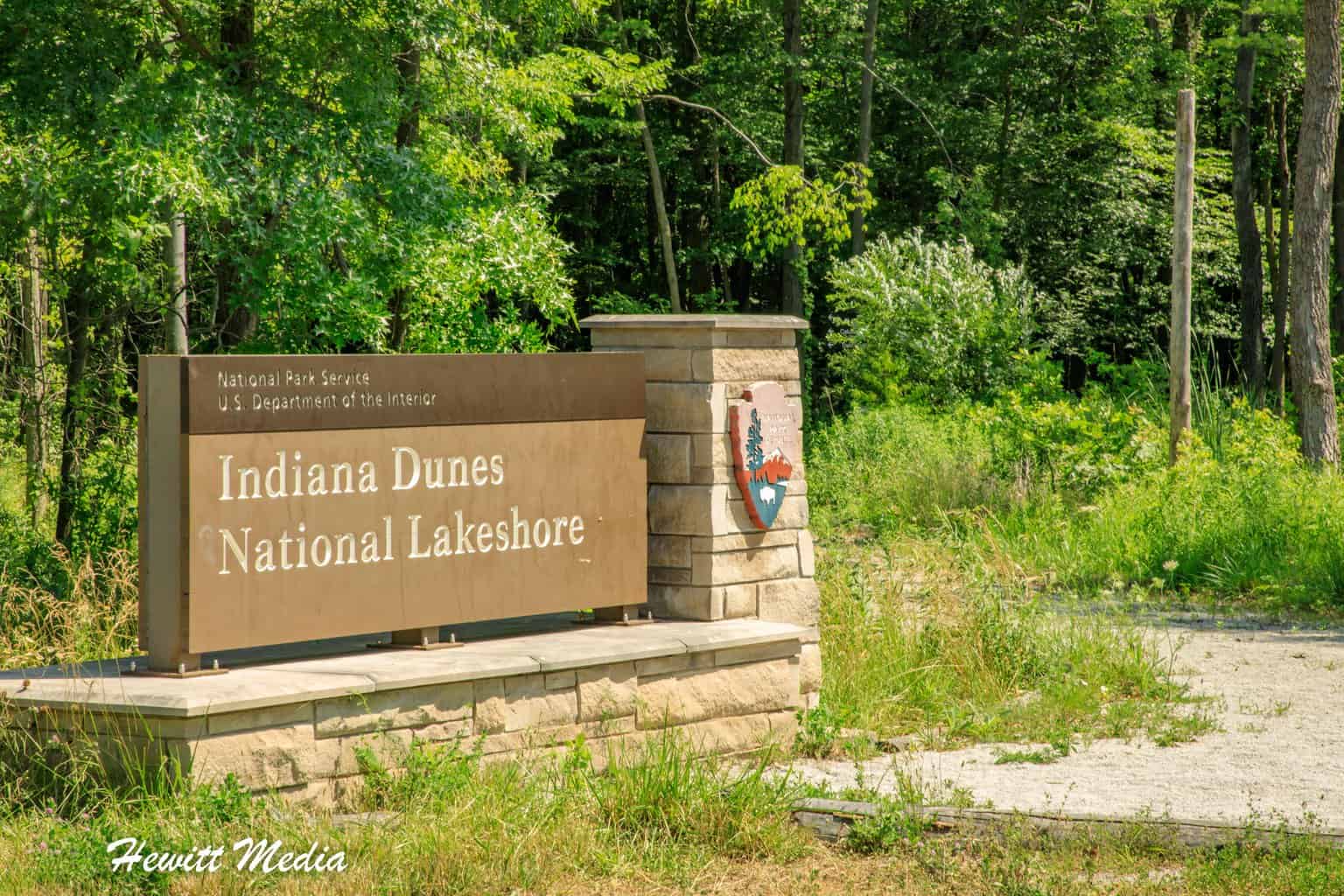
Indiana Dunes State and National Parks are located on the Southern end of Lake Michigan, just to the East of the city of Chicago, Illinois. It sits just inside the state of Indiana to the East of the city of Gary and the west of Michigan City. Because of its close proximity to the city of Chicago, Indiana Dunes is a great side trip to take on any visit to the Windy City to get away from the hustle and bustle of downtown.
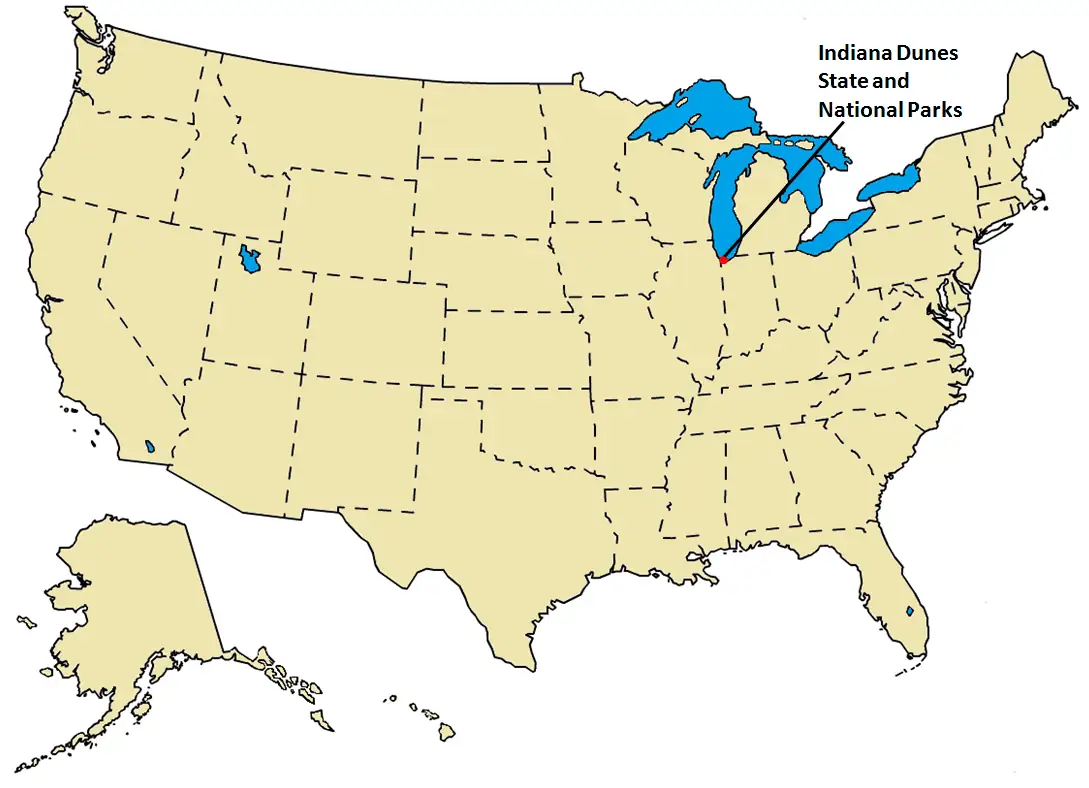
The park is comprised of both state and national parklands, with beautiful beaches and concentrations of sand dunes in each of the park areas. There is a fee of $7 for Indiana residents and $12 for out-of-state residents to enter the state park area and a fee of $6 to visit the West Beach section of the Indiana Dunes National Park. To give you a better understanding of the layout of the park, I have included a park map for you to review in my Indiana Dunes park guide below.
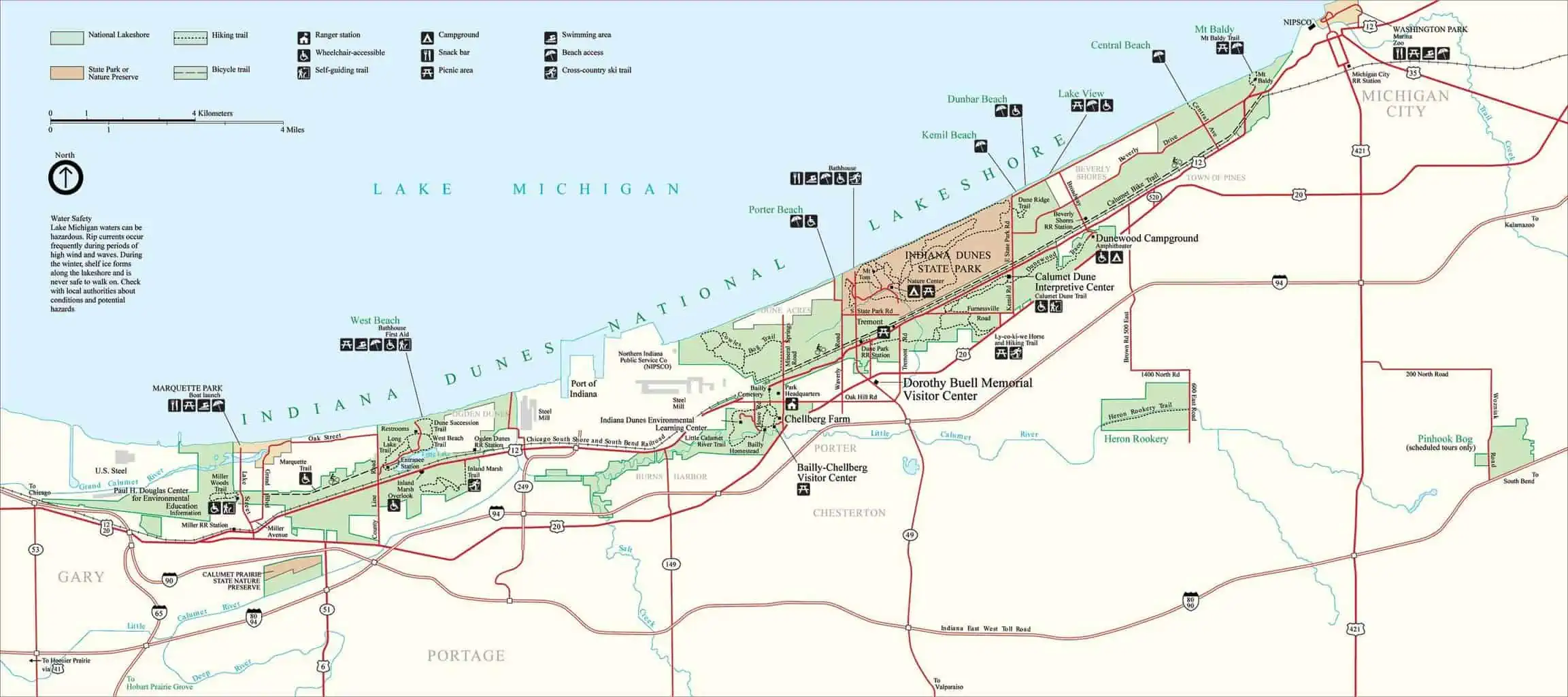
View Larger Map
If you are planning on visiting Indiana Dunes from outside the region, I have included some information on how long it will take to drive to the park from some major metropolitan areas with large airports. For those flying in to visit, your best bet is to fly into Chicago’s Midway International Airport , which is on the south side of Chicago. If you aren’t able to find a flight into Midway, you can also try Chicago’s O’Hare International Airport , which is on the North side of Chicago.
Indiana Dunes National Park Resources
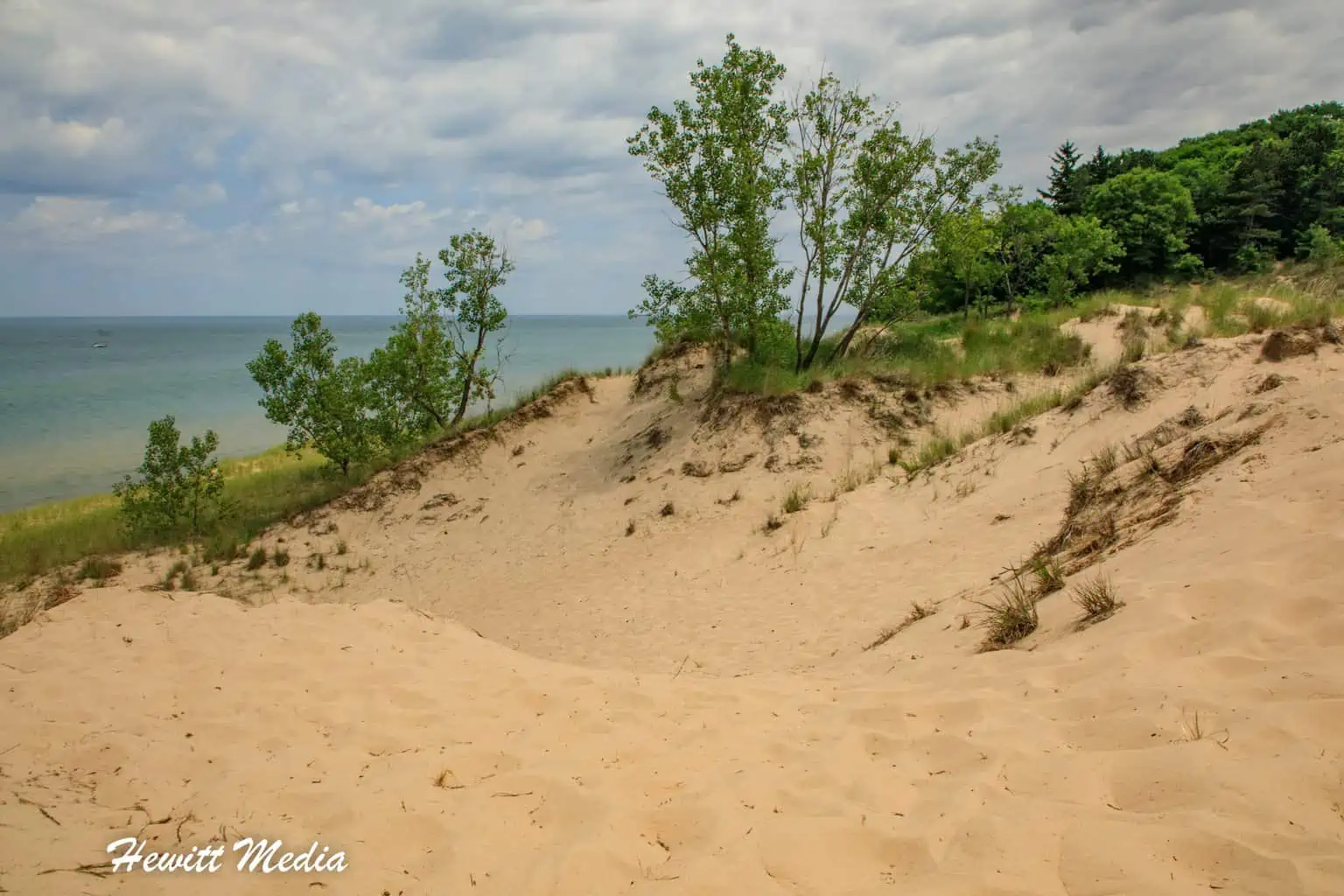
In addition to all of the information I have outlined in this guide, I have included some additional resources for Indiana Dunes State and National Parks that you can use to help plan your trip in my Indiana Dunes park guide below.
- Operating Hours and Seasons
- Park Fees and Passes
- Beach and Water Conditions
- Free Beach Shuttle Bus
- Outdoor Activities
- Guided Tours
- Nearby Attractions
Top Things to See and Do at Indiana Dunes
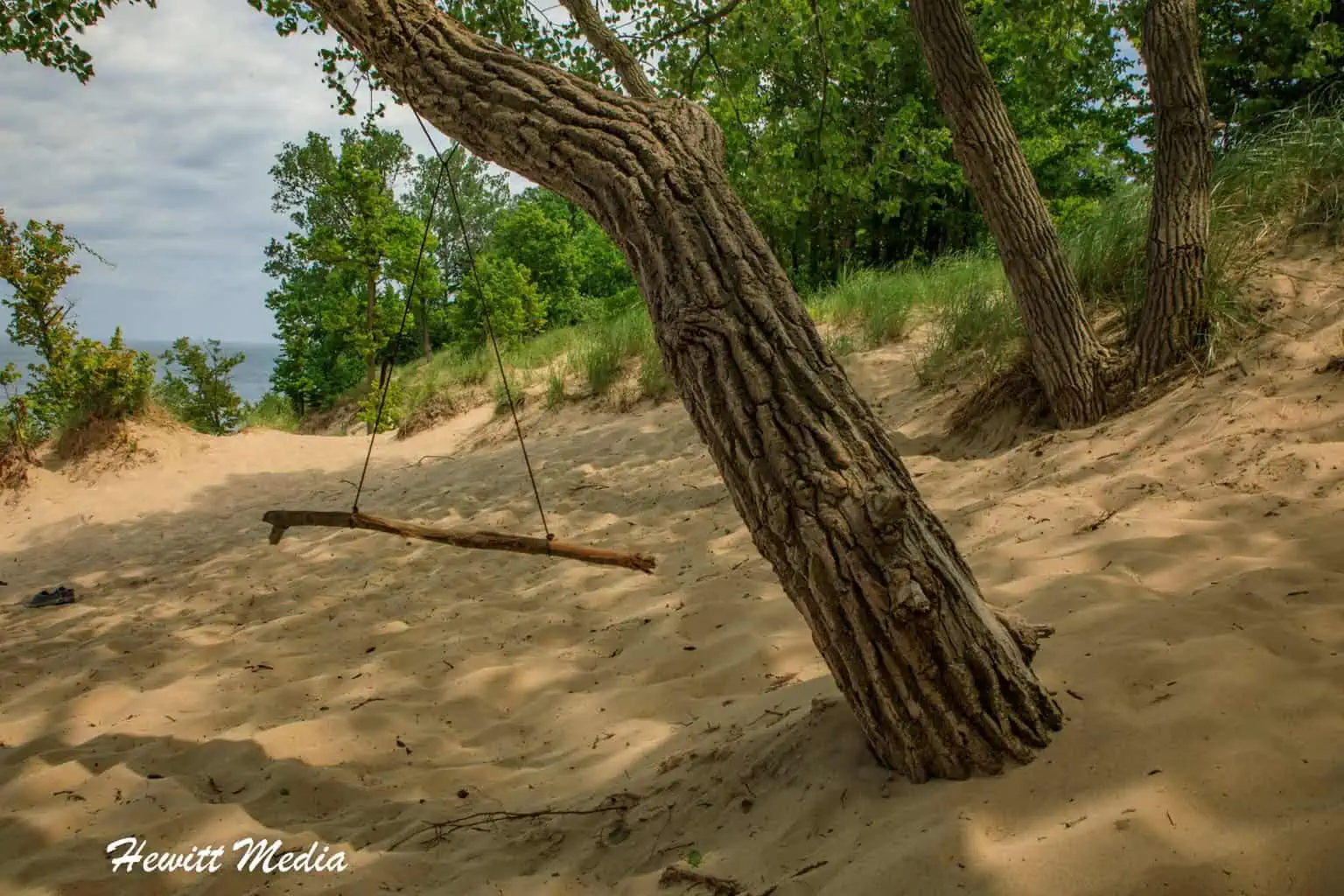
If you are into the outdoors, then there will be no shortage of things for you to see and do in Indiana Dunes State and National Parks. Whether you are into hiking, boating, biking, swimming, or just hanging out on the beach, the parks have a little bit for everyone of all interests. In case you need some ideas for things to see and do while you are inside the parks, I have included a list of some of my favorites for you to review in my Indiana Dunes park guide below.
And if you are looking for some things to see and do in the surrounding region, I have you covered there as well. Below is a map and list of just some of the nearby attractions that you can add to any extended trip to the area.
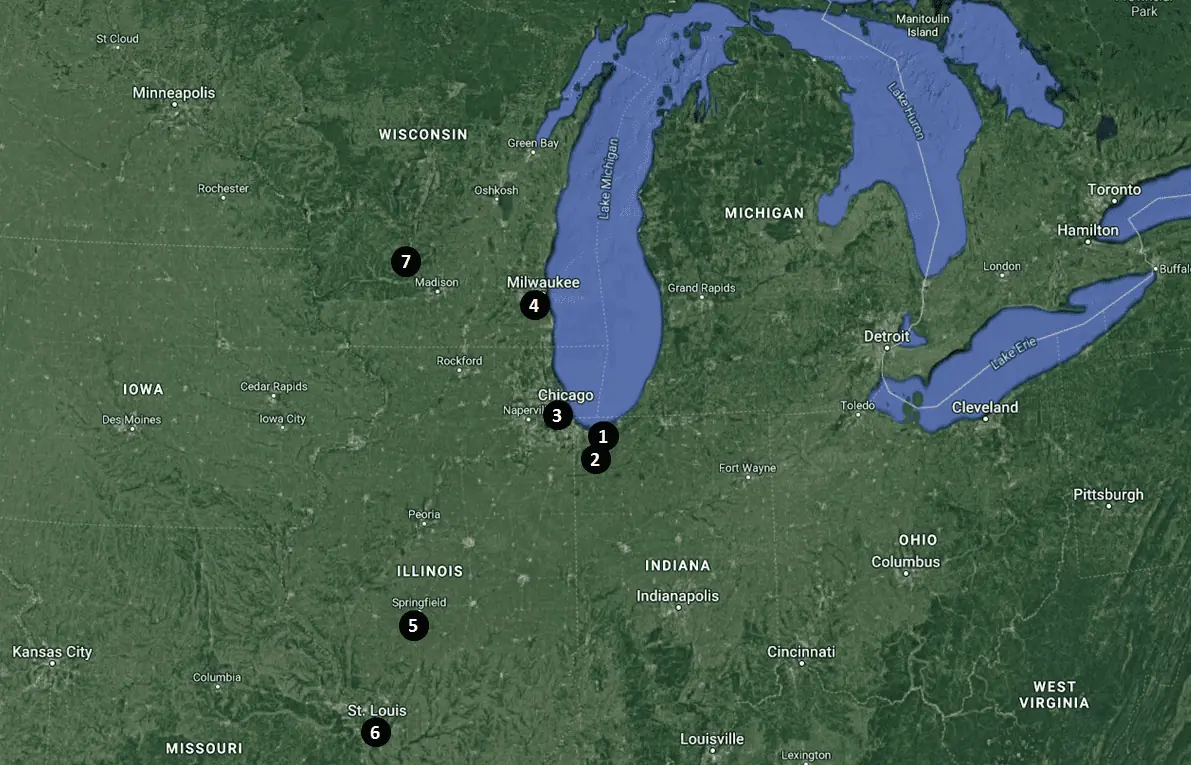
Hike the Sand Dunes in the State Park
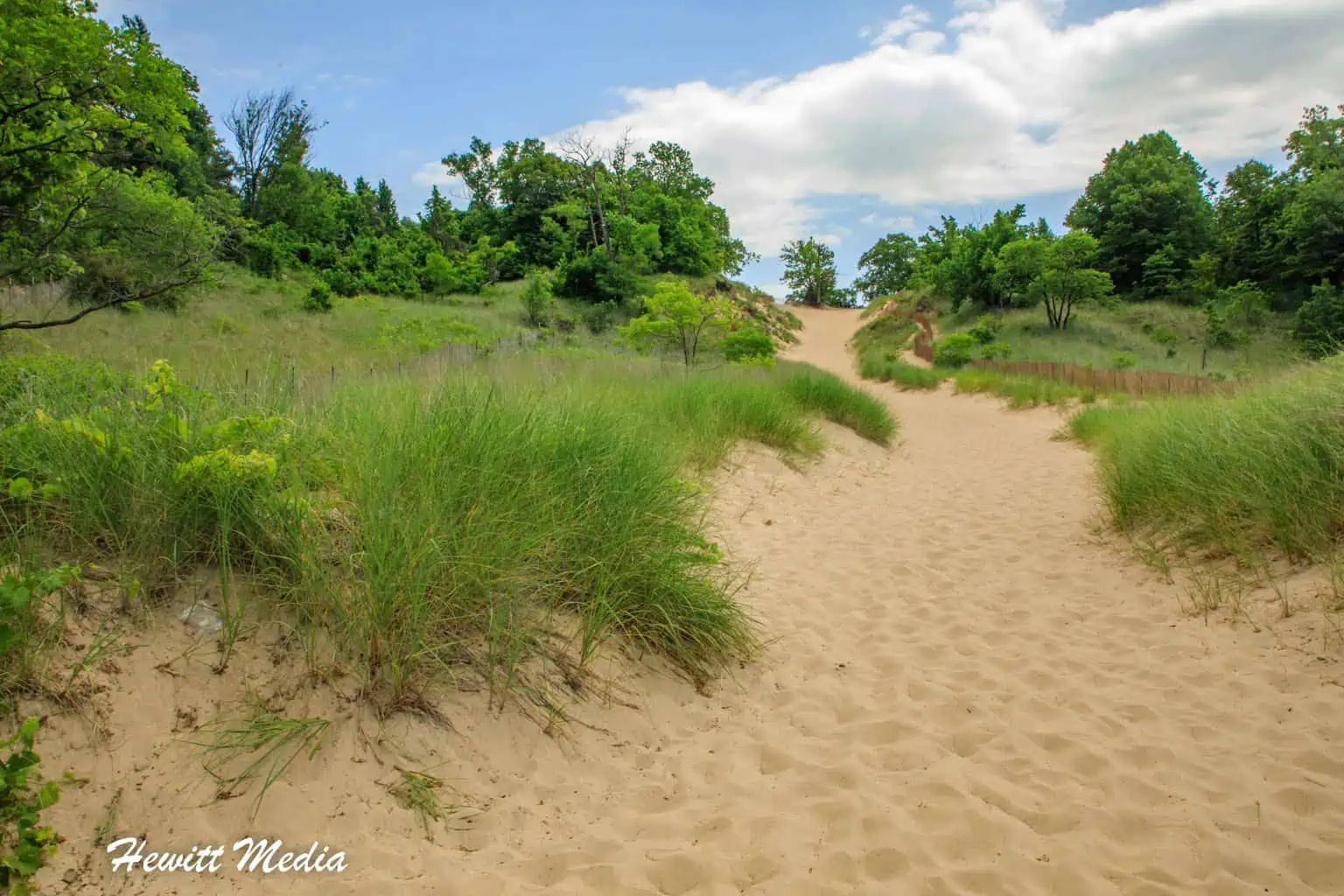
One of my favorite activities to do while in Indiana Dunes State and National Parks is to hike among the gigantic sand dunes. When you see the size of these dunes in person, it will absolutely blow your mind. In addition to being massive, they are also really pretty. However, make sure you bring lots of water with you on your hikes because hiking in loose sand can be a real workout.
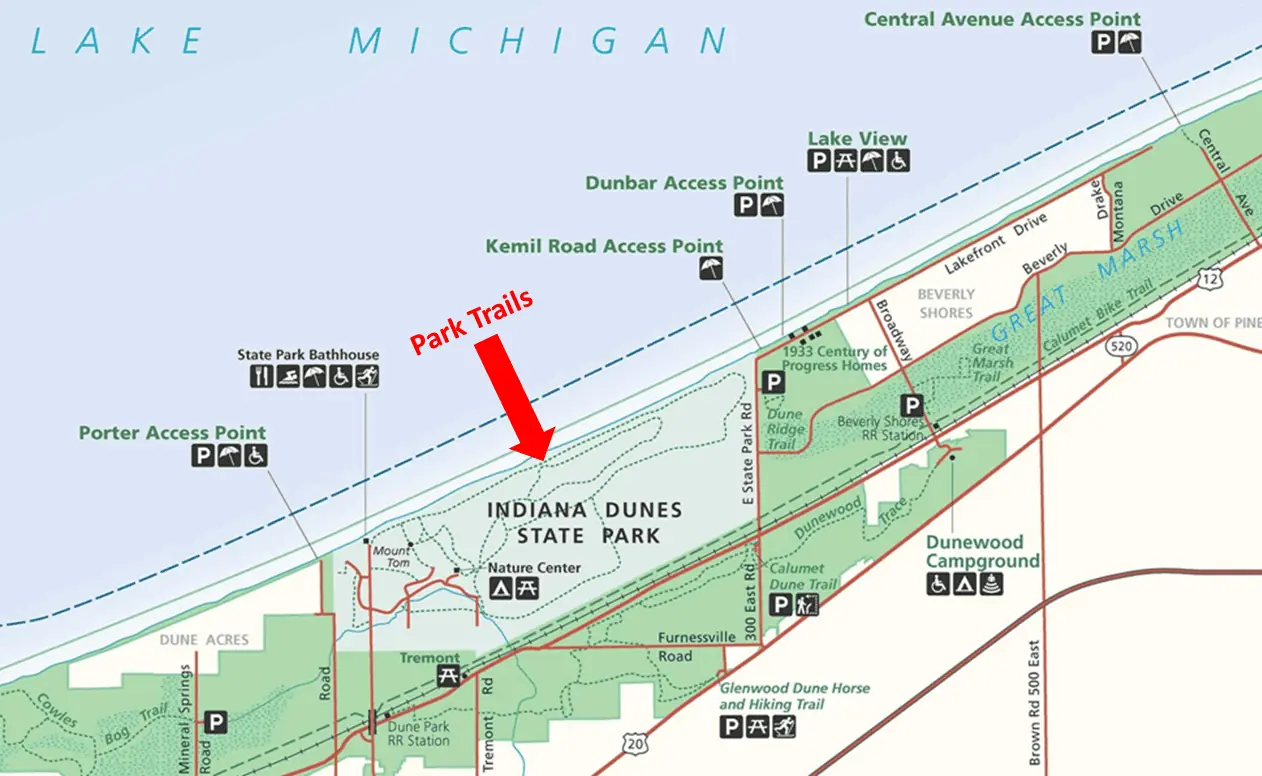
Hang Out at the Beach
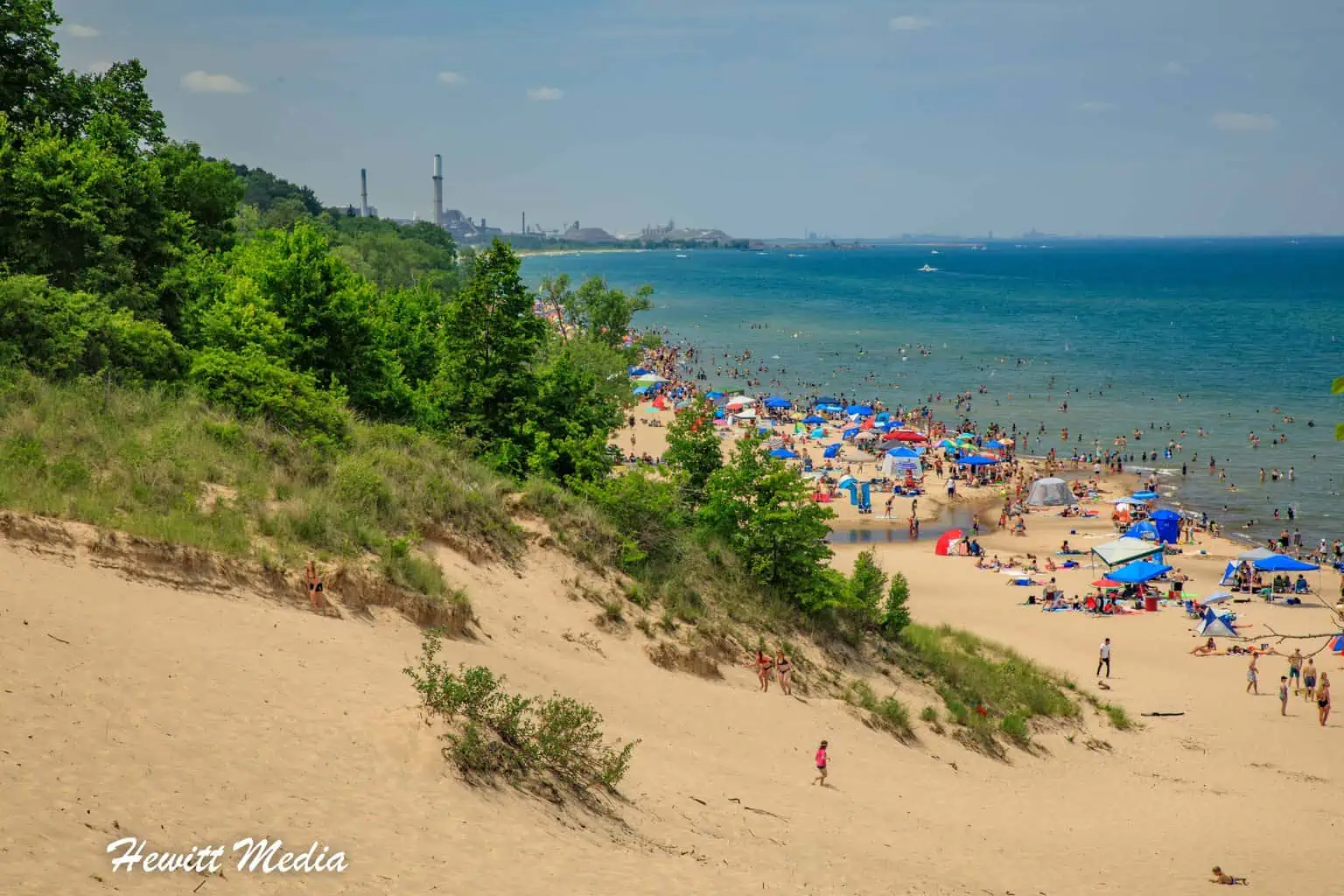
It should come as no surprise that a park that is known for its coastal sand dunes has amazing beaches, but I think a lot of people are surprised by just how big and beautiful the beaches at Indiana Dunes are when they first visit. Because the parks are located so close to the city of Chicago, I think many people don’t expect to see so much wild space set aside and don’t expect to see such pretty beaches.
Believe me, they are beautiful beaches. If you would like to spend some time relaxing on one of the many stunning beaches, I have included a map of the most popular beaches in the parks for you to review below.
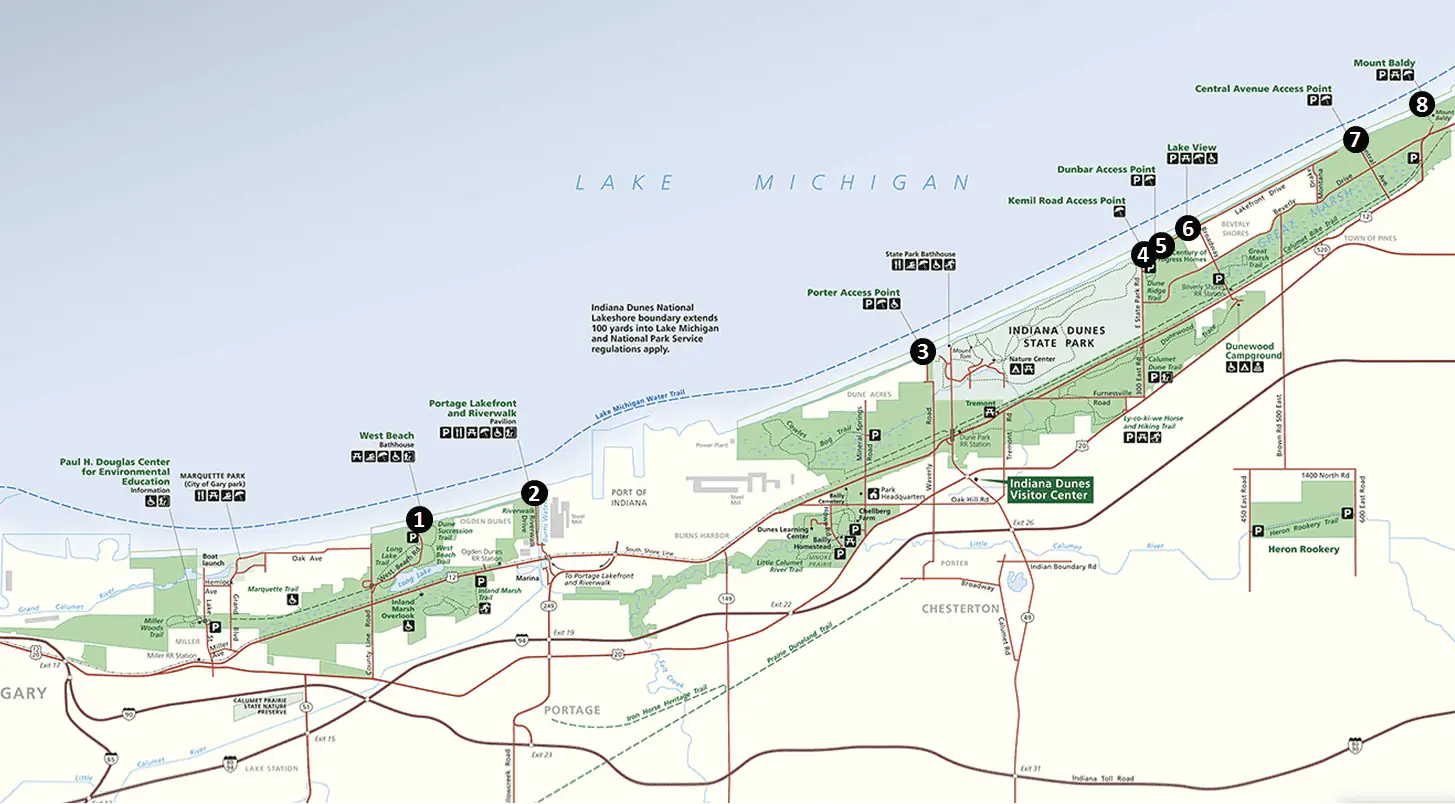
Visit the Nature Center
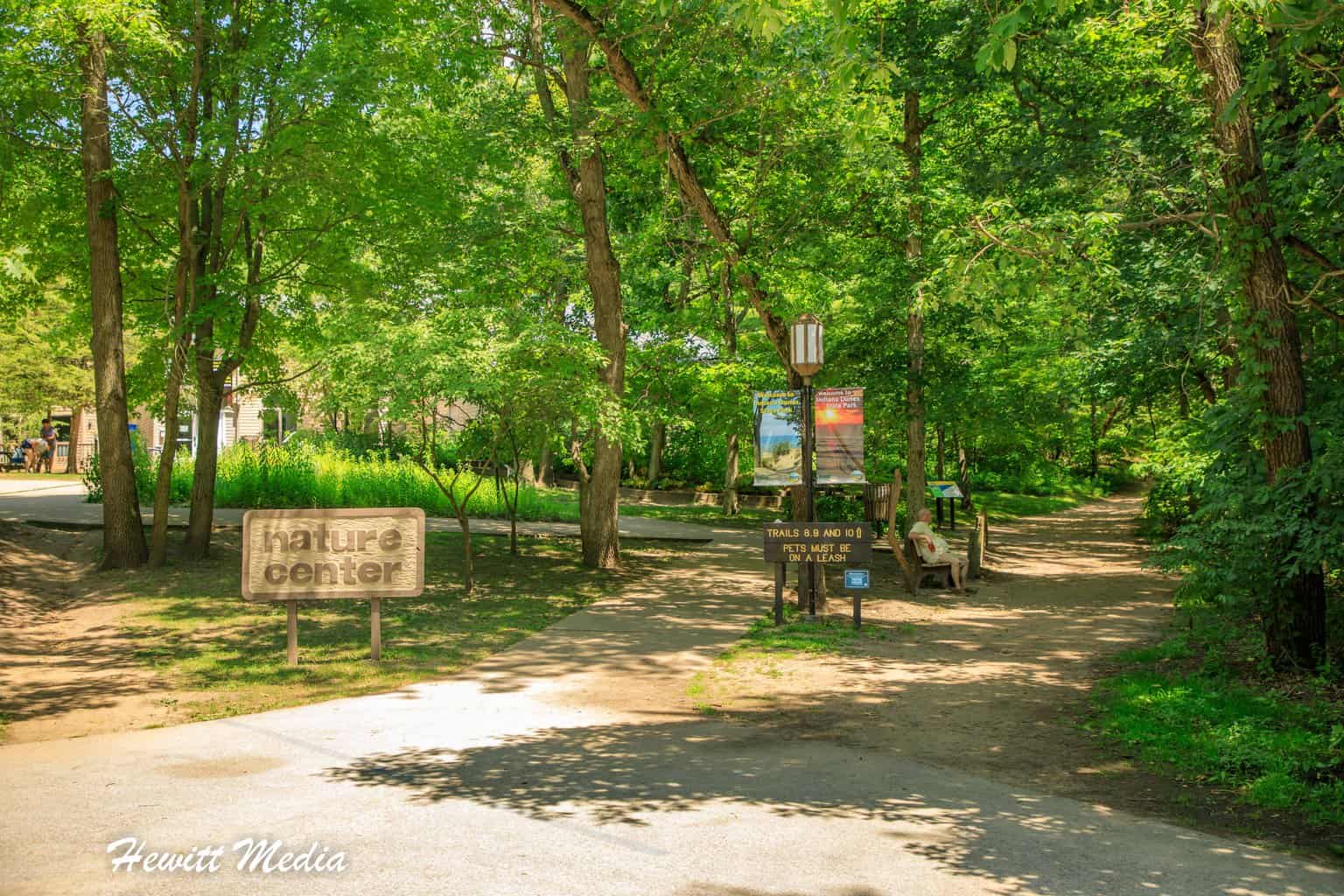
Another great thing to do in the Indiana Dunes State Park, especially if you are visiting with children, is to visit the Nature Center. The educational displays and learning programs teach you about all of the animal and plant life that is native to the dunes of Indiana Dunes State and National Parks. It is definitely worth checking out on your visit to the parks.
Do the Three Dunes Hiking Challenge

My favorite activity in the parks, by far, is the Three Dunes Challenge hike inside Indiana Dunes State Park. This roughly 1.5-mile hike may seem like a fairly easy hike, but it consists of hiking up three of the park’s tallest sand dunes.
While these dunes aren’t extremely high when compared with mountains in other parks, the fact that you are hiking up loose sand makes the hike really challenging. Not only is it rewarding to finish the hike, but when you make it to the top of each of the dunes the views are quite rewarding as well.
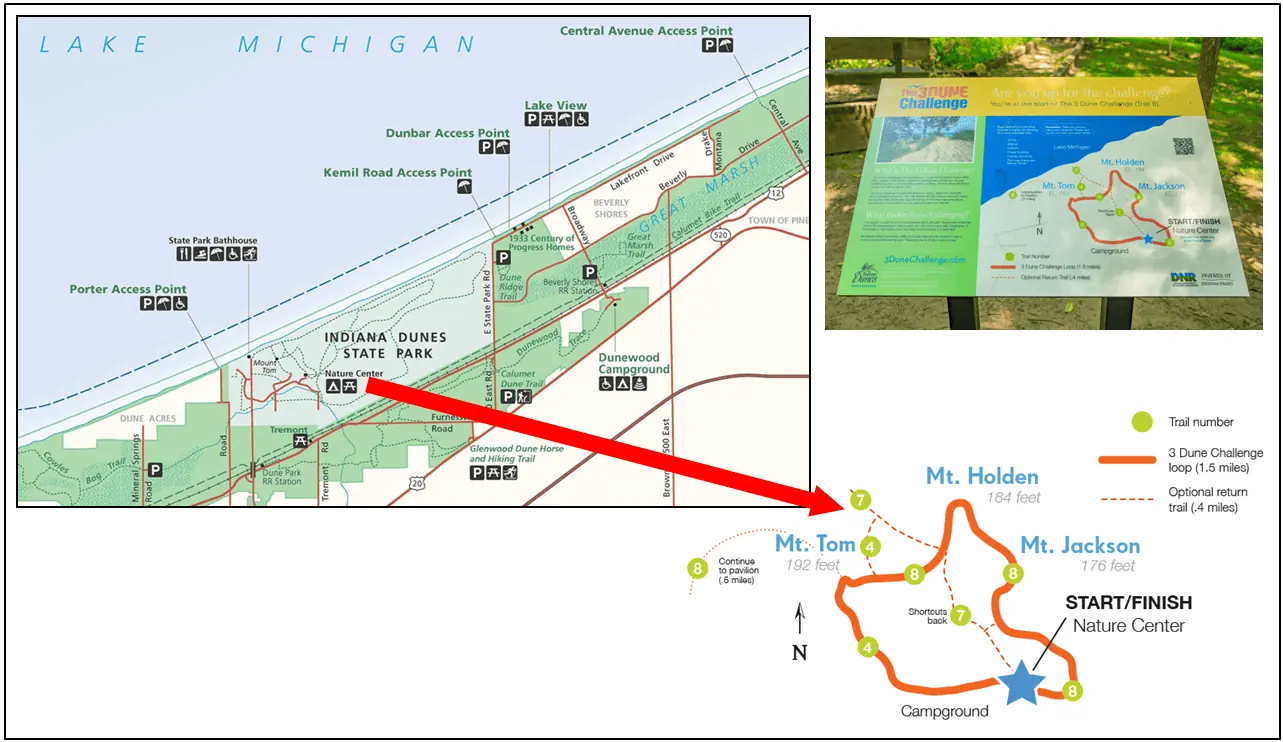
View Larger Image
Hike the Dunes Succession Trail in the National Park
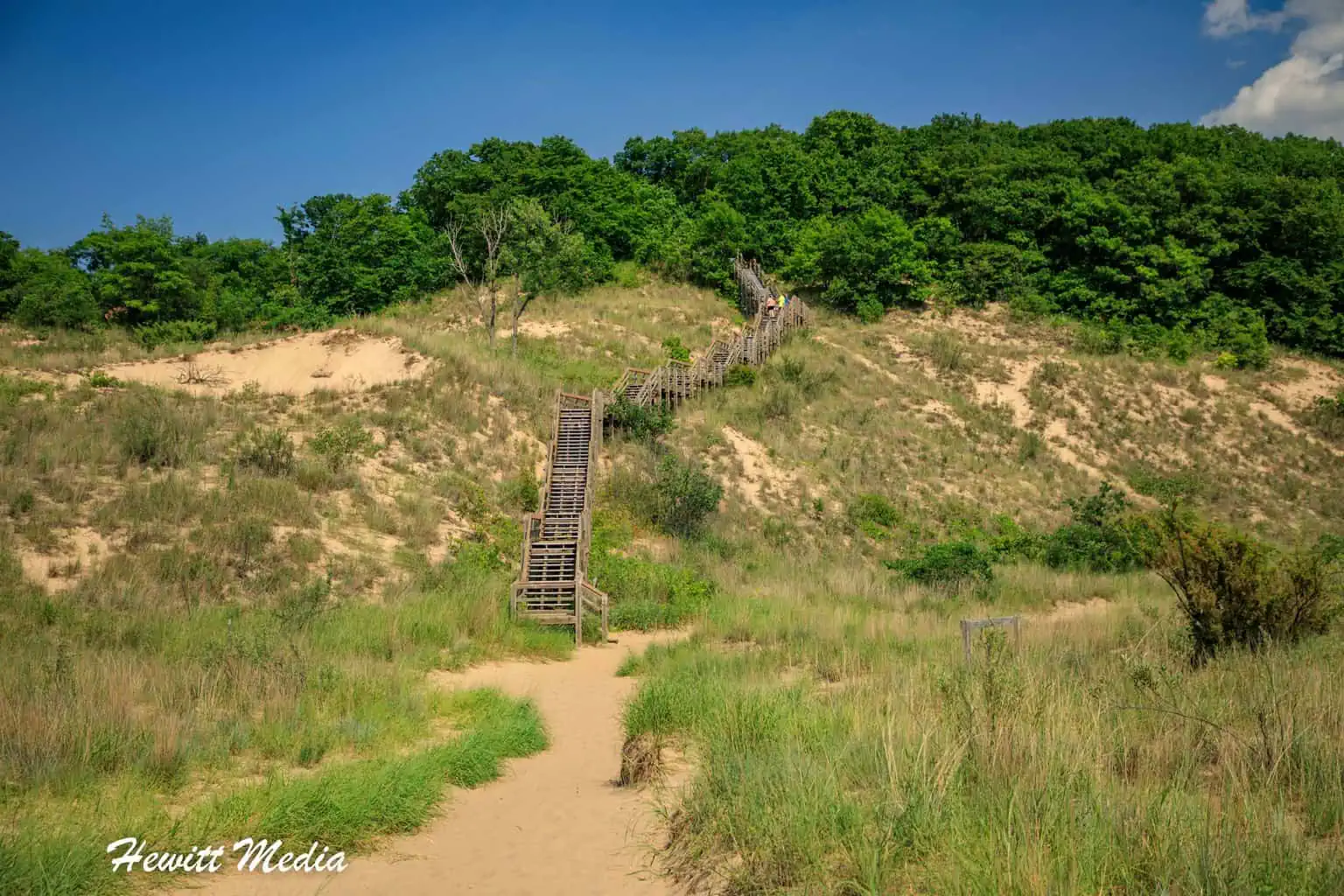
While the Three Dunes Challenge hike is probably my favorite hike within the entirety of the state and national parklands at Indiana Dunes, my favorite hike within the national park area is the Dunes Succession Trail near West Beach. Unlike the state park area of Indiana Dunes, you aren’t allowed to hike on much of the sand dunes in the national park areas. The dunes have been closed off to better protect and preserve the delicate dunes.
However, that doesn’t mean you can’t hike among the dunes and enjoy them. The Dunes Succession Trail meanders through some of the prettiest areas of the dunes near West Beach and offers some absolutely stunning views of Lake Michigan and beautiful West Beach. In my opinion, no trip to Indiana Dunes is complete without hiking the Dunes Succession trail and enjoying this beautiful area.
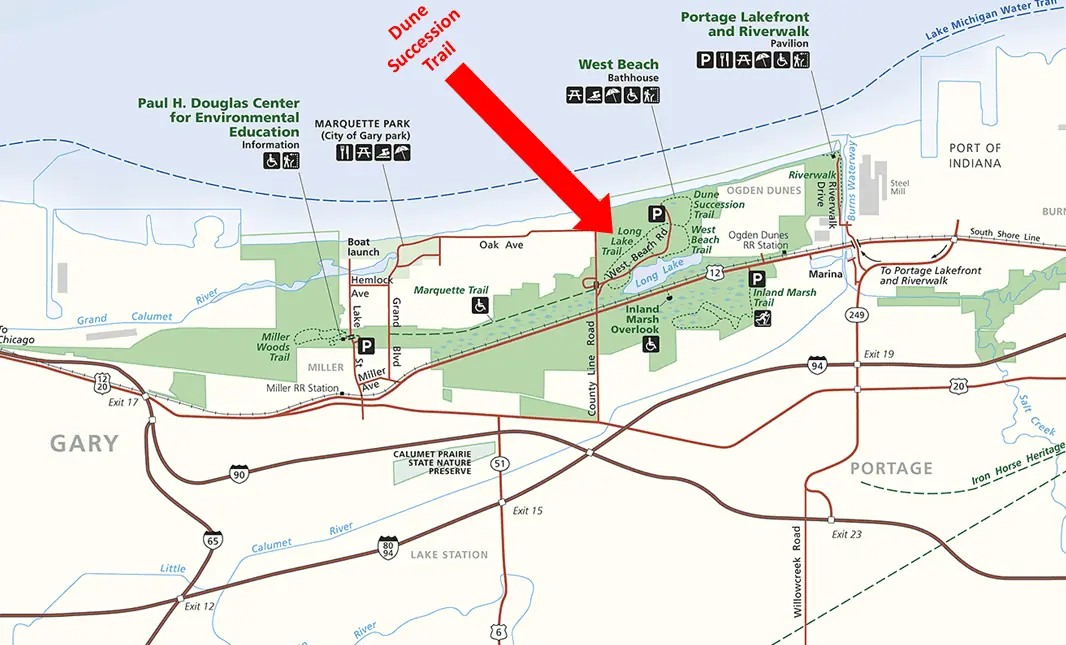
Best Times to Visit Indiana Dunes
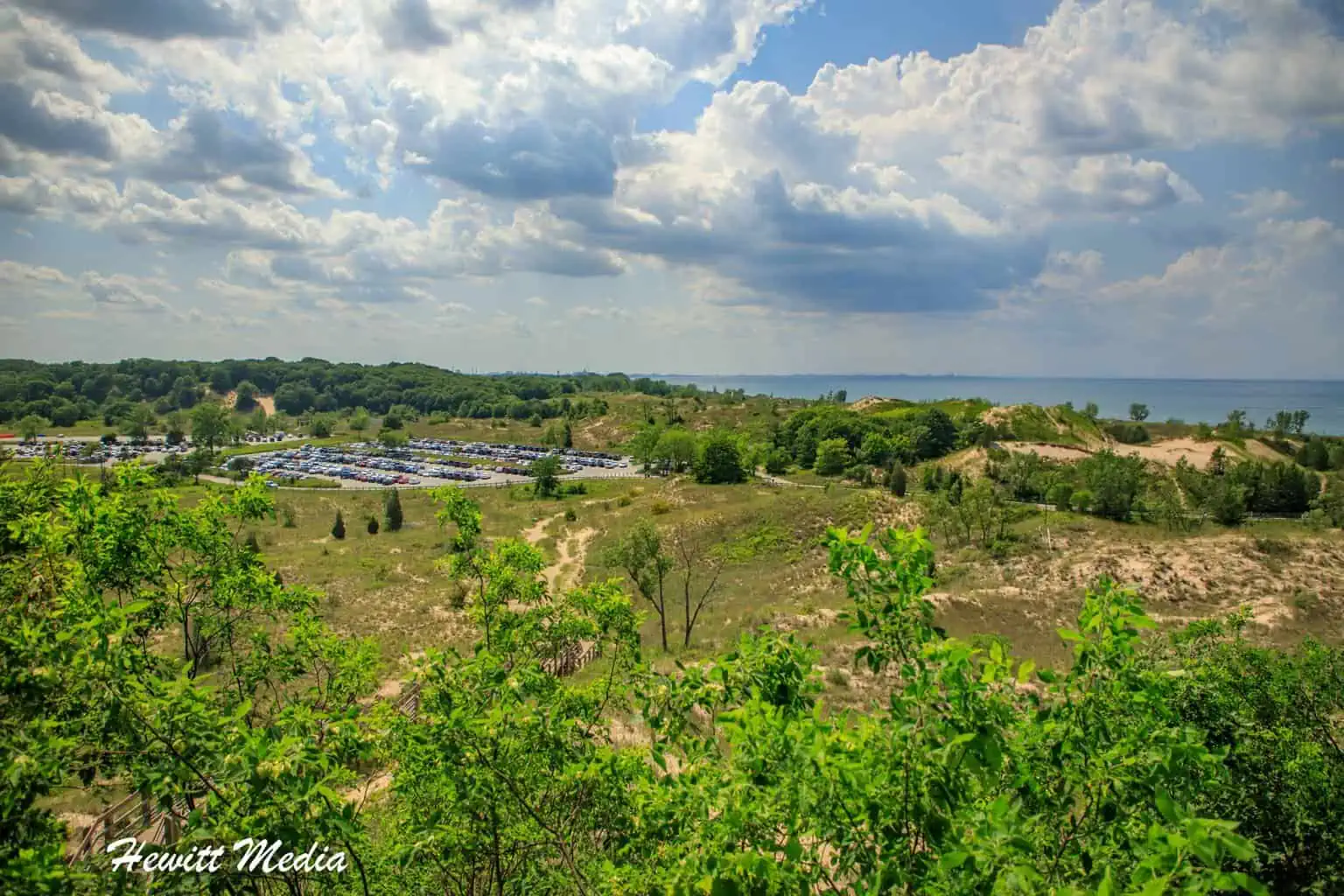
Because the biggest draws of Indiana Dunes State and National Parks are the lakeside sand dunes and the beautiful beaches, it should come as no surprise that the best time to visit the parks is during the summer months. To give you a better understanding of the weather that Indiana Dunes experiences throughout the year so that you can better determine when it would be best for you to visit, I have included some data on the average temperature and precipitation throughout the year below for you to review.
Average Temperature (°F)
If you are visiting Indiana Dunes to enjoy the beaches and the water, then you are going to want to plan your visit from May through September. The end of May through the beginning of September typically sees the warmest temperatures and thus the best beach weather.
However, if you are just visiting to hike the dunes and explore the wilderness areas away from the coastline, then you might be better off avoiding the hot and crowded summer months and aiming to visit in late spring or early autumn instead. The months of April and October typically have milder temperatures that are ideal for hiking and the parks are far less crowded than they are during the summer months.
Average Amount of Precipitation (Inches)
If you are going to be visiting Indiana Dunes to enjoy the beach and the water, then you are going to want to try and plan your visit for when you have the best chance of seeing sunshine. Unfortunately, the months that see the very least amount of rainfall at Indiana Dunes are also some of the coldest months of the year (January and February).
Beginning in the Spring months of March and April, the area starts to see more rainfall and that continues into the summer months. However, starting in mid-July through the end of August, the area does start to dry out a bit more. If you are looking for the ideal time of year to enjoy a warm and dry visit at Indiana Dunes, I would definitely recommend planning your trip during this time.
Where to Stay Near Indiana Dunes
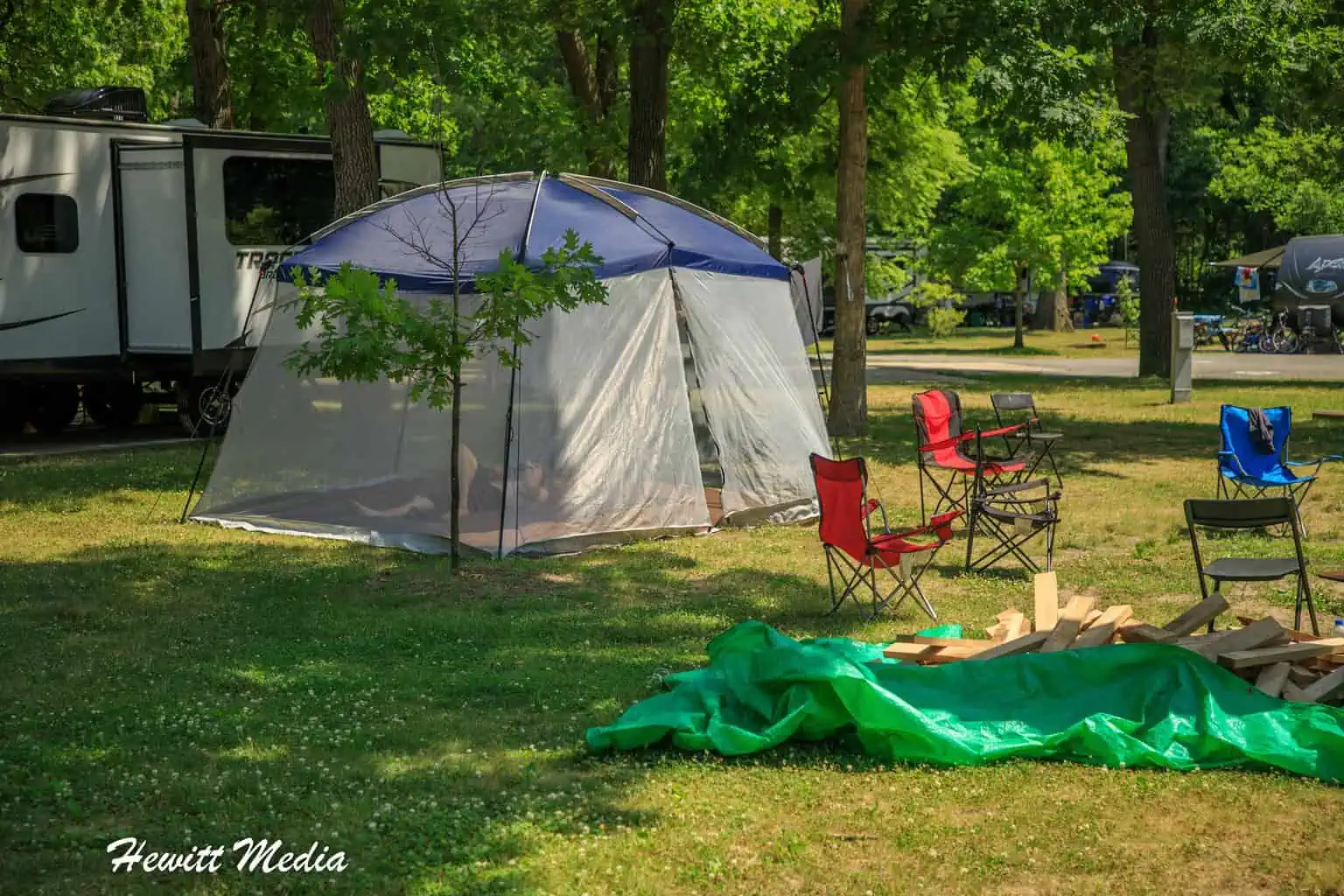
If you want to fully enjoy the outdoor experience and go camping while you visit Indiana Dunes State and National Parks, there are several great campsites that you can stay at in the area of the parks. If you are interested in finding a campground, I have included a map below that highlights some of the more popular campgrounds in the area.
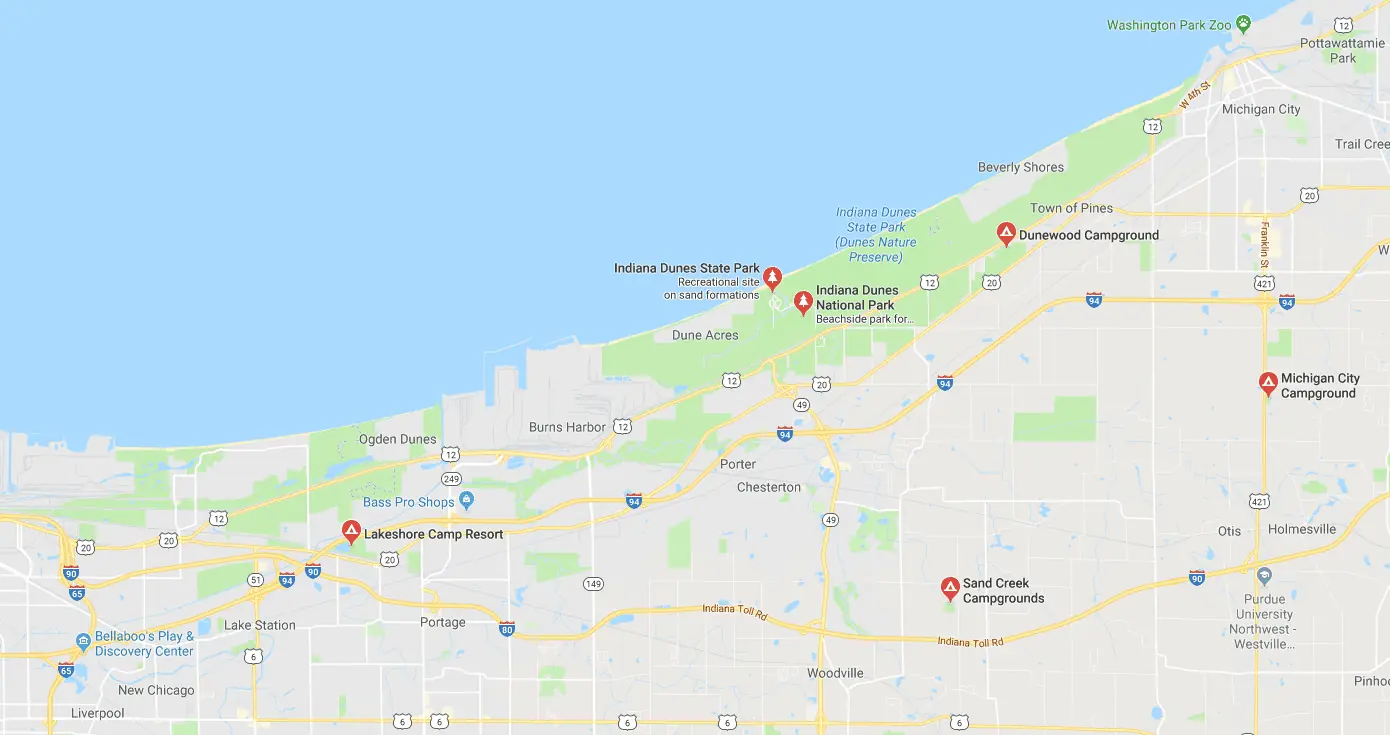
If you would like to enjoy the parks, but aren’t all that interested in camping, there are also plenty of hotels in the area of the parks for you to stay at as well. The closest city with the most reasonably priced hotels is Michigan City, Indiana. If you are interested in finding a hotel for your trip to Indiana Dunes, I have included a list of hotels at various price points for you to review below.
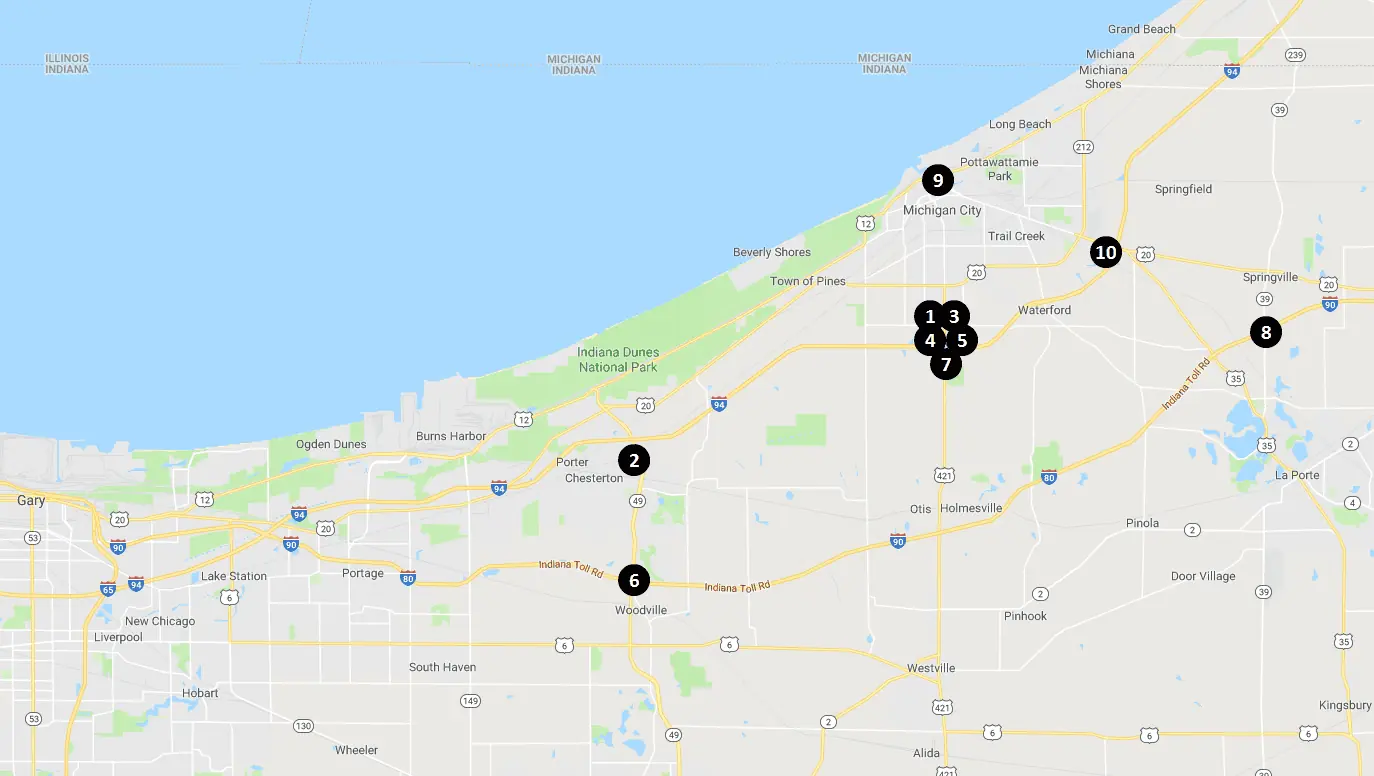
Where to Eat Near Indiana Dunes
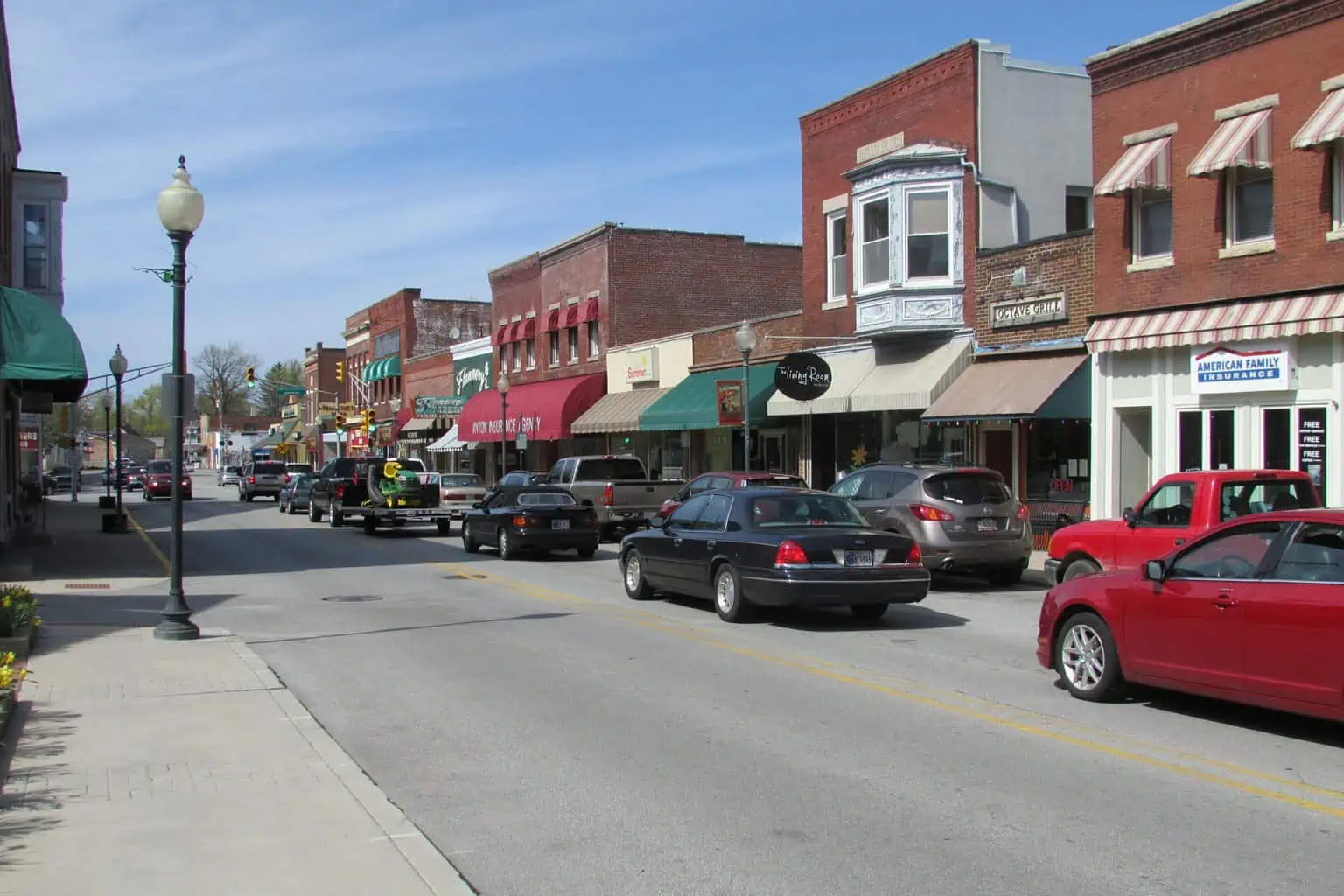
Because I am recommending that you stay in Michigan City if you are going to be looking for a hotel for your trip, I am also going to focus on Michigan City for the restaurant recommendations that I am going to give you. Michigan City is a decent-sized city with several great restaurant options. If you are looking for a good restaurant recommendation while you are visiting Indiana Dunes, below is a list of some of the most recommended restaurants in Michigan City on TripAdvisor for you to review.
Hiking in Indiana Dunes
Hiking the sand dunes in Indiana Dunes was one of my favorite experiences during my visit to the parks. If you would like to get a sense of what that experience is like, I have included a short video that you can watch below.
Indiana Dunes Photo Gallery
Indiana Dunes State and National Parks are some of the most beautiful parks in the Midwest United States. It was an absolute joy to be able to visit and photograph these beautiful parks. Below is a gallery of just some of my favorite pictures that I took during my visit.
If you would like to see more of my travel photography, I would also encourage you to give me a follow on Instagram . Putting this blog together to pass on my free guides, itineraries, and travel photography tips is a lot of work and your support in the form of a follow-on Instagram would be so very much appreciated!
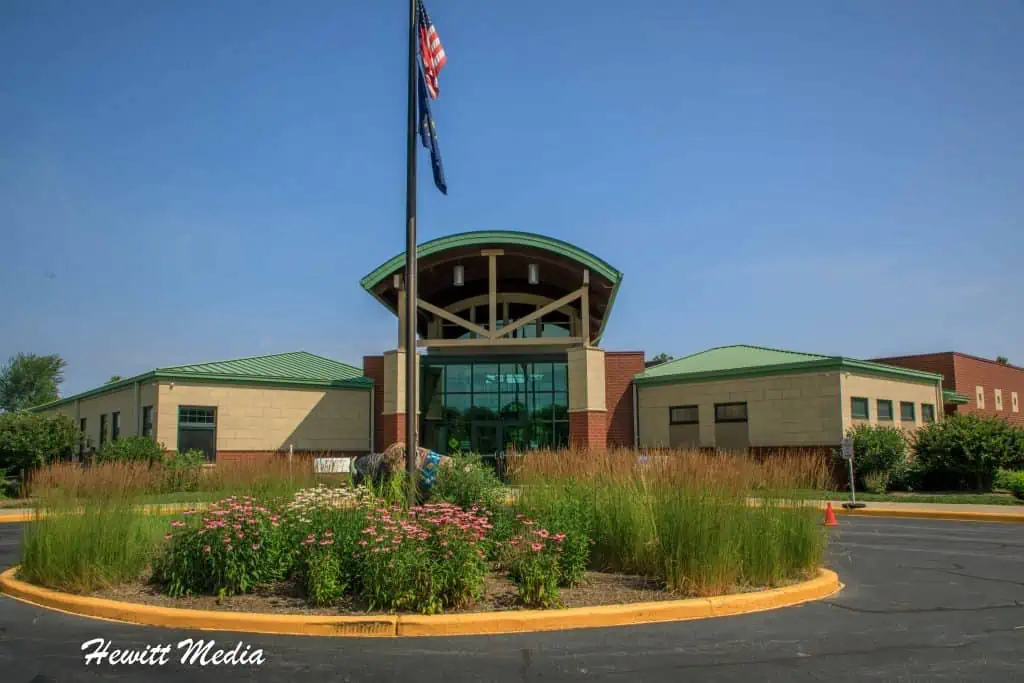
Don’t Forget to Subscribe to My Adventures!
Type your email…

Let Me Help You Save On Your Next Adventure!
Published by Josh Hewitt
Avid traveler and photographer who loves to see new places, meet new people, and experience new things. There is so much this world can teach us, we just need to explore! View all posts by Josh Hewitt
Related Articles

How to Safely Take on a Multi-Day Road Trip

Unforgettable Adventures: Top 30 Things to Do in New Zealand

Uncovering the Magic: The 50 Most Incredible Castles in the World
2 comments ›.
It looks nice, and it’s close enough that I can actually go in the off-season. It’s a miracle! Thanks for the thorough and well-presented info!
It’s such an underrated park 😀👍
Leave a Reply Cancel reply
Discover endless entertainment with KheloYar, the go-to platform for online gaming enthusiasts. Offering a diverse selection of games, from fantasy…
Hi Michael. I would walk in with you wide angle on your camera and have your 100-500 in your bag.…
Heading to Peru in a week. I was going to take my wide angle plus 100-500 lens. Is there a…
Discover more from Wanderlust Travel & Photos
Subscribe now to keep reading and get access to the full archive.
Continue reading

Subscribe To My Adventures!
- Search Please fill out this field.
- Newsletters
- Destinations
- United States
Indiana Dunes National Park: The Complete Guide
:max_bytes(150000):strip_icc():format(webp)/SBP89375copyWEB-d65242d5b8cf41e394635f6980b98b8e.jpg)
Things to Do
- The Best Hikes & Trails
Where to Camp
Where to stay nearby, how to get there, tips for your visit.
Indiana Dunes National Park is a sandy landscape full of dunes, wetlands, prairies, and forests covering 15,349 acres of diverse ecosystems. The park in northwest Indiana, formerly called Indiana Dunes National Lakeshore, stretches for 15 miles along the shore of Lake Michigan. Expect to see plenty of creeks and rivers, dune ridges, and a plethora of rare plants like Mead’s Milkweed, Pitcher’s Thistle, Shooting Star, and Virginia Snake Root.
Visitors come to this park to hike and bike on the trails, swim in the lake, relax on the sandy beach, and camp overnight with their friends and family. Begin your adventure in the Indiana Dunes Visitors Center where you’ll find informative videos about the park, a bookstore and shop, and park rangers that can tell you about what to look for on the day of your visit.
Indiana Dunes National Park is a year-round outdoor destination for nature lovers. Hiking and swimming are best enjoyed in the warmer months while cross-country skiing and snowshoeing are fun to try in the winter. Sunsets are worth viewing any time of year. The Calumet and Porter Brickyard Bike Trails are breathtaking in the fall when the leaves from deciduous trees are changing color. Spring and fall are also when birds are migrating so be sure to bring your gaze to the skies as well as the many bird boxes you’ll see throughout the park.
Whether you’re a tent or RV camper, there are plenty of places to call home for the night from April 1 through Oct. 31 at the Dunewood Campground . Be sure to bring your fishing poles and cast a line in the Little Calumet River or off the Portage Lakefront fishing pier.
Several annual events and planned activities occur throughout the year. The Indiana Dunes Outdoor Adventure Festival is a celebration tailor-made for bird watchers, bikers, fishers, hikers, and paddlers. Regularly occurring family-friendly outings include the Mount Baldy Summit Hike, Ranger’s Choice Hike, and Sunset Around the Fire at the Pavilion. Be sure to check the park’s website or Facebook page to be up to date on other fun happenings.
The Best Hikes & Trails
You can spend days hiking the 50 miles of diverse trails in this national park on 14 different trail systems. Make sure you grab a paper map in the visitor’s center or the Paul H. Douglas Center for Environmental Education . Maps are often available at the trailheads but don’t rely on this. Be sure to bring plenty of water and snacks with you as well as sun protection. Sturdy hiking shoes are a must, especially if you’re planning on hiking a challenging route. Most of the trails are moderate in terms of difficulty but you can find a few easy and difficult trails as well. Below are recommended trails to experience while you’re in the park.
- Bailly Homestead, Chellberg Farm, Little Calumet River, and Mnoké Prairie Trails: This hike is rated as easy to moderate and is 3.4 miles in length. You’ll wander through beautiful maple, beech, basswood, and oak trees before reaching the Little Calumet River, a restored prairie, and the Bailly Homestead and Chellberg Farm.
- Cowles Bog Trail: For a more challenging adventure, that is a great representation of the park’s ecosystems, tackle this 4.7-mile trail that meanders through black oak savannas and alongside ponds, marshes, swamps, and beaches.
- Dune Ridge Trail: Bring the family on this 0.7-mile moderate hike that will take you through wetlands and diverse forest landscapes. You’ll love the views and have plenty of places to rest as you make your way to the end of this short trail.
- Glenwood Dunes Trails: Bring plenty of water and sun protection as you venture out on this trail, which is 6.8 miles in length. You’ll likely pass other hikers, runners, and folks on horseback as you make your way on this moderate path.
- Heron Rookery Trail: For an easy trail that is ideal for multigenerational families, set out on this 3.3-mile hike, which meanders along part of the Little Calumet River. If you’re a spring hiker, you’re in for a real treat as there is a huge display of wildflowers in these woods.
- Mount Baldy Beach Trail: Steep and short, this 0.75-mile hike is more of a climb as you’ll have to contend with loose sand to make your way to Mount Baldy Beach. Bring along a picnic, if you can carry one, and enjoy it at the end of your adventure to celebrate.
- Tolleston Dunes Trail: Of course, you’re going to want to see the dunes on full display while out and about in this national park. This moderate hike, which is 2.9 miles in length, snakes around diverse ecosystems ranging from savannas to wetlands to prairies. Bonus: there’s a separate wheelchair-accessible trail that leads to an observation lookout, complete with picnic tables.
- Dunewood Campground : This site is a great home base while you’re visiting the park, open April 1 through Nov. 1. There are two loops with 66 campsites. Each loop has restrooms and showers as well as a few wheelchair-accessible sites. Lakewood Beach is only 1.5 miles north of the campground.
- Indiana Dunes State Park Campground : Located less than a mile from the beach, this campground has an excellent location. With full electrical hookups, restrooms, and showers, this campground fills up quickly and must be booked well in advance to secure a coveted spot.
- Lakeshore Camp Resort : If you like a campsite with loads of amenities and nice accommodations, then this is the spot for you. This membership park has 125 full hookup campsites as well as 12 cabins for the general public. Located 10 miles from the park, this one is a bit further, but the lake, outdoor swimming pool, water slides, arcade, and mini-golf offerings make it worth the drive.
- Sand Creek Campground : Call and reserve your spot at this campground, which offers the classic camping and RV experience. Roast marshmallows around the fire pit, and take advantage of full electrical and water hookups.
If camping isn’t your style and you’re without an RV, you’ll need nearby accommodations. Luckily, there are many options to choose from, within a variety of price points.
- Spring House Inn : Affordable, well-reviewed, and near the park, this inn is ideal for those who are looking for a place to rest their heads without breaking the bank. Enjoy the indoor heated pool and complimentary breakfast. This woodsy haven is family friendly with a casual atmosphere and you can even borrow board games or books.
- Bridge Inn : Somewhat quirky, this colorful hotel is located in Michigan City near plenty of restaurants, shops, and beaches. You’ll be within walking distance to the marina, public beach, and Washington Park and Indiana Dunes National Park is just a short car ride away.
- DunesWalk Inn at the Furness Mansion : For accommodations that are more upscale, consider renting a room or the entire mansion. The inn sleeps 19 guests, within two suites and three guest rooms, allowing you to bring your multigenerational family. You’ll be minutes from the beach and all that Indiana Dunes National Park has to offer.
The easiest and most practical way to get to the park is by car via Interstate 94 (take exit 26 north); the Indiana Toll Road, on Interstate 80/90 (take exit 31 north); U.S. Highways 12 and 20; or Indiana State Road 49, where the Indiana Dunes Visitor Center is located. There are signs throughout the park directing you to various points of interest.
For public transportation, the South Shore Railroad has stops by the park. There are also taxi and ride-hailing services, however, this mode of transportation isn’t recommended as you’ll need to get around the park and be able to explore at your leisure. Be sure to review the park's many maps to find specific beaches, hiking and biking trails, horseback riding paths, and the visitor center.
- Pets are welcome at specific locations throughout this park. Check out the B.A.R.K. Ranger Program where your pet can join a pet-friendly hike and earn a special dog tag.
- Indiana Dunes is home to a state and a national park so there are separate admission requirements for each. Indiana Dunes National Park doesn’t have an entrance fee while the Indiana Dunes State Park charges a daily fee of $7 for in-state residents or $12 for out-of-state residents.
- Year-round educational programming can be found at the Paul H. Douglas Center for Environmental Education . Take advantage of ranger-led hikes, informative exhibits, wildlife talks and exhibits, and the kid-friendly Nature Play Zone.
- Plan ahead with the park’s Trip Ideas . There are full itineraries for brief visits or longer excursions in the park. Learn about what the park’s rangers recommend and craft an adventure that fits in your specific time frame.
Related Articles
More related articles.
National Geographic content straight to your inbox—sign up for our popular newsletters here

The frozen expanse of Lake Michigan crowds against shoreline dunes at Indiana Dunes National Park.
See soaring sand dunes in America’s newest national park
With some of the country’s greatest biodiversity and recreation, Indiana Dunes National Park packs a punch.
Location: Indiana
Established: february 15, 2019, size: 15,067 acres.
After 53 years as Indiana Dunes National Lakeshore, the southern shores of Lake Michigan were renamed the United States’ 61st national park. Fifteen miles of beaches give way not only to impressive sand dunes and blowouts, but marshes, wetlands, groves of black oak savanna and maple sugar trees, and fields of wildflowers that come and go with the seasons.
Don’t let its small size and recently upgraded designation deceive you: Indiana Dunes National Park’s biodiversity ranks seventh out of all 400-plus National Park Service units—and the nation’s newest park sees nearly as many visitors a year as Mount Rushmore . Here’s how to make the most of your trip.
Hit the dunes
Indiana Dunes National Park sandwiches Indiana Dunes State Park, where you can find the area’s three tallest dunes: Mount Tom (192 ft), Mount Holden (184 ft), and Mount Jackson (176 ft). Trails 8, 9, and 10 are arguably the definitive trails of the area, showcasing dune blowouts, “tree graveyards,” and forests of white pine rising above Lake Michigan. Trail 8 is the shortest route to summit each dune, otherwise known as the Three Dune Challenge.
The national park, however, lays claim to the most dynamic dune: Mount Baldy . It’s slowly eroding, or “starving,” moving roughly four feet a year. The trail to its top is regularly closed; if it’s open during your visit, go. Similarly impressive is the nearby Dune Ridge Trail —a route that takes you up above Kemil Beach and the Great Marsh—and the West Beach 3-Loop Trail , a 3.4-mile loop that displays all stages of dune development, with views that often extend to the Chicago skyline.
Most trails can be tackled on snowshoes or cross-country skis come winter, and they’re usually well-marked with wildlife tracks after any recent snowfall. Bikers should note the Calumet Bike Trail , running all the way from Mineral Springs Road to Mount Baldy.
On the water
The majority of the park’s annual visitors come for the swimming and beachcombing. Lake View, Kemil, Dunbar, and Porter beaches are all swim at your own risk, with smaller parking lots that fill up quickly in summer. West Beach (the only lot that charges, at $6 per car) has showers and lifeguards. On any beach day, consider scoping out the Portage Lakefront & Riverwalk , an impressive, eco-friendly pavilion with basic amenities and water access.
For paddlers, there’s also the 35-mile Lake Michigan Water Trail . Bring your own kayak, hug the water’s edge, and camp at designated sites as you progress along the lake. For greater nature immersion, consider the Little Calumet River or Burns Waterway.
See the flora and fauna
Over a thousand native plant species and 370 bird species make this one of the most biodiverse swaths of land in the U.S. The Great Marsh Trail and the Heron Rookery are excellent places to birdwatch for tree swallows, rusty blackbirds, kingfishers, egrets, and green herons.
In the warmer months, check out the 4.7-mile Cowles Bog Trail —plant diversity is so outstanding here the area was designated a National Natural Landmark. The Tolleston Dunes Trail , another good option, winds 2.9 miles from oak savanna and wetlands into prickly pear cactus country.
Learn the history
The Port of Indiana looms on the horizon, a reminder that this area barely escaped industrialization. In fact, the once-largest dune, the Hoosier Slide, was carried off in boxcars as early as 1916. Activists fought to preserve the dunes; their eventual success resulted in today’s landscape, a study in contrasts.
Accessible by a 3.7-mile trail system, the Chellburg Farmhouse and Bailly Homestead provide vestiges of this pre-industrial past. Here, your path follows the Little Calumet River, skirting these two pioneer remnants (and a crumbling cemetery), passing through a forested ravine, and emptying into the oak savanna.
Related: Beautiful pictures of every U.S. national park

Just east of the border between the national and state parks, you’ll find something closer to modernity: five homes from the 1933 Century of Progress World’s Fair . You can spot them on a beach stroll or cruising down Lakefront Drive—tours are held annually, usually in fall. The Florida Tropical House, in its bubblegum-pink grandeur, is hard to miss.
Year-round tips
In the warmer months, come early. It’s not uncommon for cars to line up outside the entrance gates before they’re even open. Most parking lots fill by mid-morning, though West Beach rarely fills to its 600-space capacity.
Crowds dwindle with temperatures, and winter can mean you’re alone with the birds and the beavers. Watch the ice shelf float in and out as you stroll along an empty beach. For an off-season bonus, the state park regularly lifts its $12 entrance fee.
In an afternoon
The 1.1-mile Trail 7 in the state park division—next to the Nature Center —is the most direct route combining dune hikes with beach access. Time permitting, it crosses the longer Trail 8, which takes you to the top of the park’s tallest dunes.
Spend the next few hours inland and explore the Paul H. Douglas Trail , the Little Calumet River Trail, or the Great Marsh Trail, watching for wildlife and scouting for rare plants, like the gaywing or the carnivorous purple pitcher plant. Catch sunset at a larger beach, like Kemil, Dunbar, or West, and get your feet wet in the giant puddle known as Lake Michigan, left behind by the long-gone Wisconsin Glacier.
- Nat Geo Expeditions
Related Topics
- NATIONAL PARKS
- BIODIVERSITY
You May Also Like

How to plan the ultimate Adriatic coastal adventure in Montenegro's Bay of Kotor

Atlanta isn’t all that Georgia has to offer. Here are 7 other worthy trips.
Become a subscriber and support our award-winning editorial features, videos, photography, and much more..
For as little as $2/mo.

How to plan an epic summer trip to a national park

These are the 10 most popular national parks

Looking for a truly remote, off-the-grid adventure? Try Panama.

Some U.S. national parks are trying to go carbon-free. What does that mean for visitors?

How to visit Olympic National Park
- Environment
- Paid Content
History & Culture
- History & Culture
- Terms of Use
- Privacy Policy
- Your US State Privacy Rights
- Children's Online Privacy Policy
- Interest-Based Ads
- About Nielsen Measurement
- Do Not Sell or Share My Personal Information
- Nat Geo Home
- Attend a Live Event
- Book a Trip
- Inspire Your Kids
- Shop Nat Geo
- Visit the D.C. Museum
- Learn About Our Impact
- Support Our Mission
- Advertise With Us
- Customer Service
- Renew Subscription
- Manage Your Subscription
- Work at Nat Geo
- Sign Up for Our Newsletters
- Contribute to Protect the Planet
Copyright © 1996-2015 National Geographic Society Copyright © 2015-2024 National Geographic Partners, LLC. All rights reserved
Indiana Dunes National Park

- 1.1.1 Settlement
- 1.1.2 Preservation
- 1.1.3 National lakeshore and park
- 1.2 Landscape
- 1.3 Flora and fauna
- 1.4 Climate
- 1.5 Visitor information
- 2.2 By train
- 3 Fees and permits
- 4.1 By bike
- 5.1 Nearby attractions
- 6.1 Swimming
- 6.4 Bird watching
- 6.6 Horseback riding
- 6.7 Fishing & boating
- 10.1 Lodging
- 10.2 Camping
- 10.3 Backcountry
- 11 Stay safe
<a href=\"https://tools.wmflabs.org/wikivoyage/w/poi2gpx.php?print=gpx&lang=en&name=Indiana_Dunes_National_Park\" title=\"Download GPX file for this article\" data-parsoid=\"{}\"><img alt=\"Download GPX file for this article\" resource=\"./File:GPX_Document_rev3-20x20.png\" src=\"//upload.wikimedia.org/wikipedia/commons/f/f7/GPX_Document_rev3-20x20.png\" decoding=\"async\" data-file-width=\"20\" data-file-height=\"20\" data-file-type=\"bitmap\" height=\"20\" width=\"20\" class=\"mw-file-element\" data-parsoid='{\"a\":{\"resource\":\"./File:GPX_Document_rev3-20x20.png\",\"height\":\"20\",\"width\":\"20\"},\"sa\":{\"resource\":\"File:GPX Document rev3-20x20.png\"}}'/></a></span>"}'/>

Indiana Dunes National Park is a national park located in Northwestern Indiana . The only national park in Indiana, it's popular for its big sand dunes and plentiful beaches on Lake Michigan , and for its easily accessible location near Chicago . The park is also home to a variety of ecosystems including swamps and forests, with diverse plants and wildlife.
The history of Indiana Dunes National Park falls into settlement, preservation, and park segments.
Joseph and Monee Bailly, the fur traders, settled on the banks of the Little Calumet River in 1822. The wetlands of the Indiana Dunes proved to be a good place for contacts between the Bailly family and the Pottawatomie tribe of Native Americans. In 1822, the Pottawatomie nation had already developed an established lifestyle of duneland use, including the trapping of local beaver, raccoon, and muskrat.
After the Pottawatomie people were forcibly expelled from the Lake Michigan shoreline in the 1830s and 1840s, railroads built lines through the Indiana Dunes westward to the fast-growing city of Chicago; but the Dunes themselves, with their comparatively infertile soil, were settled relatively slowly.
Preservation
After the newly formed U.S. Steel Corporation began to construct a massive mill complex within the dunes at Gary, Indiana, lovers of the Dunes began efforts to preserve them. The National Park Service offered in 1916 to protect much of the remaining duneland as Sand Dunes National Park, but many locals opposed the proposal. In the 1920s, the state of Indiana preserved 2,182 acres of central duneland as Indiana Dunes State Park. Other sections of duneland were developed as the small communities of Ogden Dunes, Dune Acres, and Beverly Shores.
World War II and the early Cold War years increased pressure upon the United States to increase its production of steel. For reasons of economical coal and iron ore supply, one of the most efficient geographic locations to make steel within the United States is on the southern border of Lake Michigan. During the 1950s and early 1960s, several additional steel mills were sited within the dunelands in areas that could otherwise have been preserved for parkland.
After the former Bethlehem Steel Corporation acquired and built its Burns Harbor mill in 1962-64, a public outcry and pressure from activists, led by Sen. Paul H. Douglas (D-Ill.) led to the creation of the Indiana Dunes National Lakeshore, now the Indiana Dunes National Park.
National lakeshore and park

The Indiana Dunes National Lakeshore was created by Congress in 1966. But it owned no land of its own, and land acquisition opportunities were limited because of previous development. Many local residents were understandably opposed to federal condemnation. By the 1980s, much of the 15,000 acres of land making up the current National Park (as of 2006) had been acquired. The federal government included the Indiana Dunes State Park within the boundaries of the national lakeshore, but has allowed the state to continue to maintain and charge a separate admission fee to the state park.
By 2006, the lakeshore had come to include eight separate parcels of Lake Michigan beachfront land, as well as numerous parcels of property inland from the lake. Because the national park was founded after much of the drier land had already been developed, many of the inland parcels that make up the current park are riverbottoms or sandy wetlands.
In 2019, the National Lakeshore was reclassified and renamed a National Park, the first national park in Indiana.
The Indiana Dunes, of which the Indiana Dunes National Park preserves a part, are a relatively recent product of sand deposition, wave erosion, and wind erosion on the southern tip of Lake Michigan. During the warming process that ended the last Ice Age, the lake at several periods rose to levels much higher than the current lake level and laid down sandy shorelines and beaches at points that are now inland from the current coastline. Today's lake waves and currents continue to bring more sand ashore from beds underneath the surface of the current lake. This sand, further sculpted by wind and foot erosion, has become today's Indiana Dunes.
Flora and fauna

Many ecosystem types can be readily recognized by amateurs. Ecosystem types, and characteristic grasses and flowering plants, that exist within the Indiana Dunes include the following:
- Sand dunes - marram grass, prickly pear, puccoon
- Wetlands (bogs, marshlands, and swamps) - marsh marigold, skunk cabbage
- Ponds - bladderwort, gentian
- Prairies - black-eyed susan, butterfly weed, goldenrod, lupine, prairie grass
- Savannas - asters, prairie grass
- Dry woods - columbines, hepatica, Solomon's seal
- Wet woods - Dutchmen's breeches, hepatica, trillium, violet
The most common large tree in the Indiana Dunes is the black oak. There are also plenty of cottonwoods. Jack pines often grow in burned-over or disturbed areas, and there are several groves of sugar maples (the Bailly/Chellberg farm operates a maple-syrup boil in early spring). A grove of paper birches on the Cowles Bog Trail is said to be the farthest-south naturally reproducing population of this species in the Great Lakes area.
As of January 2006, whitetail deer lived in quantity in the Indiana Dunes. The common North American wetland and woodland rodents, such as beavers, muskrats, and squirrels, can be easily seen.
The Indiana Dunes are part of the temperate Great Lakes shoreline, characterized by relatively even amounts of rain and snow year-round, but wide jumps in temperature. A dunes shoreline that is crowded with swimmers in August may be caked with unsafe but majestic shelves of pack ice in February.
Visitor information
- Park website
- 41.6332 -87.0543 1 Indiana Dunes Visitor Center (Dorothy Buell Visitor Center) , 1215 North State Road 49, Porter . 8AM-6PM (Summer, Friday of Memorial Day weekend through Monday of Labor Day weekend). 8:30AM-4:30PM (Winter) . View lobby displays and pick up brochures about Porter County, Indiana Dunes State Park and Indiana Dunes National Park. Enjoy educational displays and watch two short orientation videos. Shop in the Eastern National bookstore. The visitor center is open everyday with the exception of Thanksgiving Day, Christmas Day, and New Year's Day. ( updated Jun 2020 )
- 41.6063 -87.2675 2 Paul H. Douglas Center for Environmental Education , 100 North Lake Street, Gary . 9AM-5PM (Summer, Friday of Memorial Day weekend through the Monday of Labor Day weekend). 9AM-4PM (Winter) . Visitor activities include attending scheduled programs for groups presented by the national lakeshore or hiking the Miller Woods Trail. The Paul H. Douglas Center is open everyday with the exception of federal holidays. ( updated Jun 2020 )

The Indiana Dunes area is accessible from Chicago by Interstates 80, 90, and 94; from Indianapolis by Interstate 65; from Detroit by Interstate 94; and from Cleveland and the East Coast by Interstates 80 and 90. U.S. Highways 12 and 20 go directly through the park.
The Indiana Dunes are served by the South Shore Line from Chicago , Michigan City , and South Bend . There are approximately 12 trains through the Park each way on weekends, with 9 trains each way on Saturdays, Sundays, and holidays. As of May 2021, the train service has been replaced by buses between Gary and South Bend due to track construction. The project is scheduled to end in May, but conductors think it could last for most of summer 2021. There are several stations near the dunes:
- Dune Park is closest to the Indiana Dunes State Park. Follow the signs out of the station and walk along a sidewalk about 20 min to the park's main entrance.
- Portage/Ogden Dunes is closest to Ogden Dunes. To get to the West Beach Recreation Area, walk North through the town to the intersection of Diana Road and Ski Hill Road (about 20 min) and enter Long Lake Park. Follow the path past the tennis courts and along the lake; at the very end it connects to the West Beach Trail in the recreation area.
You can take bikes on the South Shore Line, but they are only permitted on some trains and some stations. As of May 2021, the only station near the dunes that accepts bikes was Dune Park, but even that was not allowed due to construction.
Fees and permits
Entrance passes are required to visit Indiana Dunes National Park . If you are travelling in a non-commercial vehicle, the entrance pass costs $20 per motorcycle, or $25 per car. If you enter by bicycle, boat or on foot, the pass costs $15 per person. the entrance pass is valid for 7 days from the date of purchase. Alternatively, you can purchase an annual pass for $45 per car. If you have an America the Beautiful Pass for all national parks, it can be used to enter Indiana Dunes National Park.
Indiana Dunes State Park charges separate admissions fees, and the America the Beautiful Pass is not valid for entry into Indiana Dunes State Park. An entrance pass for Indiana Dunes State Park costs $7 per personal vehicle with Indiana license plates, or $12 per personal vehicle with out-of-state license plates. If you are entering on foot, bicycle or horseback, the pass is $2 per person.
Most of the hiking trails are closed to bikes, but the Calumet Trail runs parallel to Dunes Highway and can be used to transit between some parts of the park.

- Lake Michigan . Accessible via a short walk from any of the beach access parking areas. For visitors, who have limited mobility can view the lake from Lakefront Drive through Beverly shores or from the Dunbar Ave. Parking lot. Drive out to Portage Lakefront and Riverwalk. Here, you have a spectacular view to the north across Lake Michigan. On clear days or days when clouds hang over the water, you can see the skyline of Chicago off to the northwest.
- Mt. Baldy . While hiking to the top is a challenge, as worth the time, you can see the moving southface from the Mt. Baldy parking lot. In a windy year, it will move another foot towards the lot.
- Inland Marsh Overlook . A unique attraction is the marsh overlook. An unimposing parking area and a picnic table are the only clue that this short trail exist. It's all boardwalk and easily accessible by wheelchair or walker. You'll walk a short distance across a bridge between two tree covered dunes. From ground level to the tree tops and there are no steps. Once to the overlook, you'll see a vast inland marsh. During migration, the area can host flocks of arctic wanderers and other summer residents from the tropics.
Nearby attractions
- The Depot of Beverly Shores - South Shore Line Passenger Depot,
- Museum and Art Gallery - 525 Broadway, Beverly Shores (on U.S. 12)

The beaches, owing to the deep blue, often clear water, as well as the huge dunes and the copious sand they bring, are beautiful. Industrial vistas in the distance can lessen the bucolic impact, although with a good sense of humor and appreciation for the weird, they can add to the experience. The worst industrial offender is the big power plant to the east of the park, which is very visible from both Central Beach and the beach below Mt Baldy. A generally useful tip is that the beaches are more crowded with proximity to Chicago . The least crowded, on average, are the two at the east (Central and Mt Baldy). Going to the beach at the state park is also a good way to get more beach space since Indiana charges an entrance fee. Now of course, if you're from a more crowded section of the country on the East Coast or California, you'll feel like you have an extraordinary amount of space no matter which beach you choose.

From East to West:
- West Beach . The sole beach west of the Port of Indiana and its steel mills. It's right by Long Lake, and several nice, short trails through the woods. As it is the park's largest and most visited, it also has the most amenities.
- Porter Beach . Just west of the state park section of the shoreline.
- Kemil and Dunbar Beaches . Less than a half mile apart, Kemil is wheelchair-accessible.
- Lake View . Along with Kemil and Dunbar Beaches, Lake View is one of the most isolated from industrial vistas.
- Central Beach . As it is far enough east, Central Beach is one of the frequently visited beaches, despite being not very easy to reach — nonetheless Mt Baldy probably has claim the title of most remote.
There are numerous picnic areas for those who wish to make a day of it. Picnicking on the beaches is allowed. No glass containers are allowed on the beach. Nearby some of the beaches you'll find picnic tables, including a large family or group picnic area at West Beach and family tables at Mt. Baldy. From the west, picnic areas include: West Beach, Bailly Homestead-Chellberg Faram, Tremont (roadside rest on U.S. 12), Ly-co-ki-we Horse and Hiking trailhead (U.S. 20), Lake View beach access point(Lakefront Dr, Beverly Shores), Central Beach Access Point, and Mt. Baldy. Fires are not permitted on any of the beaches. That includes grilling on the beaches and any beach to the East of State Park Road.
The park has several miles of dedicated hiking trails. On the dunes themselves, the trail surface can be soft sand, which is just as challenging to walk on as a sandy beach. Don't forget to empty the sand out of your shoes before you go home!
- Trail 9 in the Indiana Dunes State Park . Hike over some dunes for spectacular views of Lake Michigan and--on a clear day--the Chicago Skyline
- 3 Dunes Challenge . Challenge your calves and climb three separate dunes in the Indiana Dunes State Park: Mount Tom, Mount Holden, and Mont Jackson. Stop by the visitor center to get your completion prize.
Bird watching
At the southern tip of Lake Michigan, the Indiana Dunes is a natural way-station on the annual migration of birds. Over 300 species birds live or pass through the park. The greatest concentrations are during the spring (April–May) and autumn (September–October) migrations.
The Calumet Trail, a multi-use, crushed-limestone trail where cycling is acceptable, also runs in a generally east-west direction through the eastern section of the park, providing access to the Indiana Dunes State Park and towns to the east. It skirts a wooded area where deer and other wildlife may often be seen, especially early in the morning. It also follows the path of several large power lines.
Horseback riding
Horseback riding is limited to the Ly-co-ki-we Horse and Hiking trail, off U.S. 20 at Schoolhouse Road. There are no stables provided in the park. Riders have to bring their own horses. On sunny Saturdays, this is a great area to watch a variety of horses. No dogs or any other animals are allowed, other than horses.
Fishing & boating
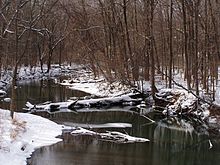
Fishing requires a State of Indiana Fishing license. Most fishing areas, are along streams and at a few of the ponds in the park. The newest fishing access is Portage Lakefront and Riverwalk. Located just west of U.S. Steel along the Burns Waterway, there is parking and a walkway along the waterways entrance breakwall. Here, you can fish in the waters of Lake Michigan. Other fishing accesses are available at Long Lake (West Beach entrance road), Burns Waterway and Lake Michigan (Portage Lakefront and Riverwalk), Little Calumet River (via the AmeriPlex access trail), and the Little Calumet in the Heron Rookery.
In the winter, cross-country skiing is possible. The park is beautiful under the snow.
There are no services in the park, but the park has numerous communities adjacent to its boundaries. Concentrations of restaurants, including fast-food and family restaurants are at the major freeway interchanges:
- I-94 and Hwy. 51-Gary/Miller/Lake Station
- I-94 and Hwy. 249-Portage
- I-94 and Hwy. 20-Burns Harbor/Porter
- I-94 and Hwy. 49-Porter/Chesterton, and,
- I-94 and Hwy. 421-Michigan City.
If you're willing to browse around, you can find many smaller local restaurants in the communities nearby.
Alcohol is allowed everywhere in the national park, except inside NPS buildings. No glass is allowed on the beach.
There are no lodging options within the state or national parks aside from camping, but the nearby towns of Chesterton and Porter have several options.
- 41.672 -86.9838 1 Dunewood Campground . 66 sites. All sites are first-come, first-served. The campground is fairly open with few trees between sites. There are two large modern bathhouses with showers and several pit-toilets scattered around. The dunes area is all sand and the campground is no exception. Grass is sparse in some areas and expect to get sand in everything. The campground is often full by the Friday before most summer weekends so it pays to arrive early to secure a site. Consists of two loops containing 66 camp-sites (53 conventional drive-in sites and 13 walk/carry-in sites). Four sites are wheelchair accessible (numbers 15, 30, 41 and 55). Each loop has modern restrooms and hot/cold showers. Some sites have limited recreational vehicle length. Convenience stores and a gas station are located 1/4 mile north of the campground at the intersection of U.S. Highway 12 and Broadway Avenue in the town of Beverly Shores. $25 Dunewood Campground Fee (2020 rates) . ( updated Jun 2020 )
Backcountry
The National Park has no wilderness area nor backcountry. Overnight stays are permitted only in Dunewood Campground, the State Park's campground or local motels which may be along the boundary of the park. All of the beach access parking lots are closed at dusk as there is no overnight use of the beaches.
Lake Michigan can have strong riptides and there are no lifeguards on several sections of the beach. Look for the warning signs at beach entrances. Sometimes they advise not entering the water at all. During the winter pack ice forms in thick chunks but is dangerous to walk on.
The area's only venomous snake, the massasauga rattlesnake, is occasionally seen in the forested parts of the park away from the beaches and dunes. However, it is not aggressive if left alone, hardly the most potent of rattlers, and the chances of running into one are nil.
- Has custom banner
- Has map markers
- Has mapframe
- Maps with non-default size
- Listing with Wikipedia link but not Wikidata link
- Do listing with no coordinates
- Has routebox
- Usable parks
- Usable articles
- Park articles
- Has Geo parameter
- Northwestern Indiana
- All destination articles
- Pages using the Kartographer extension
Navigation menu

A guide to Indiana Dunes National Park: Where to visit, what to do, and more
O verlooking the southern shores of Lake Michigan, Indiana Dunes National Park has long captivated visitors. In fact, it was there in the late 19th century that Henry Cowles, a botanist from the University of Chicago, studied the intricate ecosystems along the lake . His groundbreaking work established Cowles as “the father of modern ecology” in the United States. A little bit of history for your next trivia night.
Most people come to climb to the top of 194-foot Mount Tom, one of several towering dunes lording over the lakeshore. The park is home to gorgeous beaches and the biological diversity that so astonished pioneering botanists like Cowles. Meandering rivers, oak savannas, windswept prairies, and verdant wetlands are all part of the serene backdrop of one of America’s newest national parks — becoming the country’s 61st in 2019. If you haven’t made a visit yet , we have the guide to get you there.
Exploring the lay of the land at Indiana Dunes National Park
- It’s a smaller national park
- Plenty of animals and plants to check out
- Shoreline for days
- Close to Chicago
At just under 24 square miles, the dune-filled reserve isn’t quite the smallest national park in the country (that honor goes to the 91-acre Gateway Arch National Park in St. Louis). Despite its tiny stature, the park is home to a wide variety of plant and animal life, including 46 species of mammals and 60 butterfly species, as well as carnivorous pitcher plants, rare orchids, and 1,000 other species of flora.
Migrating birds fill the skies in April and September, while even the sands harbor life, like the six-lined racerunners (a type of lizard) and a native species of prickly pear cacti.
The placement of this national park seems rather unpromising at first. Chicago lies 40 miles to the northwest, and the remnants of an industrial corridor fringe the park on either side (the Nipsco power plant only looks nuclear). Once you’ve made peace with the setting, you’ll appreciate this protected landmark for all its surprising allure.
Another important feature to note is the noncontiguous layout of the park. It follows the shoreline, with a few small interruptions as it swerves inland near Gary and at the Port of Indiana.
The park also surrounds the smaller Indiana Dunes State Park, which, unlike the national park, has a small entrance fee. It’s worth visiting both, as the state park is home to some of the highest dunes over the lake.
How to prepare for your trip to Indiana Dunes National Park
- Make it a day trip
- Add it on to a tour of Chicago
- Spend a weekend taking in all of the dunes
You could immerse yourself in all the Indiana Dunes has to offer over a three- or four-day holiday, or make the national park one stop on a bigger excursion in the region. One appealing option is to spend a few days in Chicago before heading down to the dunes, then following the lakeshore east and north as it passes some gorgeous scenery in Michigan.
If you have time for a road trip, keep heading around the lake along Michigan’s western shore. Within an hour, you’ll reach the charming waterfront towns of Harbor Country, where you’ll find antique shops, galleries, fine beaches and some decent surfing.
Keep heading north for more bucolic charm, including Sleeping Bear Dunes and the Manitou Islands. If you don’t want to retrace your steps, keep going to Muskegon (a 2.5-hour drive north of the national park), and catch a ferry across the lake to Milwaukee, which is about 100 miles north of Chicago.
Where to stay near the Indiana Dunes National Park
Chicago makes a fine base for visiting the park as a day trip, but if you’re looking to reconnect with nature, you’re better off staying in the area.
There are several decent camping options there, including the Dunewood Campground, which has well-spaced forest-shaded spots. To be even closer to the lake, book a site in the Indiana Dunes State Park. This will give you prime dune access at sunrise and sunset, which are magical times to experience the shoreline.
Four miles south of the lakefront, Riley Railhouse occupies a converted railroad freight station, and it’s a major draw for train lovers with its imaginatively furnished rooms and common areas full of vintage train memorabilia. The Upper Berth room has a small balcony overlooking the tracks where trains still trundle past.
The Brewery Lodge and Supper Club is a resort hotel with 12 boutique suites. The remote resort sits on 40 acres of wooded tract that’s surrounded by wildlife, ponds, and streams. The main house, built in 1930, was recently updated, and it now offers a beer and wine lounge and restaurant with outdoor terraces.
What to do during your stay
Basking on the beach is one of many ways to spend a sun-drenched afternoon at the Indiana Dunes. You’ll find serene nature walks amid the park’s diverse ecosystems, kayaking on forest-lined waterways, and biking the many trails in the region.
Walking trails
The Dune Succession Trail takes you up some 270 steps to a lofty perch with sweeping views — all the way to Chicago on clear days. The mile-long walk illustrates various stages of dune development, from a bare beach to a forested section growing right out of the sands.
The 3.9-mile Little Calumet River Trail leads you out past the Mnoké prairie, through the forest, and over tiny bridges, with plenty of opportunities to spy birds and other wildlife along the way.
It’s worth paying a visit to the Indiana Dunes State Park for its three-dune challenge. You’ll climb a 1.5-mile trail that takes you up the three highest peaks on the shoreline for a cumulative total of 522 vertical feet (about 55 stories) over sand and along stairs in order to reach the panoramic views atop Mount Tom, Mount Holden, and Mount Jackson.
Don’t miss a visit to the Cowles Bog Trail, a 4.7-mile path that provides a fine overview of the wetlands’ biological diversity. You’ll pass ponds, marshes, and black-oak savannas. Before heading back, make the steep descent to the beach for a tranquil view over the lakeshore.
An interconnected trail system encompasses 37 miles (60km) across the national park and goes past shimmering dunes, wind-whipped prairie, and sun-dappled forests. Memorable jaunts include the 2.1-mile Marquette Trail and the 10.3-mile Prairie-Duneland Trail, both of which follow an abandoned rail line. Various outfitters rent bikes, including Pedal Power, handily located next to the Indiana Dunes Visitor Center.
Historical sites
In 1822, Joseph Bailly established one of the first fur-trading posts in the area, and it served as a crossroads and meeting spot for Native Americans and Euro-American colonists. After checking out the rustic log and brick buildings of the Bailley Homestead, continue on the trail to the nearby Chellberg Farm to learn about a pioneering Swedish immigrant family that put down roots there in the 1880s. Out back, get your barnyard animal fix, with cows, chickens, pigs, and goats.
At Dunbar Beach, take an architectural stroll past the 1933 Century of Progress Homes. Originally exhibited for the 1933 World’s Fair in Chicago, these five homes were purchased by real estate developer Robert Bartlett and brought mostly by barge to their present location on the lakeshore. Bartlett envisioned a planned resort community, called Beverly Shores, complete with a hotel, golf course, and housing developments.
Today, the entire district is a historic landmark, where you’ll get a glimpse of the future through the lens of 1930s design by checking out the once-innovative constructions along Lake Front Drive. Most eye-catching is the Florida Tropical House, painted in flamingo pink, while the glass-walled House of Tomorrow was built to include its own airplane hangar.
Beach-going
You won’t lack appealing places to relax on the shoreline, with 15 miles of beachfront along Lake Michigan. Among the park’s different beaches , a perennial favorite is West Beach, which is great for swimming if you don’t mind the chilly waters. It has a lifeguard station in the summer and an enticing expanse of sand for beachcombing and relaxing by the water’s edge. It’s also the westernmost of the park’s nine beaches, and right at the base of the popular Dune Succession Trail, making it a great place to cool off after making the trip to the top.
You’ll find fewer crowds at Kemil Beach, and getting there takes you on one of the park’s most scenic drives, which follows a winding forest-lined road. After visiting the sandy shores, hike the short (0.7-mile) Dune Ridge Trail, a wooded dune that offers views over the wetlands and forests to the south.
Further east, Central Avenue Beach is another quiet spot to enjoy nature. Come early or late in the day to see waterfowl and shorebirds, as well as bank swallows that nest in the dunes during spring and early summer.
Important details to know when visiting the Indiana Dunes National Park
Best time to visit.
- Fewer crowds in the spring and the fall
- The middle of the week is best
- Don’t skip the winter
- May is for bird-watching
The park is open year-round, with camping available from April through October. The big crowds come from June through early September, though mid-week is much quieter. Swimming is always a chilly endeavor, though more bearable in July and August.
But don’t neglect the winter! It does get cold by the lake, but there is still so much to see, and everything else to see and places to eat are open.
If you are into birds, then go in May. There’s a whole Indiana Dunes Birding Festival every May that you won’t want to miss.
Getting there
- Drive on in
- Fly as close as possible
- The train is the most fun
The national park is a short hop from Chicago (40 miles northwest) and lies between the towns of Gary and Michigan City. While most visitors come by car, it’s easy to reach the dunes by train. From Chicago, the South Shore Line has four stops in the park: Miller, Ogden Dunes, Dune Park, and Beverly Shores.
What to pack
You might think with all of that walking that you’ll need to bust out the hiking boots . Well, you might want to. But the majority of the trails will really only need your favorite pair of sneakers. The main thing is that the weather there never gets it together, so it’s best to wear a few layers just in case. You are by the water, after all.
The Midwest has its gems, and the Indiana Dunes National Park is definitely one of them. While suggesting a trip to The Region might make some people tilt their heads, once they’ve seen the beauty that the Dunes has to offer, they’ll understand.
The post A guide to Indiana Dunes National Park: Where to visit, what to do, and more appeared first on The Manual .

Advertiser Disclosure
Many of the credit card offers that appear on this site are from credit card companies from which we receive financial compensation. This compensation may impact how and where products appear on this site (including, for example, the order in which they appear). However, the credit card information that we publish has been written and evaluated by experts who know these products inside out. We only recommend products we either use ourselves or endorse. This site does not include all credit card companies or all available credit card offers that are on the market. See our advertising policy here where we list advertisers that we work with, and how we make money. You can also review our credit card rating methodology .
The Ultimate Guide to Indiana Dunes National Park — Best Things To Do, See & Enjoy!
Amar Hussain
Senior Content Contributor
823 Published Articles
Countries Visited: 63 U.S. States Visited: 9
Keri Stooksbury
Editor-in-Chief
43 Published Articles 3380 Edited Articles
Countries Visited: 50 U.S. States Visited: 28
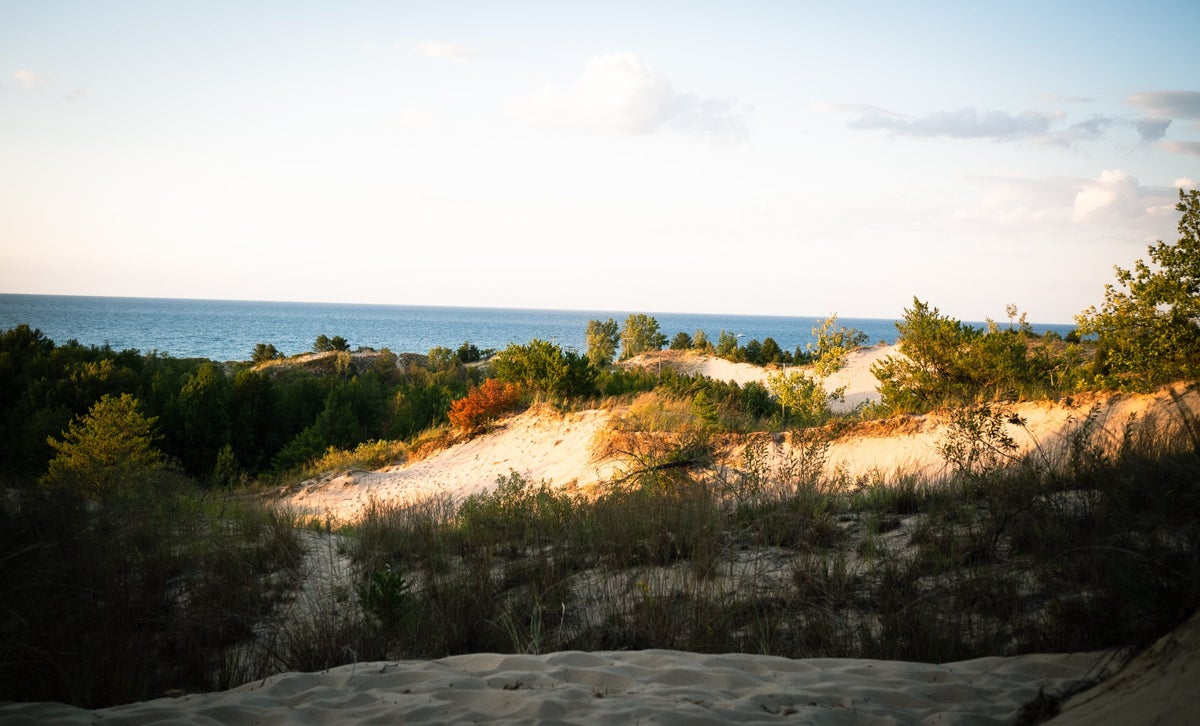
Table of Contents
How to get to indiana dunes national park, getting around indiana dunes national park, what to see and do in indiana dunes national park, best times to visit indiana dunes national park, where to stay in indiana dunes national park, where to eat near indiana dunes national park, indiana dunes national park facts, final thoughts.
We may be compensated when you click on product links, such as credit cards, from one or more of our advertising partners. Terms apply to the offers below. See our Advertising Policy for more about our partners, how we make money, and our rating methodology. Opinions and recommendations are ours alone.
Indiana Dunes National Park is a beautiful national park on Lake Michigan’s southern shores. This national park brings approximately 2.5 million visitors annually, with the record-breaking year of over 3 million in 2021. This gorgeous park has miles and miles of sandy beaches, lush woodlands, sprawling prairies, and mesmerizing dunes waiting to be explored.
Where Is Indiana Dunes National Park?
Indiana Dunes National Park is located on the southern tip of Lake Michigan, approximately 40 miles from Chicago . This national park stretches over 15,000 acres of beach, wetlands, prairies, woodlands, and dunes. Many roads and entry points around the park can access this Indiana Dunes National Park.
Nearest Airports to Indiana Dunes National Park
Several options exist for visitors who want to fly to Indiana National Park. Whether you decide on a nearby major airport or a smaller airport in close proximity, you can rest assured that there is a perfect solution for your travel needs.
Chicago Midway International Airport (MDW)
Chicago Midway International Airport is located 43 miles from Indiana Dunes National Park. This airport offers 220 daily flights to 77 U.S. cities and several direct flights to over 12 international destinations.
Many popular airlines are serviced by Chicago Midway International Airport, including Allegiant, Delta, Frontier, and Southwest. The airport is close to the park and serves many well-known airlines, making it an excellent choice for flying to Indiana Dunes National Park.
O’Hare International Airport (ORD)
O’Hare International Airport is about an hour and 10 minutes from Indiana Dunes National Park. This airline offers 100 daily direct flights to 62 international cities and over 800 daily direct flights to more than 150 cities in the U.S. This airport services many popular airlines like Aeromexico, Air France, Alaska, American, Delta, Frontier, and JetBlue.
The airport is not too far away from Indiana Dunes National Park. Choosing this airport is a wonderful option for guests seeking a larger airport with a great number of flights and airlines offered.
South Bend International Airport (SBN)
South Bend International Airport is just 34 miles from Indiana Dunes National Park. This airport makes an excellent choice for flying to this national park. South Bend International Airport offers nonstop service to several large cities in the U.S. The airlines serviced by this airport include Allegiant, American, Delta, and United.
Bottom Line: South Bend International Airport is an obvious choice for guests who want to make the most of their travel time.
Driving to Indiana Dunes National Park
Indiana Dunes National Park can be accessed by various roads and highways, depending on which area you are arriving from. The main routes to this national park include Interstate 94, Indiana Toll Road (I80/90), Highways 12 and 20, Indiana State Road 49 (the main road for entering the park) , and several other state roads.
Taking the Train to Indiana Dunes National Park
A trip by railway is always an experience to remember for ages. The Chicago and South Shore Train has stops in Indiana Dunes National Park. Taking the train to Indiana Dunes National Park allows visitors to sit back and enjoy the ride and sights along the way to this national park.
Taking the Bus to Indiana Dunes National Park
Gary Public Transportation Corporation (GPTC) is another option for arriving at Indiana Dunes National Park. This bus transit runs Monday to Saturday and is an excellent option for guests seeking alternate transportation to the park.
GPTC offers routes that pass directly in front of the visitor center near the park entrance. This form of transportation is super affordable, with no trip costing over $4 and opportunities for multi-day passes.
Driving a private vehicle is the best way to get around Indiana Dunes National Park. Plenty of parking lots and roads travel through the park for easy exploration. The National Park Service provides several maps , both printable and interactive, to help plan your Indiana Dunes adventures.
Indiana Dunes National Park has sites and activities for every visitor to participate in and explore. There’s a wealth of recreational and educational opportunities available at this national park. Let’s discover several popular activities at this national park and see which ones you’d like to add to your Indiana Dunes National Park itinerary.
Geocaching is an exciting way to explore Indiana Dunes National Park. Geocaching is like a treasure hunt that uses GPS to find hidden containers and trinkets throughout the park.
There are 4 different types of geocaching available at this national park, each bringing its own unique flair to participants. Traditional geocaching, EarthCaches, lab caches, and virtual caches are the types of geocaching visitors love to experience at Indiana Dunes National Park.
This activity can be enjoyed in various areas, including the Chellberg Farm area, several beaches, and Portage Lakefront and Riverfront, with virtual caches in the Bailly Homestead area, the Chellberg Farm area, and in the Century of Progress Historic District. This activity can be enjoyed with friends, family, or alone.
Guided Tours
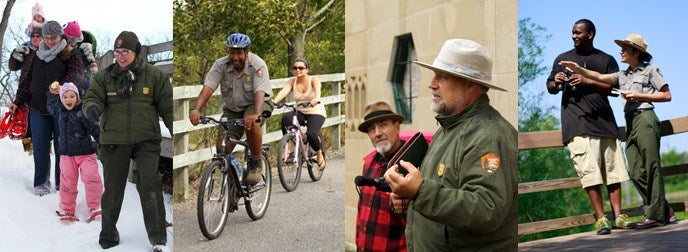
Guided tours are an excellent option for experiencing Indiana Dunes National Park. This particular park offers over 400 programs, ranger-led walks, and talks throughout the year in various park areas.
Some of the most popular guided tours include boat tours on Lake Michigan, historic house tours, ranger-led tours of the Century of Progress homes , and tours of the Pinhook Bog. Participating in a guided tour at Indiana Dunes National Park is a wonderful way to learn about the park, interact with guests and park rangers, and explore the park.
Hiking enthusiasts love visiting Indiana Dunes National Park for its outstanding hiking opportunities. There are over 70 miles of hiking trails suitable for all ages and abilities. The hikes offered at Indiana Dunes National Park take visitors through a variety of ecosystems, including woodlands, prairies, wetlands, and of course, dunes.
Some of the most popular trails at Indiana Dunes National Park include the
- Cowles Bog Trail
- Glenwood Dunes Trail
- Heron Rookery Trail
- Paul H. Douglas Trail
Hiking through Indiana Dunes National Park is an excellent way to experience the beauty and wonder of this spectacular park.
Historic Landmarks
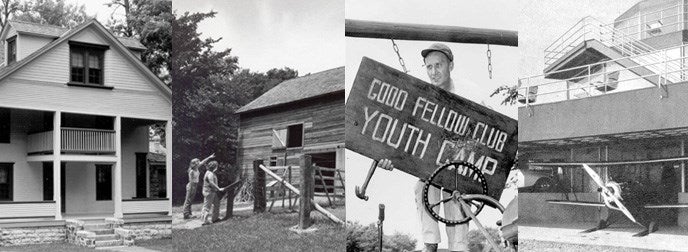
Indiana Dunes National Park has over 60 historic structures within the park boundaries , including a National Historic Landmark. Visitors can tour each of these historic areas to learn about the natural and cultural history of the park. The historic landmarks of Indiana Dunes National Park include:
- Bailly Homestead
- Chellberg Farm
- Good Fellow Youth Camp
The park also features historic homes that are part of the 1933 World’s Fair Century of Progress theme and showcase new construction techniques, modern home appliances, and innovative building materials. These sites include the Armco-Ferro House, Cypress Log Cabin, Florida Tropical House, House of Tomorrow, and Wiebolt-Rostone House.
Bottom Line: Visiting these historic homes and landmarks gives a glimpse into life in the earlier history of the area.
Horseback Riding
Indiana Dunes National Park has an incredible variety of activities for visitors to participate in. One exciting opportunity is to explore the park on horseback .
This park offers horseback riding and programming on specific days . Still, for horse riding enthusiasts, there are many areas of the park where horses are permitted. Experiencing nature and exploring Indiana Dunes National Park on horseback will create memories to last a lifetime.
Indiana Dunes National Park Visitor Center
The visitor center is always a great place to start when visiting a national park. The visitor center at Indiana Dunes National Park is an excellent starting point before exploring the park.
Indiana Dunes National Park Visitor Center has art exhibits, an activity room for kids of all ages, 2 informational films, and a bookstore where you can purchase souvenirs.
This visitor center is an excellent place to begin your vacation and learn about this incredible park.
Lake Michigan Beaches
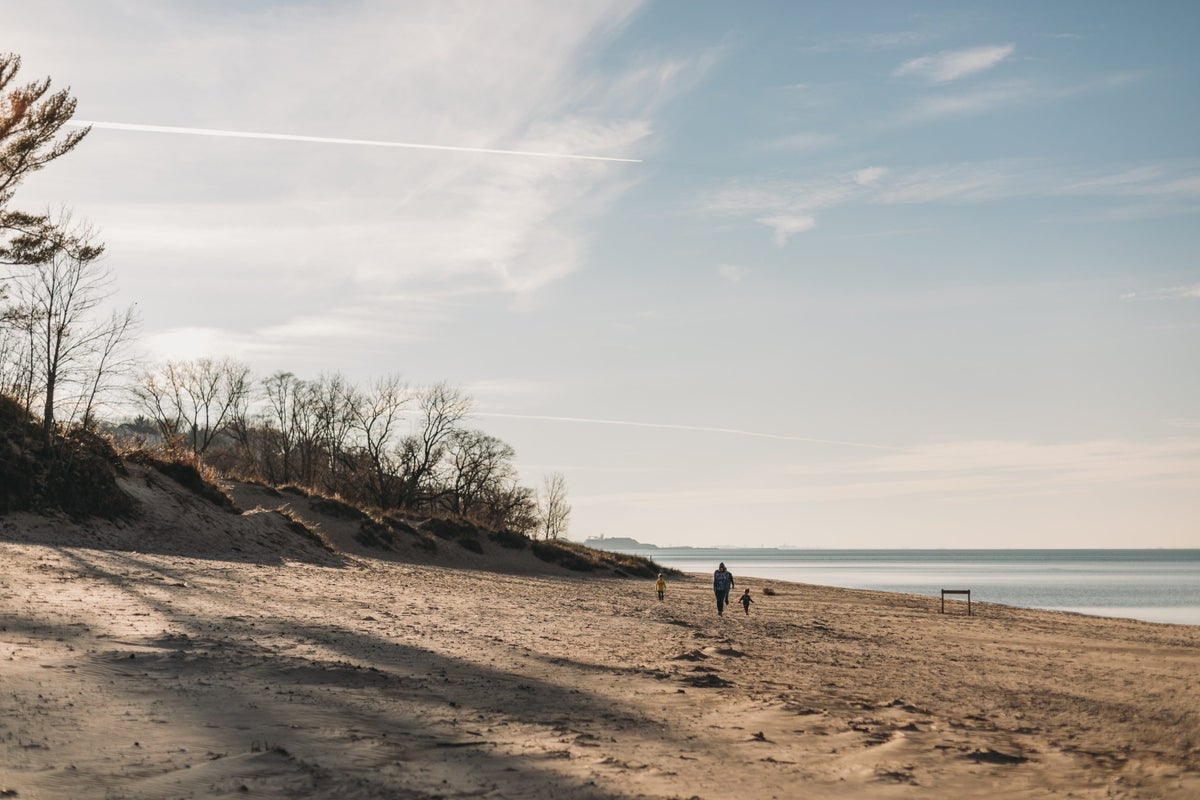
Indiana Dunes National Park has over 15 miles of beaches along Lake Michigan’s southern shore. These beaches provide a multitude of recreation opportunities. From long walks and picnics on the beach to swimming and soaking in the sun on the shimmering sand, there’s something for everyone at one of the beaches in this national park.
The parking lots at many beaches, including Lake View, Porter, Portage Lakefront, Kemil, and Dunbar, fill up quickly, so planning to arrive early in the morning or late in the afternoon will help you secure a parking spot.
Another fantastic opportunity to spend time at the beach is to take one of the many nearby hikes. One of the most popular beach area hikes is the Dune Succession Trail . This trail features stunning scenery of pine trees, lots of birds for birdwatching , and secluded forest areas.
With no shortage of activities and recreation, it’s easy to see why most visitors plan to spend a great deal of time at the beaches of Indiana Dunes National Park.
Hot Tip: If you’re in the area, check out our guides to the best beaches in Chicago and Michigan .
Paul H. Douglas Center for Environmental Education
The Paul H. Douglas Center for Environmental Education is a beautiful facility dedicated to connecting visitors to the natural environment of Indiana Dunes National Park.
This center has hands-on exhibits, lectures, animals, crafts, ranger-guided hikes, and a Nature Play Zone for kids. The Paul H. Douglas Center for Environmental Education is dedicated to educating visitors about this phenomenal park in an exciting, interactive way.
Indiana Dunes National Park is a wonderful park to visit no matter which time of year you arrange a trip. There are better times than others to visit this national park if you are hoping to participate in a specific event or activity.

Best Time To Visit Indiana Dunes National Park for Hiking
Visitors who love the adventure of hiking through a national park will want to visit Indiana Dunes National Park in October. October brings milder temperatures that are perfect for hiking through the park. During this month, visitors can expect daytime highs in the mid-60s and lows in the mid-40s. Not only is the temperature ideal for hiking, but there are also much fewer crowds in the park during this time of the year.
Best Time To Visit Indiana Dunes National Park To Avoid the Crowds
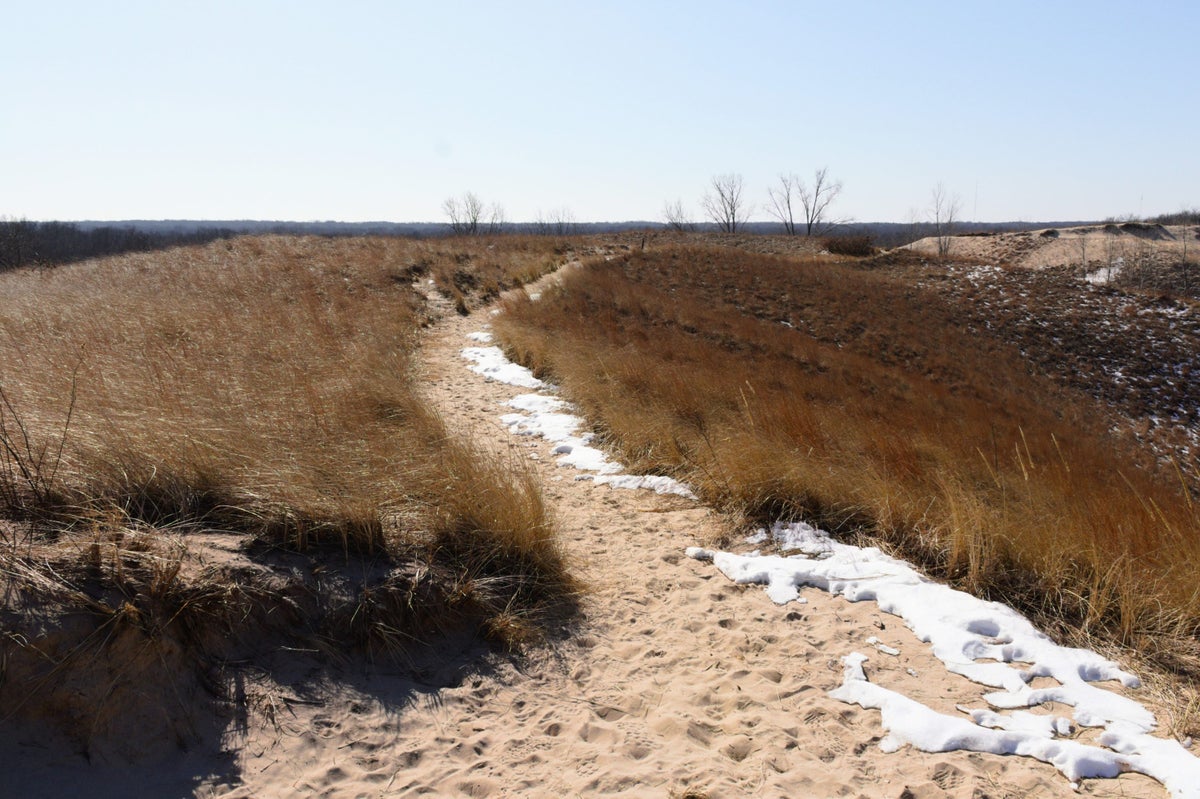
Winter is the least crowded at Indiana Dunes National Park due to the cold weather. If you want to plan a trip to this national park and avoid crowds, a trip during December is a great idea. The temperatures in December are warmer than in the other winter months, with less chance of precipitation.
Bottom Line: A trip to Indiana Dunes National Park during December allows for exploring the park at your own pace with more comfortable temperatures.
Best Time To Visit Indiana Dunes National Park for Wildlife
Wildlife enthusiasts will love seeing various animals living in Indiana Dunes National Park. An excellent month for viewing wildlife in this national park is in March.
The temperatures are beginning to rise, lots of birds are migrating to the area, and many animals can be seen getting out to enjoy the warmer temperatures.
Cheapest Time To Visit Indiana Dunes National Park
Planning a trip in September is ideal for visitors hoping to save money while traveling. Visiting Indiana Dunes National Park after Labor Day is a great way to spend less on flights and accommodations since this is when park visitation takes a dip in numbers.
Not only will visiting Indiana Dunes National Park during September allow you to spend less while traveling, but there will also be fewer crowds, which means you can enjoy the park at a more relaxed pace.
Annual Events in Indiana Dunes National Park
Indiana Dunes National Park hosts a variety of events each year. Whether you are seeking events in nature, races, or a festival, there is always plenty to choose from at this national park. Take a look at a few of the top events at Indiana Dunes National Park.
Indiana Dunes Birding Festival
The Indiana Dunes Birding Festival is a beautiful time for birdwatchers and nature enthusiasts to gather to learn about and watch the variety of birds who make their home in the park. This festival takes place each May.
The Indiana Dunes Birding Festival partners with the Indiana Audubon Society and provides opportunities for guests to participate in workshops, hikes, and programs for beginning and advanced birdwatchers and dune and plant devotees.
Visiting Indiana Dunes National Park during the Indiana Dunes Birding Festival would be an enchanting experience and amazing opportunity to see the hundreds of species of birds that live in the park.
Maple Sugar Time Festival
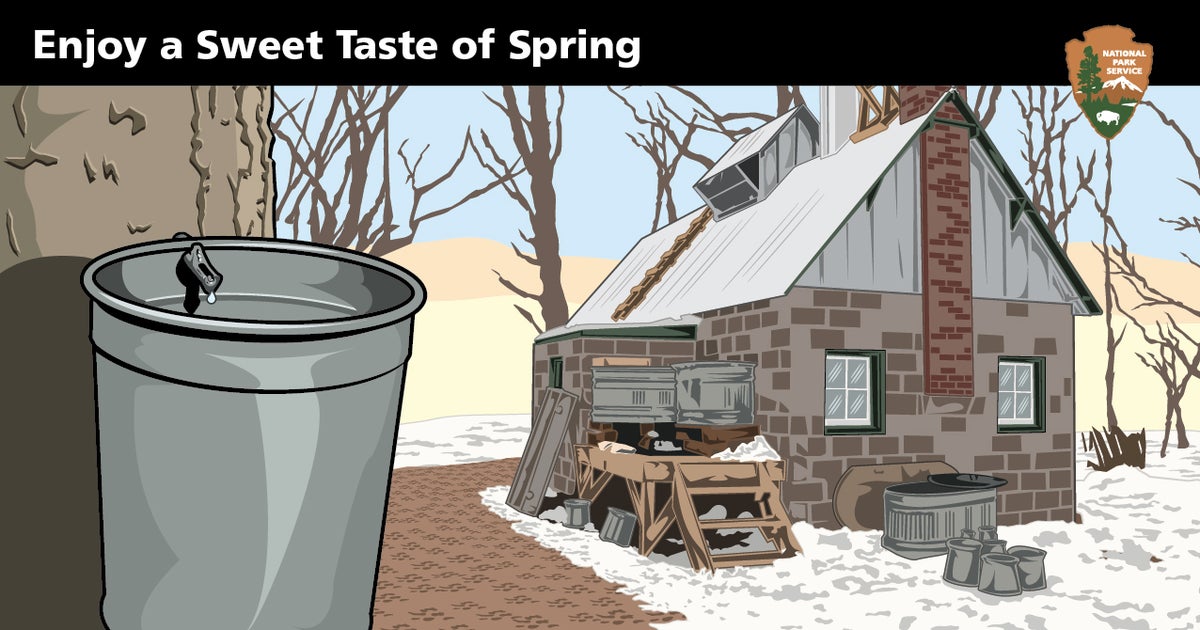
In March, the Maple Sugar Time Festival occurs yearly at Indiana Dunes National Park. This event has been taking place for over 43 years and offers visitors to the park a sneak peek of spring. There are self-guided tours of historic landmarks, demonstrations on how maple syrup is made, and opportunities to sample exciting snacks and goodies.
The Maple Sugar Time Festival has several children’s programs, crafts, hikes, and performances for visitors. This event is an excellent time for families and friends to make memories and learn at the same time.
Running with the Irish 5K
Each year in March, the annual Runnin’ with the Irish 5K takes place in Chesterton, Indiana. This race has been taking place for 23 years. The course for this 5K winds through Indiana Dunes National Park, providing a stunning scene for the run. This event has awards for all age groups and benefits St. Patrick School in Chesterton.
If you are a running enthusiast, you will want to make sure to visit Indiana Dunes National Park during this race so you can enjoy the thrill of the race while taking in the gorgeous scenery of the park simultaneously.
There are plenty of options for lodging when visiting Indiana Dunes National Park. Whether you desire to stay on the park’s property or in one of the nearby towns, you can find exactly what you’re looking for in this beautiful area of the U.S. Below you will find options for accommodations in and near Indiana Dunes National Park.
Inside the Park
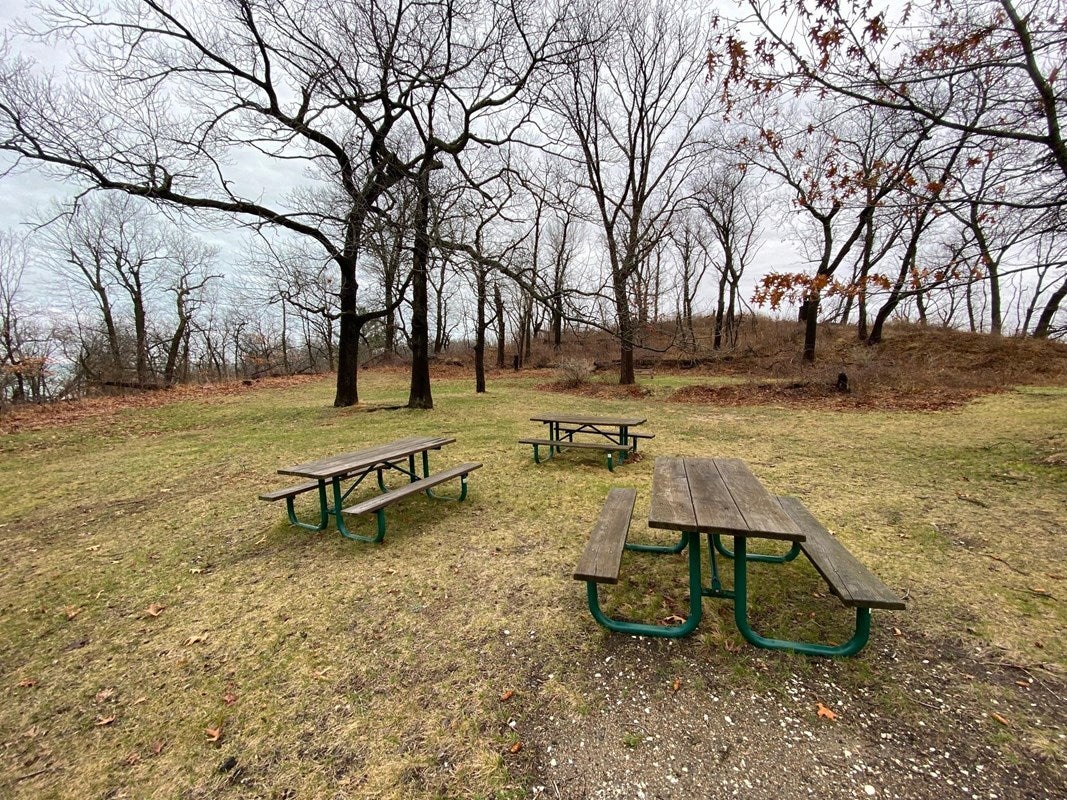
The only option for lodging in Indiana Dunes National Park is camping. This national park has 2 campgrounds for visitors: 1 for groups and 1 for traditional camping. Let’s look at these camping options to see if either works for your vacation needs.
Dunbar Group Site
The Dunbar Group Site is less than 500 feet from Dunbar Beach and overlooks the Great Marsh and Lake Michigan. This campsite is exclusively for tent camping and larger groups. This site can accommodate up to 30 people and has parking and restrooms nearby. If you plan to travel with a group, be sure to reserve the Dunbar Group Site for the ultimate camping experience.
Dunewood Campground
Dunewood Campground is a double-loop campground featuring 66 campsites for tent and RV camping. This campground has several amenities, such as modern restrooms with hot and cold showers, water, dump stations, and an amphitheater.
Dunewood Campground is also close to convenience stores and gas stations. Camping at Dunewood Campground is an excellent place to enjoy the beauty and wonder of Indiana Dunes National Park.
Towns Near Indiana Dunes National Park
For visitors who prefer to stay near the park, the surrounding towns have plenty of options. These towns have plenty of lodging, dining, and recreation opportunities. Check out the most popular towns for setting up a home base near Indiana Dunes National Park.
Chesterton, Indiana
Chesterton is less than 3 miles away from Indiana Dunes National Park. This city is an excellent option for visitors who want to stay near the park. There are plenty of places to stay and dine and many activities to enjoy.
There is a variety of accommodations available for visitors, including bed and breakfasts, contemporary hotels, and campgrounds. Whether you are hoping to sleep under the stars or in a traditional lodging accommodation, there’s plenty to choose from in Chesterton.
The dining scene is exquisite, with several restaurants serving a variety of cuisines, from Italian to Mediterranean to farm-fresh dishes. These restaurants are mostly locally owned and create spectacular dishes using fresh, local ingredients.
Outdoor enthusiasts enjoy the hiking and biking trails, the gorgeous beaches of Lake Michigan, and golfing. Those who enjoy learning about history can explore the Commercial Historic District and the Westchester Township History Museum . There are also opportunities for shopping and visiting art galleries.
Bottom Line: The town of Chesterton has plenty to offer visitors who want to set up a home base near Indiana Dunes National Park.
Michigan City, Indiana
Michigan City is 11 miles from Indiana Dunes National Park. This city is an excellent place to set up a home away from home during a vacation to this national park, as it has a variety of excellent lodging opportunities, sites to explore, and plenty of restaurants to try.
There are dozens of options for lodging in Michigan City. From charming bed and breakfasts to campgrounds in the great outdoors, from vacation homes to luxury resorts, you can find just what you are looking for.
This city has an abundance of activities, including local art galleries, artisanal shops, and theaters. Outdoor activities include visiting the orchards, farms, and gardens, fishing, golfing, or even sky diving.
There are plenty of options for dining, with dozens of restaurants serving a variety of cuisine, including authentic cultural restaurants, gourmet steak houses, and unique pizza parlors. Michigan City is wonderful at melding high-class dining and classic favorites.
With its close proximity to the park and its endless list of dining, recreation, and lodging opportunities, Michigan City would be an excellent choice for setting up a base camp near Indiana Dunes National Park.
Portage, Indiana
Portage is a mere 10 miles from Indiana Dunes National Park. This town is another great place to set up a home base while visiting Indiana Dunes National Park. There is an abundance of accommodations, restaurants, and activities for visitors to enjoy.
There is a variety of budget-friendly and luxury hotels available for guests to choose from. Whether you are looking for a family-friendly retreat or a couples getaway, you can find the perfect accommodations in Portage.
Food enthusiasts are in for a treat as there are excellent restaurants around every corner in this town. There’s something for every palate, from award-winning burgers to fresh fish tacos, and from comfort foods like macaroni and cheese to gourmet steaks.
There’s no shortage of recreation in Portage. Visitors enjoy a variety of outdoor adventures like hiking, relaxing on the beach of Lake Michigan, cycling, and exploring the nearby dunes. There are also many exciting events, such as music festivals, art shows, and beer and wine events.
Portage is an excellent option for visitors wanting to stay near Indiana Dunes National Park. The fun never ends in this tourist town.
There are dozens of top-ranked restaurants near Indiana Dunes National Park. Whether you are craving a juicy burger, high-quality steak, or a sizzling pizza, you can find exactly what you crave just minutes from the park.
All of our recommendations are located in Valparaiso, just 13 to 14 miles from Indiana Dunes National Park.
Industrial Revolution Eatery and Grille

For an educational and delicious dining experience, be sure to visit Industrial Revolution Eatery and Grille . This restaurant, open daily for lunch and dinner, is dedicated to sharing the story of America’s past while serving classic foods well-loved by American workers. It has coined the term “upscale industrial” to describe its atmosphere, and a meal here features an unforgettable meal, historical entertainment, and inspiration to take advantage of life’s opportunities.
The restaurant features an impressive menu of gourmet burgers, brick oven pizzas, soups, sandwiches, salads, and Revolutionary Originals. Some of the favorite meals include the pot roast burger, the Freedom Pie pizza, the chicken fried chicken, and the “Captain Jones” fish tacos. There are also dishes for specialized diets and food sensitivities.
Meditrina Market Café
Meditrina Market Café serves an impressive menu of Mediterranean dishes, fine wines, and beers. Customers rave about the chicken shawarma, Meditrina pizza, and falafel. This restaurant also has specialty dishes for vegan and vegetarian diets, so every customer will have an incredible culinary experience no matter what.
The café is open Monday through Saturday for lunch and dinner and is an excellent place to stop to refuel after a long day exploring Indian Dunes National Park.
Stacks Bar and Grill
Stacks Bar and Grill is a one-of-a-kind restaurant that serves unique dishes in a library-themed setting. This downtown restaurant is one of the most popular restaurants in Northwest Indiana. It is open Tuesday through Saturday for lunch, dinner, and late-night desserts and drinks.
Dining is offered in the reservation-only dining room or on the rooftop. The rooftop is perfect for grabbing drinks with friends, enjoying the live music, and ordering off the small plate menu.
Customers’ top-ranked dishes include the Stacks burger, blackened salmon, chicken bruschetta pizza, and the mixed berry white chocolate bread pudding. Stacks also proudly serves dishes for guests on a gluten-free, vegetarian, or vegan diet. This restaurant is a great place to unwind and enjoy a fine dining experience.
Tomato Bar Pizza Bakery
Tomato Bar Pizza Bakery is open Sunday through Thursday for lunch and dinner. If you find yourself with a hankering for a premium slice of pizza during your national park vacation, look no further.
This incredible pizza restaurant serves top-quality pizzas and Italian dishes with fresh, high-quality ingredients. Favorite dishes from locals and visitors include the Soul Chaser or Meatgazer pizzas, the Moneymaker calzone, and the famous doughnuts flavored with various herbs and cheeses.
Whether you come in to dine at Tomato Bar Pizza Bakery or grab a pie to take with you, you can rest assured that you will be delighted with the delicious cuisine you are served. This is the perfect place to refuel before, during, or after your Indiana Dunes explorations.
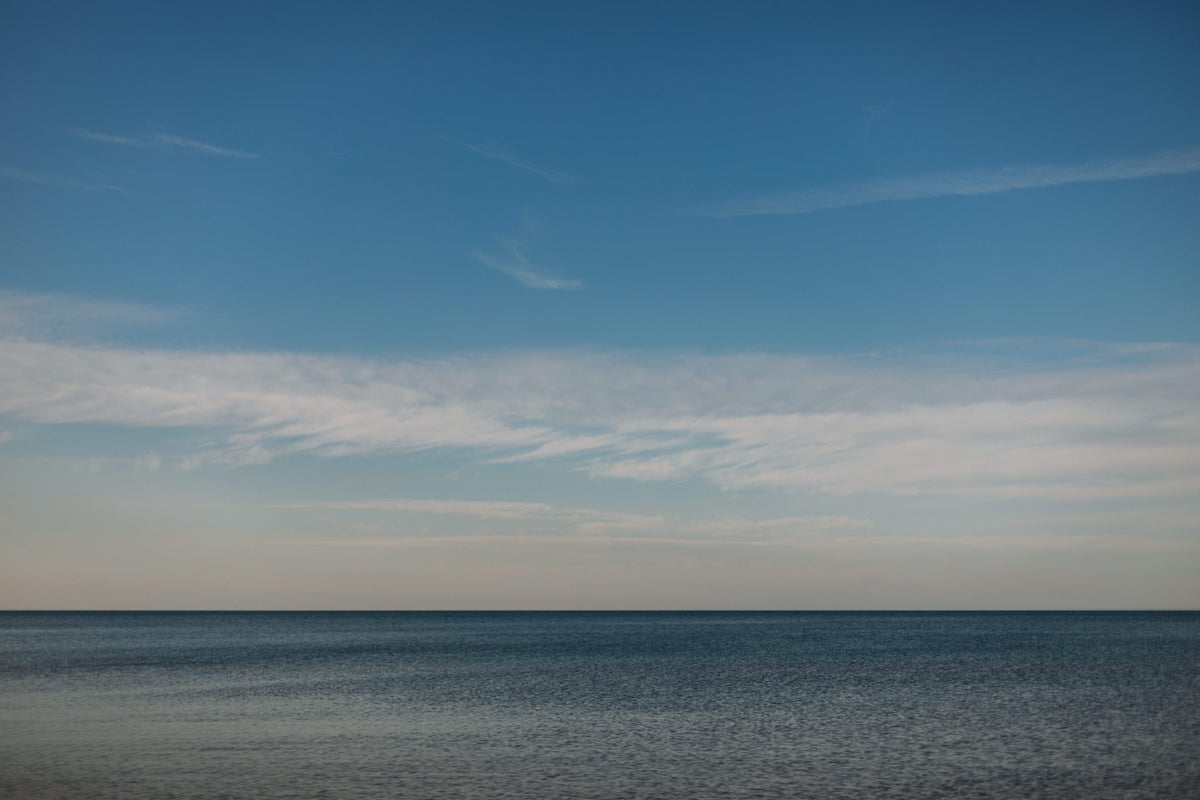
1. A New National Park
Indiana Dunes National Park is one of America’s newest national parks. This park was established on February 15, 2019. Indiana Dunes National Park is the United State’s 61st national park. Before this establishment, the area was authorized as Indiana Dunes National Lakeshore in 1966.
2. A Park in a Park?
Indiana Dunes National Park is comprised of 2 park systems. These park systems are the Indiana Dunes State Park and the Indiana Dunes National Park. Since this park is truly 2 parks in 1, you can expect many days worth exploring and sightseeing when planning a trip to Indiana Dunes.
Because this park is so large and since it is composed of 2 separate parks, the number of visitors to this park is comparable to the number of visitors Yellowstone National Park gets each year. It is also important to note that this park has 2 separate entities, so you can expect separate fees for each park.
3. America’s Fifth Most Biodiverse National Park
Indiana Dunes National Park is America’s fifth most biodiverse national park. This park is home to an abundance of animals and plant species. Over 1,960 species of mammals, reptiles, birds, amphibians, fish, and vascular plants are documented in this park. The parks that precede Indiana Dunes National Park when it comes to being so diverse in plant in animal life include the Great Smoky Mountains , Grand Canyon , New River Gorge, and Yosemite National Parks .
4. National Historic Landmark
The Bailly Homestead was designated a National Historic Landmark in 1962. This historic homestead was home to Honore Gratien Joseph Bailly de Messein and Marie LeFevere Bailly from 1774 to 1866. Bailly had a significant role in establishing the Calumet Region of northern Indiana. He was one of the earliest settlers in Indiana and began a fur trading post in the area. This area is exciting to explore and learn about the cultural history of this part of the park.
5. Singing Sands
Indiana Dunes National Park is known for its singing sands. This naturally occurring phenomenon is a true sight, or sound, to behold. Singing sands occur when avalanches move down the sand dunes, producing an audible vibration.
6. Paradise for Birdwatchers
Indiana Dunes National Park is a paradise for birding enthusiasts. There are over 350 bird species that have been documented in this national park. Some birds that make their home in Indiana Dunes National Park include the great blue herons, great egrets, and sandhill cranes.
7. Celebrity Status
Indiana Dunes National Park was the setting for a major motion film in 2009. Christian Bale and Johnny Depp starred in a movie called “Public Enemies” that was shot at this park. Other films that have been shot in this park include a short science-fiction film called “Illusions of Life” and a drama called “Sun Opener.”
8. Land Expansions
This area of this national park has been expanded 4 separate times in 1976, 1980, 1986, and 1992. The park continues to grow to preserve and protect the parklands and the ecosystems it comprises.
9. Wonder Women
There are 14 women who greatly impacted Indiana Dunes National Park . These women were activities, naturalists, botanists, and survivors who exemplified resilience during an era of change. These remarkable women who made their mark on Indiana Dunes National Park include Charlotte Read, Dorothy Buell, and Flora Richardson. These 14 women used their skills and abilities to fight for the rights, preservation, and protection of the Indiana Dunes parklands.
10. Henry Cowles
Henry Cowles is a remarkable man who significantly impacted the history of Indiana Dunes National Park. Cowles was a botanist that rescued the parkland from being destroyed. He ended up being nicknamed “the father of modern ecology” because of his efforts in protecting this area of America. His work helped establish this area as Indiana Dunes National Lakeshore in November of 1966.
11. An Abundance of Artifacts
Indiana Dunes National Park has an abundance of artifacts that have been collected over the years. These artifacts are displayed in a museum collection and tell the story of the rich cultural and natural history of this area of the U.S. Some of the artifacts that have been collected include portraits, photographic negatives, and signs from buildings of the past.
12. Educational Opportunities
Indiana Dunes National Park offers a variety of educational experiences for students of all ages, whether they are physically visiting the park or visiting virtually online . There are many educational opportunities for students, including climate change curriculum, math activities, bird tracking, story maps, and history of the plants in the land.
Not only can the park host these activities on the park boundaries, but also a variety of activities for students who may be unable to visit for one reason or another. There is so much to learn about Indiana Dunes National Park. The staff and volunteers make learning available and accessible for all visitors, no matter what.
13. 2 Types of Dunes
There are 2 types of dunes at Indiana Dunes National Park: foredunes and blowout dunes. Foredunes are near the beach and feature vegetation. Blowout dunes are another type of dune found in Indiana Dunes National Park. These dunes are created because of strong winds tearing the dunes apart. The loose sand makes a dune that can move year after year.
There is no shortage of things to see, do, and experience at Indiana Dunes National Park. From outdoor adventure to history, there’s something for everyone to enjoy at this magnificent park. Book your trip to Indiana Dunes National Park and experience this spectacular area filled with beauty, wonder, and history.
Related Posts
![indiana dunes national park travel guide Virtual Tours of the 63 Iconic U.S. National Parks [2024]](https://upgradedpoints.com/wp-content/uploads/2022/11/Arches-National-Park-View.jpg?auto=webp&disable=upscale&width=1200)
UP's Bonus Valuation
This bonus value is an estimated valuation calculated by UP after analyzing redemption options, transfer partners, award availability and how much UP would pay to buy these points.

Best family adventures around St. Louis and beyond

Family Vacation Guide for Indiana Dunes National Park
Did you know you can find one of the most biodiverse National Parks in Indiana? Indiana Dunes became a National Park in 2019 and it is well worth a visit. While you might not think of Indiana when planning a trip to the beach, Indiana Dunes National Park offers hiking trails, historic sites, and sugar sand beaches to explore. Read on for the best tips and vacation guide for a family trip to Indiana Dunes National Park.

About Indiana Dunes National Park
History of the park.
A movement to protect the sand dunes of the Indiana Lakeshore first began way back in 1899. The area was home to industry that damaged portions of the dunes. Only one month after the National Park Service was established in 1915, hearings were held in Chicago to gauge public sentiment on a “Sand Dunes National Park.”
World War I and then the Great Depression interfered with the creation of a National Park at the dunes. Indiana Dunes State Park was ale to be established in 1926, but it was relatively small at the time. A program known as the Kennedy Compromise led to the development of the Port of Indiana, but only with the requirement of the Indiana Dunes National Lakeshore also being created.
The National Lakeshore was expanded several times to total 15,000 acres. Congress voted to change the name of the Indiana Dunes National Lakeshore to Indiana Dunes National Park in 2019. It became the 61st National Park.
Admission to Indiana Dunes National Park
For the first few years, admission was free to the National Park. However, starting in 2022 there is now a $25 admission fee per car good for 7 days. Annual passes such as the America the Beautiful or Every Kid Outdoors pass will work for entry. None of these national parks passes will work for the state park, however, if you visit there.
The Difference Between the National Park and State Park
Visiting the park can be a little confusing, because there is the Indiana Dunes National Park as well as Indiana Dunes State Park. The state park is located surrounded by the national park and has it’s own admission fee. The state park has its own set of hiking trails and amenities including the popular Three Dune Challenge Hike. We did not visit the state park on this trip, so this post will not cover anything at the state park.
Best Time to Visit Indiana Dunes National Park
Spring and fall are a great time to visit if you want to avoid crowds. Summer weekends can bring a lot of travelers from Chicago and beaches can be crowded. Hiking trails can also be hot during summer as many have little shade. However, if you want to play in the water then summer is best.
We visited on a Friday and Saturday morning during early August and didn’t have an issue with crowds. The hiking trails especially were pretty quiet.

Where to Stay at Indiana Dunes National Park
There are several options for lodging near the Indiana Dunes. You can stay within the park itself at the Dunewood Campground. However, it is a 1.5 mile drive to Lake Michigan from the campground. There are other campgrounds in the area including at Indiana Dunes State Park.
We stayed at the Quality Inn in Chesterton, Indiana. It is nothing fancy, but it is budget friendly and the location was perfect right by the National Park. (We are only ever in our rooms to sleep on vacation so we tend to book rooms on a budget!)
Things to Do at Indiana Dunes National Park

Indiana Dunes Visitor Center
The Visitor Center is the best place to start your visit. Here you can visit education displays, pick up maps and brochures, and learn about the Junior Ranger program. There are also restrooms here and the park sign for photo op.
The Visitor’s Center is open daily Memorial Day to Labor Day 8:00 A.M. – 6:00 P.M. and during the winter 9:00 A.M. – 4:00 P.M. The center is closed major holidays and may have abbreviated hours on other federal holidays.
Indiana Dunes National Park Beaches
Not many National Parks offer the array of beaches you can find at Indiana Dunes. There are fifteen miles of soft sand and turquoise blue water to explore. Lake Michigan is so large that it looks like an ocean with waves, but no sharks or jellyfish to worry about!

There are eight different beaches to access at Indiana Dunes. We visited West Beach which is the most popular. This beach has a large lot, restrooms, showers, and even lifeguards during the summer. West Beach also offers access to several hiking trails.

Parking can fill up at certain beach lots during the summer. The park is in the process of using technology to list up to date information on parking space availability online to avoid circling for a space.
As this is a National Park, removing items such as rocks, shells, or fossils is not allowed at the beaches. Glass containers and fires are not allowed on the beach either.
Indiana Dunes National Park Historic Sites
While you may think the park is just about the beach and dunes, there are also over 60 different historic structures contained inside the park. The Bailly Homestead is also a National Historic Landmark. The Bailly Homestead and Chellberg Farm require some hiking to view the sites. (I’ll explain more detail below on the hiking trails.)

Century of Progress Homes
Another fun historic site to see in the Indiana Dunes is the Century of Progress homes. This cluster of home is located along Lake Front drive in Beverly Shores. The road itself makes for a beautiful drive, but take a moment to stop and see these five homes. They were moved to the site after the 1933 World’s Fair in Chicago.

Four of the five homes still look wild and modern by today’s standards. Other than a special tour weekend at the end of September, the homes are not open to the public. Please respect the residents by not trespassing. However, each home does have a sign at the street to explain the history and features.

Hiking at Indiana Dunes National Park
There are 14 different trail systems at the national park with over 50 miles of trails. There are trails of varying lengths and difficulties that traverse diverse habitats and cultural history. We only had time to hit a few trails. Keep reading to learn about the four trails we did explore.

Become a Junior Ranger
Our kids always love completing the Junior Ranger program at National Park sites. The Indiana Dunes National Park Junior Ranger program has two skill levels, one for kids above and below age 9. Kids can complete the activities to earn a badge at the Visitor Center.
Other Activities
There is so much more to do at Indiana Dunes National Park that we didn’t have time for. Bicyclists can enjoy 37 miles of an interconnected trail system. The trails are a mix of paved and gravel. H orseback riding is allowed on the Glenwood Dunes Trails.
There are many ways to explore Indiana Dunes National Park on the water as well including fishing, sailing, boating, and kayaking. Just remember that conditions can change quickly on Lake Michigan so check weather forecasts and use a lifejacket at all times on the lake.

Indiana Dunes National Park Hiking Trails
We were surprised by the variety and number of trails available at the dunes. It’s always a challenge to pick the best trails with limited time to explore, but we enjoyed hiking all the trails below.
Calumet Dunes Trail
- Distance : 0.5 mile loop
- Difficulty: 1/5. Easy and paved loop
- Scenic Value : 3/5. A nice wooden walk with a boardwalk section.
The Calumet Dunes Trail is a great option for toddlers or strollers or on a hot day when you want a hike with shade. The trail travels along what once was the shoreline of Lake Michigan many years ago. The trail starts at the parking area for the USGS Lake Michigan Ecological Research Station.

The path makes a nice loop through the woods. There are benches along the way to take a break if needed. Boardwalks are always a favorite for my kids and this trail has a nice one.

Dunes Succession Trail
- Distance : 0.9 mile loop
- Difficulty: 4/5. This trail is short, but involves 270 stairs plus hiking through the sand.
- Scenic Value : 5/5. Great views of the lake and dunes.
This trail is a great one if you are up for the challenge of climbing the stairs and dunes! It involves climbing a dune known as “Diana’s Dune.” Alice Mabel Gray became known as Diana of the Dunes when she lived in the an abandoned shanty in the dunes for over 9 years in the early 1900s.

Signs along the way tell the story of Alice. If you complete the hiking challenge, you can pick up a sticker at the Visitor Center for bragging rights.
The trail starts from the parking lot at West Beach. We decided to hit the stairs first and end at the beach. We took the sandy trail leading from the parking area towards the wooden stairs.

It definitely takes some huffing and puffing to climb the steps, but the views from the top are great. You can even see the Chicago skyline, 36 miles away.

The path then heads down more steps and along a wooden boardwalk into the trees. The shade is welcome here as the trail turns to sand, which is always an extra hiking challenge.

The path soon breaks through the trees and dunes onto the beach. This is a nice place to relax and enjoy some fun in the sand and chilly Lake Michigan water.

Sunsets along Lake Michigan area always a beautiful sight to see.

When you are ready to complete the hike, continue walking along the beach until you reach the stairs up to the shower house. Take a selfie at the Diana of the Dunes kiosk before following the concrete path back to the parking area to finish the loop.

Bailley/Chelberg Trail Loop
- Distance : 1.3 mile loop for shortest option. Optional side trails and connectors to lengthen hike.
- Difficulty: 3/5. Mostly easy but there are some stairs and hills in the northern section.
- Scenic Value : 4/5. A nice walk through the woods with views of two historic homesteads.
This trail is a really great option while visiting the dunes. The main parking area is a paved lot off Mineral Springs Road. The lot is located next to the Volunteer Office and a Comfort Station with restrooms.

Visiting the Chelberg Farm
We decided to hike counterclockwise and hit the Chelberg Farm first. The Chellberg Farm represents a typical 1890 through 1910 Swedish and Northwestern Indiana farmstead. A Swedish immigrant family lived and worked here for three generations. The house itself is sometimes open during tours and special events.

The farm also has several animals that kids can enjoy viewing.

Continuing the Hike
Near the farm buildings, there are two trail choices. The left path, heading west, is the quickest option for the loop trail. The right path, running north before curving west offers a slightly longer trail and a wooden boardwalk as it follows a portion of the Little Calumet River Trail. We opted for the slightly longer loop.
The trees were beautiful along this path. An optional side trail leads off to the right to the Bailly cemetery just before the boardwalk. We did not take this path and continued down the wooden steps and boardwalk.

A second trail branches off to the right just past a scenic ravine and wooden stairs. This is the Little Calumet River Trail. Taking this path would add another 2.2 miles to the hike but with river views and another boardwalk.

The Bailly Homestead
Keeping left on the Bailly/Chelberg Trail, the path continues another 0.6 miles past a mix of trees and then an open field. This is the location of the Bailly Homestead .

Honore Gratien Joseph Bailly de Messein set up a fur trading post here in 1822. It was the only stopping place for travelers between Chicago and Detroit at the time. The homestead grew through the years and several buildings including two beautiful homes still stand today. Interpretive signs explain the history of the area and residents as well as the use of each building.

Continuing on the main loop trail, it is an easy third of a mile along a wide, shaded trail back to the parking area.

Dune Ridge Trail
- Distance : 0.7 mile loop
- Difficulty: 3/5. Short but some elevation gain climbing up the dune.
- Scenic Value : 4/5. Some views of the wetlands and trees along the dune.
The Dune Ridge hike starts at the Kemil Beach parking area. There are restrooms here and you can always take a walk down to the beach after the hike.

The trail starts with a short spur from the parking area and then reaches the start of the loop. We opted to turn right to begin the loop portion.
The path is sandy and wanders through the trees for a bit before beginning the short, but steep climb up the loose sand of the dune.

Once you reach the top of the dune, there is a nice overlook view of the Grand Marsh and surrounding area.

The path follows the ridge for a short distance before beginning the descent to an old road. Keep left along the roadbed until you reach the spur back to the parking area. This lower section of trail has beautiful seasonal wildflowers.
Things to Know Before You Visit Indiana Dunes National Park
- The general areas of the park and hiking trails are open 6:00 A.M. – 11:00 P.M. year round. West Beach entrance is open 7:00 A.M. – 9:00 P.M.
- Park maps can be found here .
- Sunscreen and bug spray are a must for visiting. A hat would be a good item to bring as well.
- Always pack out what you bring in. Remember this is a national park so no collecting of shells, rocks, or other items is allowed.

Additional Things to See Near Indiana Dunes National Park
- I ndiana Dunes State Park offers it’s own beaches and trails to explore. The 3 Dune Hikes is a popular challenge.
- The Gabis Arboretum has gardens, trails, and even a model railway garden.
- The Coffee Creek Watershed Preserve is another hiking option. 5 miles of easy trails wander through wetlands, boardwalks, woodlands, and prairies.
- In nearby Michigan City, you can visit the Old Lighthouse Museum or the Washington Park Zoo.
- If you are looking for a fun place to eat with kids, check out the Port Drive In . Kid’s meals come in a car box, and the menu is kid friendly. Don’t forget to try a frosty mug of home brewed root beer!
- We also enjoyed a great breakfast at the Round the Clock Restaurant .

Have you ever visited Indiana Dunes National Park?

Share this:
- Click to share on Facebook (Opens in new window)
- Click to email a link to a friend (Opens in new window)
- Click to share on Pinterest (Opens in new window)
- Click to print (Opens in new window)
- Click to share on Twitter (Opens in new window)

I didn’t realize there were bike trails here. That makes me want to visit here. Thanks!
Yes, there are a lot of them! Many are former railroad beds turned to bike trails.
Leave a Reply Cancel reply
If you think you’ve been targeted by a scam, get information and assistance from the AARP Fraud Watch Network Helpline.
AARP’s Guide to Indiana Dunes National Park
Everything you need to know about visiting this lakeside treasure near chicago.
by Elaine Glusac, AARP , July 19, 2021

Johnny Stockshooter / Alamy Stock Photo
En español | The nation's best-known national parks largely preserve grand landscapes with stunning, sweeping vistas. Indiana Dunes National Park (IDNP) is about the little, but no less vital, wonders of nature, including the natural succession of sand dunes over millennia, the dependency on fire to restore rare black oak savannas, and the vitality of plant biodiversity. Home to more than 1,100 plant species — from Arctic mosses to desert cactus — the park is considered one of the most botanically diverse in the national park system.
Strung along 15 miles of Lake Michigan in northern Indiana, less than 40 miles southeast of downtown Chicago, the fragmented, 15,000-acre park shares the shore with a steel plant and an industrial harbor, which make the treasures found here even more astonishing. The tensions between conservation and development are seminal here and date back to 1899, when University of Chicago Prof. Henry Chandler Cowles — a botanist whose name you'll see plenty around the park — published a study on plant succession in the dunes, helping to establish the field of ecology in the U.S. The National Park Service's first director, Stephen Mather, backed the formation of the park in 1916, but sand harvesting and the World War I-inspired rush to industrialization steamrollered the effort. Despite the loss to mining of 200-foot Hoosier Slide, the area's tallest dune, the push for the park's creation continued and the area eventually earned National Lakeshore designation in 1966 and an upgrade to National Park status in 2019.
"It was identified early on as a really outstanding natural area relatively close to the urban area of Chicago,” says Bruce Rowe, supervisory ranger and public information officer at the park, which welcomed a record 2.3 million visitors in 2020. “Sand dunes caught people's attention with their rugged and wild beauty."
The lakefront is, by far, the park's most popular attraction, but for birders, explorers and nature lovers, the woods that cover the rolling inland hills — once lakeside dunes themselves — offer refreshingly uncrowded trails presenting a different character in each season.
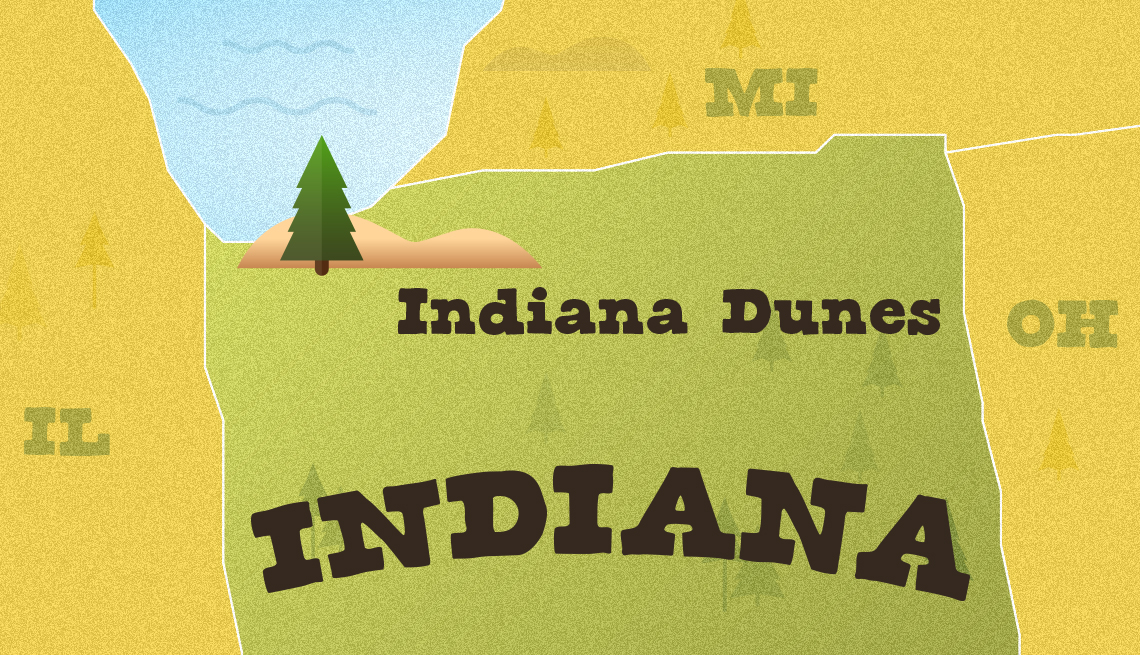
Getty Images/AARP
Location: Porter, Indiana
Acreage: 15,000 acres
Highest peak: Mount Baldy at 126 feet
Miles of trails and how many: 50 miles of trails across 14 trail systems
Main attraction: Sand dunes
Cost: Free; parking at West Beach in summer is $6
Best way to see it: Driving the Red Arrow Highway
When to go to avoid the crowds: Spring
Plan Your Trip
Relative to many other remote national parks, IDNP is on the beaten path, virtually in the backyard of Chicago, less than 40 miles northwest, and the starting point of many a day-tripper here. Indianapolis lies 160 miles south.
Getting to IDNP from Chicago by either Interstate 94 or the parallel toll road Interstate 90, you'll feel you've hardly left the gritty city when you exit at Gary, Indiana, the park's westernmost entryway and a city synonymous with steel mills. But proving nature's resiliency, the dunes and forests persist minutes from Gary's factories and smokestacks.
Perhaps fittingly then, IDNP is a driver's park. Though you can also reach it via railroad — the South Shore Railroad departing from Chicago has four park stations — a car helps you get around and beyond the occasional industrial pockets and to its main visitor center, focusing on orientation, and the Paul H. Douglas Center for Environmental Education, offering ranger-guided events and children's programming. The two-lane Highway 12, known as the Red Arrow Highway, is the park's 22-mile main thoroughfare, stringing together trail access points, park attractions and small towns between Gary and Michigan City (the park's eastern boundary) that would be difficult to get to on foot.
Consider visiting this park more than once, as the seasons change the experience dramatically. The beaches are busy in summer, but the park is quiet and often beautifully covered in frost or snow in winter. A snowstorm blowing down the lake brings out cross-country skiers and snowshoers. Come in fall to catch color season on the trails and in spring to see returning birds and those migrating along the Lake Michigan Flyway.
Because admission is free, it's easy to come and go frequently at the park. Being near a major city, it has good cellular service. And because it's also dispersed, the park has many picnic areas and public bathrooms, not just at the visitor centers, but at attractions and some trailheads.
Many trails over the dunes require strenuous uphill climbing, sometimes in sand, which makes it harder to gain a foothold, and sometimes via stairways erected to protect against erosion. But many of the trails are gentle and often have benches for taking breaks.

Tribune Content Agency LLC / Alamy Stock Photo
Dunewood Campground
Where to Stay and Eat
Dunewood Campground , the park's only campsite, is open April through October and hosts just 66 sites — 53 for RV drive-in stays and 13 for tents only. The cost is $25 per night and sites should be reserved well in advance at recreation.gov.
Complicating IDNP's fragmented boundaries even more, Indiana Dunes State Park occupies its own 2,200 shorefront acres surrounded by the national park. Admission to the state park ($12) is separate and its nearly 150 campsites cost $25 and $32, depending on the day of the week. Reservations open six months in advance and can be scarce in summer.
If you're not a camper, you can opt for any of the area's many chain hotels, vintage motels, inns, rental homes and B&Bs (find a list at indianadunes.com/places-to-stay). In Chesterton, each of the four rooms at the At Home in the Woods Bed and Breakfast (from $159) has a theme from a different national park. A pool, sauna and hot tub add to the B&B's appeal. Forty acres generously buffer the 12-room Brewery Lodge & Supper Club (from $79) in Michigan City, with a restaurant tucked into a 1930-vintage brick home.
You won't find any food concessions in the park, but the surrounding communities happily feed visitors with everything from fast-food stands to breweries, Mom ‘n’ Pop sandwich shops, food trucks, coffee shops and cafés (browse the list at Indiana dunes .com ). Insider tip: Given IDNP's splendor, take food into the park during the daytime for a picnic at the beach or on a trail. Stop in to Goblin & the Grocer in Beverly Shores for upscale sandwiches, such as the Caprese, and homemade clam chowder.
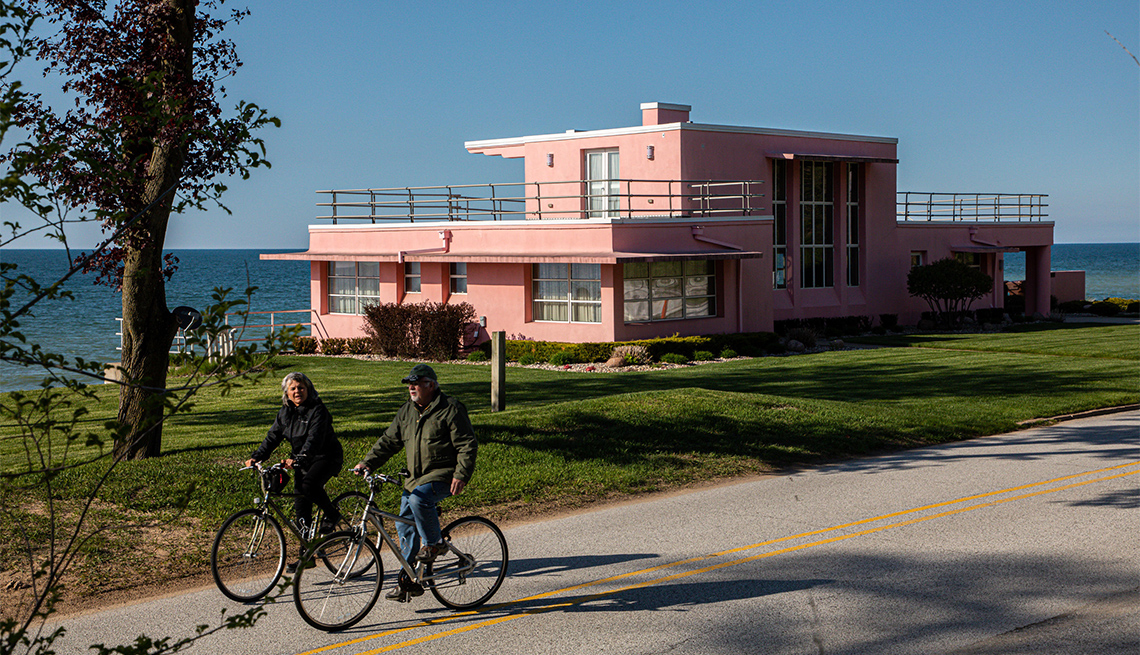
A Century of Progress home
Things to Do
Most visitors, especially in summer, head straight for the Lake Michigan beaches to cool off (despite the year-round chilly water). But IDNP, though small, is a rangy park and rewards explorers with many diversions from its main thoroughfare, the Red Arrow Highway, including the following highlights.
Revel in a rare oak savanna: The “ridges and swales” of Miller Woods , as Prof. Cowles noted in the 1890s, reveal the presence of glaciers some 3,000 years ago. The undulating landscape on the park's west side — between Miller Woods and nearby Tolleson Dune — nurtures an endangered black oak savanna, a 1,042-acre sparsely wooded grassland with fire-resistant oaks in which prairie plants flourish, producing stunning wildflower blooms in spring and early summer, including bird-foot violet, lupine, mountain honeysuckle and pasture rose. The Park Service manages fires here to maintain this diverse habitat and prevent the trees from taking over, a natural process once sparked by lightning. At Miller Woods, some 3.2 miles of easy loops and interconnecting trails also reach the Lake Michigan shore and pass wetlands, which are particularly good places to bird-watch.
Do the dunes: One of the park's signature dunes, 126-foot Mount Baldy has been moving inland rapidly as a result of human intervention in the lake, but it's still a beauty to behold. The 1.5-mile moderate round-trip trail at Mount Baldy (not wheelchair-accessible) actually goes around the giant dune, visible from the parking lot, to prevent more erosion and to protect hikers from invisible sinkholes that form around sand-covered trees. Take the short, somewhat steep descent to the beach to ogle Baldy from the lakefront.
Explore more dune succession on the 3.4-mile 3-Loop Trail at West Beach, which has extensive boardwalks and stairways that put you in and around the dunes without contributing to erosion. The stair-climbing can be exhausting, but you'll get stunning views of the lake, jack pine groves, isolated ponds and undulating dunes.
For sheer height, climb three of the coast's tallest dunes — Mount Tom, Mount Holden and Mount Jackson, at 192, 184 and 176 feet, respectively — at neighboring Indiana Dunes State Park. The pitch of the dunes and the loose sand underfoot makes these trails challenging; in fact, doing all three is known as the 3 Dune Challenge.
Get bogged down: Named for Prof. Cowles, who studied plant evolution here, Cowles Bog is a roughly 205-acre wetland notable for its plant diversity. The moderate 4.7-mile Cowles Bog Trail takes you past its many habitats, including black oak savannas, lakefront dunes, marshes and ponds. If you're looking for a daylong hike, try this one and pack a lunch for picnicking lakeside.
Tour five futuristic homes: You know you're in a quirky park when a flamingo-pink modernist home perched atop a lakefront dune with views back across the lake to Chicago ranks as one of the major sights. The stucco Florida Tropical House is one of five Century of Progress Homes displayed at the 1933 World's Fair in Chicago as examples of modern design and models of experimental materials. At the fair's end in 1935, a real estate developer shipped the homes across the lake by barge to attract home buyers to his new resort community of Beverly Shores, which the park now surrounds. On a self-guided tour, stroll the open-air time capsule created by this cluster of architectural icons on Lake Front Drive. Most times of the year, you can't go inside the homes, but you can read informational panels in front of them. Insider tip: The nonprofit Indiana Landmarks, which leases most of the homes to residents who pay for their leases by improving the properties, opens them for tours each September.
Meet early park residents: Native Americans, traders and immigrant farmers populated this dunes region before it became a national park or even a botany research subject. Learn about early inhabitants of the area at the Chellberg Farm and neighboring Bailly Homestead. The house and barn built by the Swedish Chellberg family in the 1870s hosts an apple festival each September and rangers offer guided tours of the farmhouse, animals and vegetable garden weekly from late June to mid-August. Volunteers run the farm operations, including a “sugar shack” for making maple syrup from tree sap.
From the farm, it's a shady, third-of-a-mile walk through a dense forest banking the Little Calumet River to reach the Bailly Homestead , an original 1822 fur trading post and one of only two stops for missionaries, traders and travelers between Detroit and Chicago at the time, now designated a National Historic Landmark. Though their interiors are closed, the grand house and hand-hewn log outbuildings transport visitors to an earlier age when the leafy compound was a bustling center of early 19th-century life. Immerse yourself in the past through free weekly ranger-led Bailly/Chellberg History Hikes, June through August (no registration required; see the events page at the park website ).
For an in-depth experience: Pinhook Bog preserves the region's glacial past created of a former kettle lake left behind by melting glaciers that eventually became acidic, supporting floating mats of sphagnum moss, orchids, ferns and, most intriguing, carnivorous plants such as pitcher plants and sundew. A vulnerable and rare ecosystem, the bog is only open in summer during ranger-led tours, which fill up quickly (sign up by calling the visitor center).

AARP Membership -Join AARP for just $12 for your first year when you enroll in automatic renewal
Join today and save 25% off the standard annual rate. Get instant access to discounts, programs, services, and the information you need to benefit every area of your life.
Gateway Towns
IDNP has many gateways, including Gary and Michigan City at either end, smaller towns inland — including Porter and Chesterton — and, of course, Chicago nearby.
Gary: You'll pass through Gary to get to Miller Woods via Lake Street. Though the city is highly industrialized, its small Lake Street commercial strip is worth a stop for its few galleries and gift shops (duck into Indie Indie Bang Bang for its design-centric housewares and gifts) and its eating and drinking spots. At Miller Pizza Co., order your pie Chicago deep-dish style or thin, and take advantage of its bargain weekday lunch specials. After a hike, reward yourself with one of the refreshing craft beers at nearby 18th Street Brewery.
Michigan City: At the park's other end, Michigan City is a much more robust gateway, especially with its lavish Blue Chip Casino on Trail Creek downtown. There, besides gambling, you can check into one of its 486 rooms; dine in a steak house, sports bar or deli; and book rejuvenating spa treatments. In the downtown, pedestrian-friendly lakefront, learn about the city's history at the 1858 Michigan City Lighthouse, now a museum, and the 35,000-square-foot Barker Mansion, built in 1857 by John Barker Sr., president of a railroad freight car company, and now a museum celebrating life during the Gilded Age (now closed for renovations, but check back for opening dates).
Enjoy the breezy spirit of Bridges Waterside Grille from the deck overlooking a marina for casual pub fare (try the fried shrimp po'boys and barbecued beef brisket). Grab an 1871 American pub ale, a burger and a live music set at Zorn Brew Works.
Northern Indiana: From Michigan City, you can also explore the many agricultural attractions in this area of the state. On the fringes of Michigan City, pick blueberries at Stateline Blueberries a few miles northeast of the waterfront, and taste-test the unoaked chardonnays made with Sonoma County grapes at nearby Shady Creek Winery. Pair them with charcuterie, cheese plates and pizzas indoors by the fire or out on the patios.
Smaller towns: Edging the park on the inland side, Chesterton and Portage both have many chain hotels (see indianadunes.com for a list). For retro kicks, order a home-brewed root beer and a chili dog at the Port Drive-In, a 1958-vintage drive-in restaurant in Chesterton.
From Chicago: Pay homage to Prof. Cowles at the University of Chicago in Hyde Park, on the Windy City's southside with a stroll on its main campus, modeled on English Gothic style (think of the University of Oxford). Stop into the tranquil Plein Air Café just off campus, next to Frank Lloyd Wright's Robie House, for a cold brew and a hazelnut beignet on the leafy patio. If you're a bird lover, check out the nearby Wooded Island in Jackson Park, a hot spot where the Chicago Audubon Society leads regular birding walks each Saturday morning.
From the east: Stop in South Bend, Indiana, to wander through the Studebaker National Museum. The 55,000-square-foot facility showcases the world's largest collection of U.S. Presidential Carriages (before they had cars), including the barouche that President Lincoln used the night of his assassination, as well as an array of Studebaker and Packard automobiles, originally made in South Bend.
Just a few blocks from the museum, dine in the mansion that a member of the auto-making family, Clem Studebaker, built between 1886 and 1889. Called Tippecanoe Place, it now houses a landmark restaurant (the French onion soup and prime rib are musts) and a more casual beer-centric lounge in which you can revel in the 19th-century architecture.
From Michigan: The 30 or so miles of shoreline north of the Indiana border, collectively called Harbor Country, draws vacationing Chicagoans. At Warren Dunes State Park , about 23 miles from Michigan City, delight in running down the dunes onto the beach; and in small towns, stop to shop, eat and treat yourself at ice cream parlors. Just over the Indiana-Michigan border in New Buffalo, line up for a Velveeta-topped cheeseburger at the thronged, cash-only roadhouse Redamak's, a local legend for its cheeseburgers.
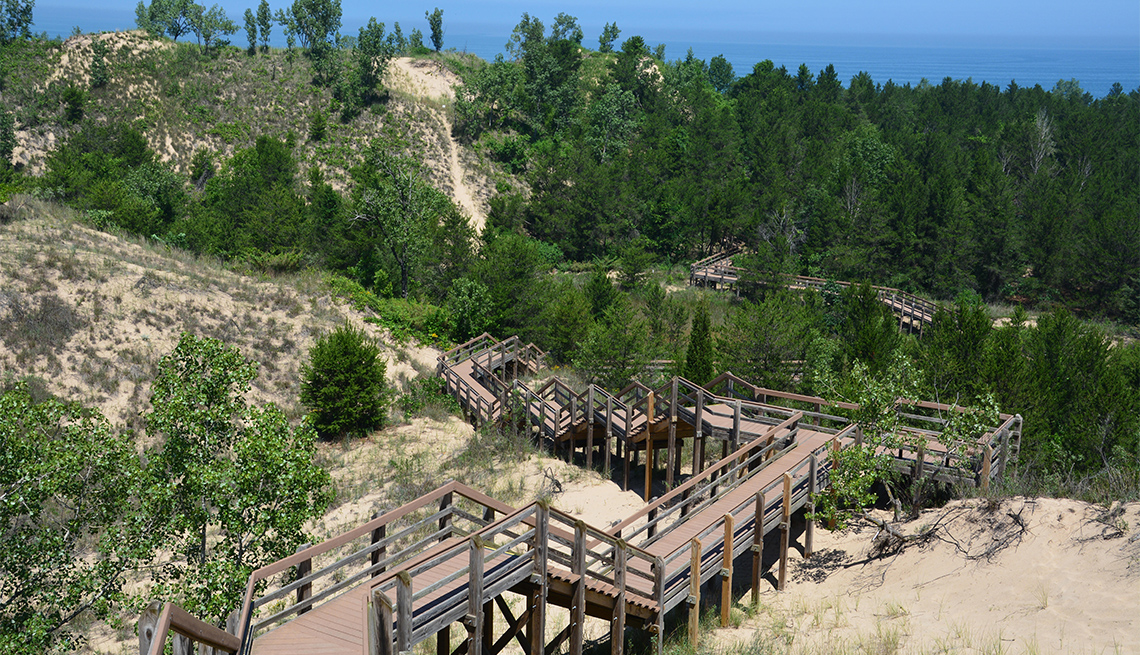
PHOTO BY: D Guest Smith / Alamy Stock Photo
Boardwalk stairs lead to the overlook on the Dune Succession Trail in the West Beach section of the park.

PHOTO BY: George Ostertag / Alamy Stock Photo
Visit the Bailly Homestead, built by the Swedish Chellberg family in the 1870s.

PHOTO BY: Russell Kord / Alamy Stock Photo
Mount Baldy is the highest dune in the park.
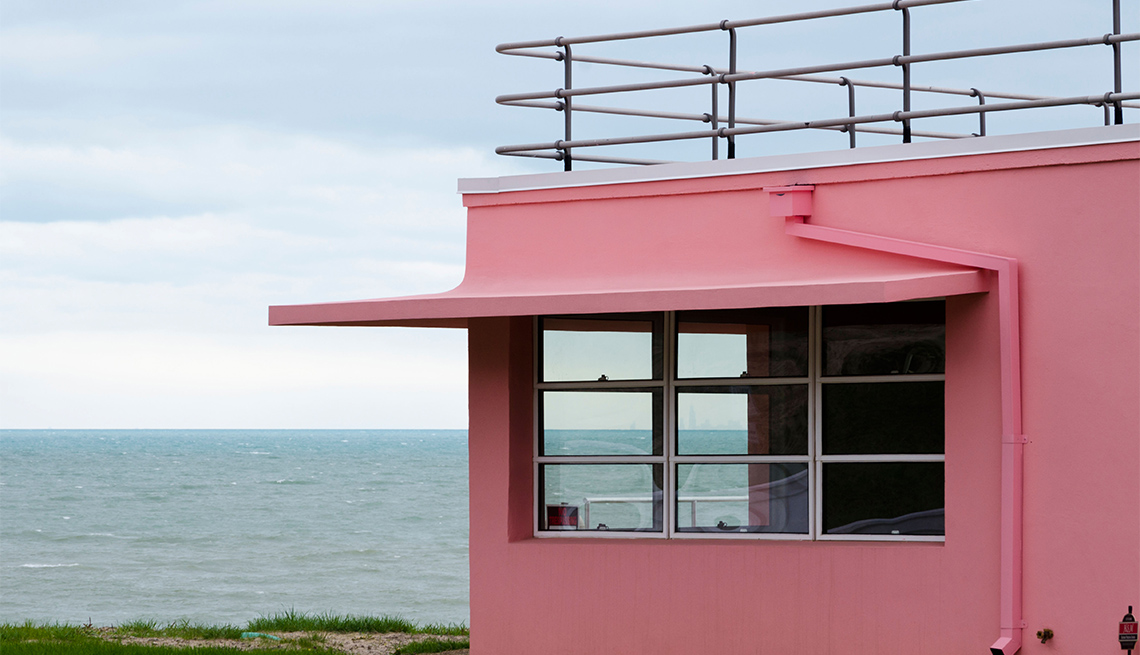
PHOTO BY: Michael Snell / Alamy Stock Photo
One of the Century of Progress Homes that were displayed at the 1933 World's Fair in Chicago as examples of modern design, and later shipped here.
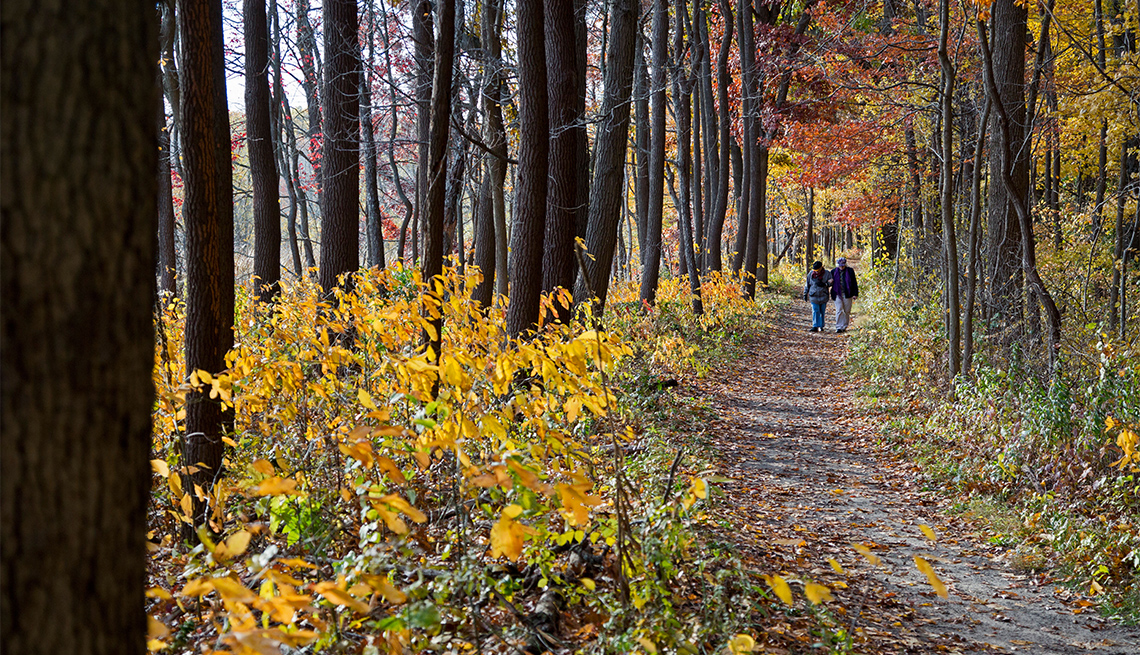
PHOTO BY: Jim West / Alamy Stock Photo
Fall is a beautiful time to visit.
Elaine Glusac, a Chicago-based journalist, writes the Frugal Traveler column for the New York Times.
Also of Interest
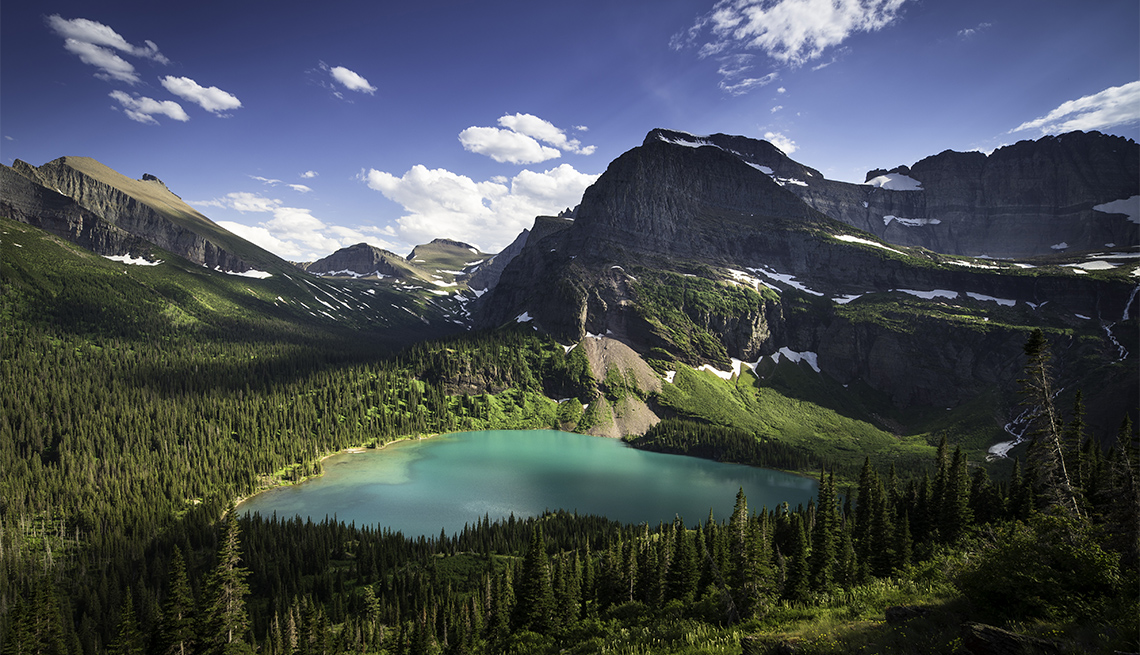
Glacier National Park
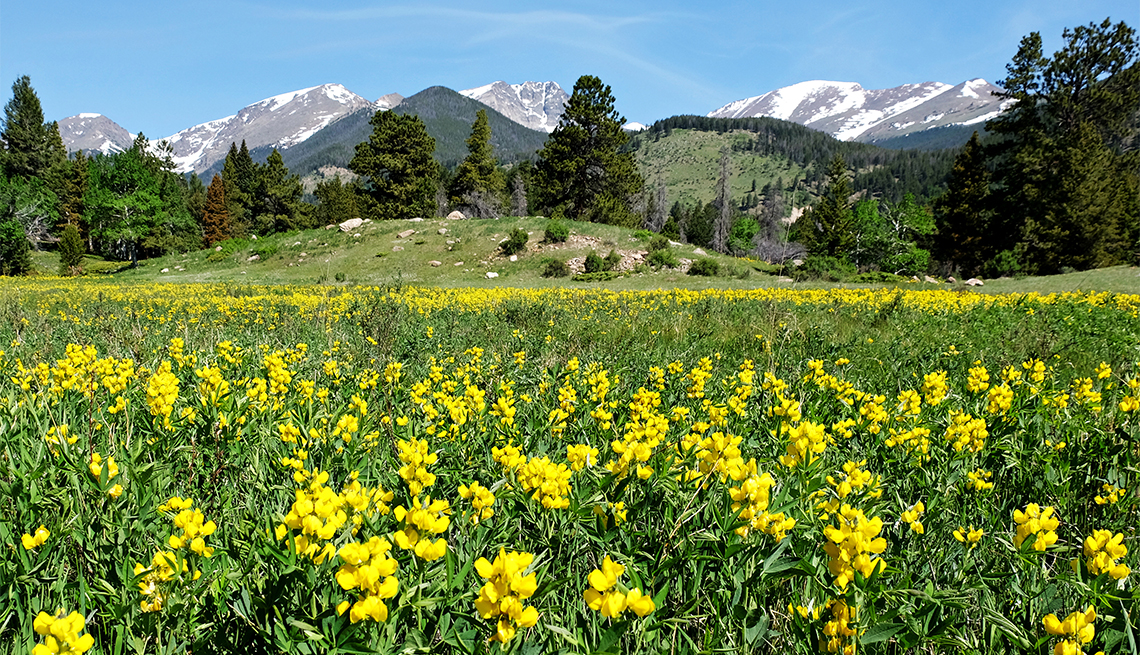
More National Parks
Call: 1.800.675.4318
Search Flights
Enter a valid location
Enter a valid date
Child under 2 must either sit in laps or in seats:
Add Another Flight
Search Hotels
Search Packages
You didn't specify child's age
There are children in rooms without an adult
You have more than 6 people total
Please select a trip duration less than 28 days
There must be at least 1 traveler (age 12+) for each infant in a lap
Search Cars
Search Cruises
Select a valid location
Select a month
Search Things to Do
You are leaving AARP.org and going to the website of our trusted provider. The provider’s terms, conditions and policies apply. Please return to AARP.org to learn more about other benefits.
Your email address is now confirmed.
You'll start receiving the latest news, benefits, events, and programs related to AARP's mission to empower people to choose how they live as they age.
You can also manage your communication preferences by updating your account at anytime. You will be asked to register or log in.
In the next 24 hours, you will receive an email to confirm your subscription to receive emails related to AARP volunteering. Once you confirm that subscription, you will regularly receive communications related to AARP volunteering. In the meantime, please feel free to search for ways to make a difference in your community at www.aarp.org/volunteer
Javascript must be enabled to use this site. Please enable Javascript in your browser and try again.
Your browser is not supported for this experience. We recommend using Chrome, Firefox, Edge, or Safari.
Things to Do with Kids in the Indiana Dunes Area
Are you planning a family trip to the Indiana Dunes? The Indiana Dunes region offers a wealth of kid-friendly activities that make it a perfect destination for families. This guide seeks to answer the question: “What are the best kids' activities near me?” From outdoor adventures to sweet treats, here are some of the best things to do with kids in the Indiana Dunes.
Watch a Movie at the 49’er Drive-In
Experience the nostalgia of a classic drive-in movie at the 49’er Drive-In . This family-friendly venue is perfect for a fun-filled evening under the stars. Load up your car with blankets and folding chairs, arrive early to secure a spot, and enjoy the double feature with your loved ones. The affordable pricing here makes it an excellent family outing: $10 for ages 12 and up, $5 for ages 5 to 11, and free for kids 4 and under.
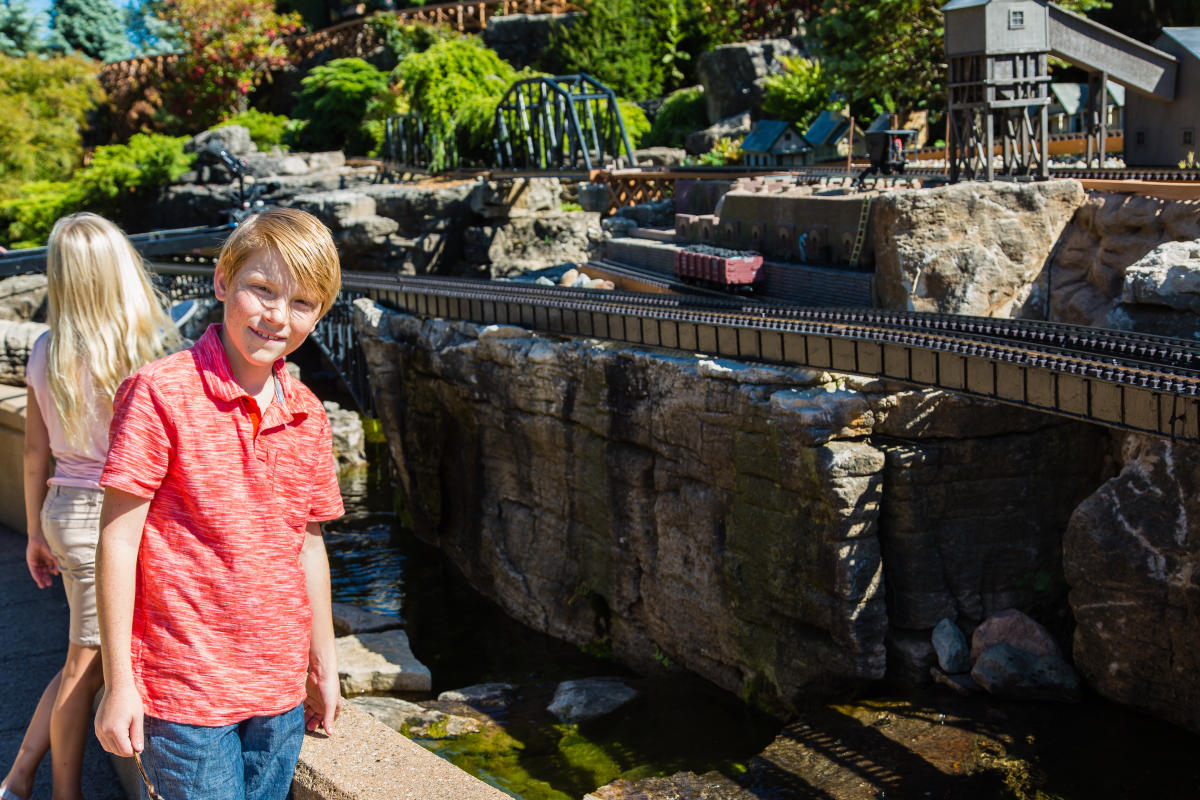
Visit the Gabis Arboretum at Purdue Northwest
The Gabis Arboretum is a wonderful destination for families with young children. The Railway Garden Train, an outdoor G-gauge model train garden, tells the fascinating story of America's railroads. For a short and accessible walk, try the Heron Trail, a 0.28-mile paved and mulched path named for the Little Green and Great Blue Herons that frequent the pond it encircles.

Have a Picnic at Sunset Hill Farm County Park
Sunset Hill Farm County Park is an ideal spot for a family picnic. With plenty of picnic areas, trails, and even farm animals like goats and chickens for kids to interact with, it's a perfect place to spend a day outdoors. The park also features the Illiana Garden Railway Society's G-Scale Garden Train Layout, which operates every Saturday.
Enjoy Kid-Friendly Hiking Trails
Coffee Creek Preserve is a great choice for family-friendly trails. It features a 1.3-mile short loop and a 3-mile long loop, boardwalks, bridges, and plenty of wildlife. Indiana Dunes National Park also features popular family-friendly trails, including the Calumet Dunes Trail, the Bailly/Chelberg Trail Loop , the West Beach Trails, and the Portage Lakefront and Riverwalk Trail.

Enjoy a Sweet Treat at Tethan’s Candy & Confections
Tethan’s Candy & Confections in Chesterton offers a delightful array of sweets that will thrill kids and parents alike. This family-owned business specializes in unique and delicious candies, from a wide variety of chocolates to novelty candies like freeze-dried Skittles.
Don’t miss the chance to play the Beanboozled game, a fun and adventurous way to taste-test different candies. If you haven’t filled up on sweets, explore Chesterton for local restaurants and family-friendly dinner options, including Lucrezia Café , Duneland Station Deli , The Port Drive-In , and Gastro 49 .
When planning a trip to the Indiana Dunes region with a family in tow, you’ll surely be asking yourself the essential question: What are some fun things to do with kids near me? And you won’t be lacking in options! The Indiana Dunes region offers a fantastic mix of activities that cater to families with kids. See you soon!
Indiana Dunes Tourism
- Search Please fill out this field.
- Current Issue
- Give a Gift Subscription
- Manage Your Subscription
- Newsletters
- Sweepstakes
- Around the Midwest
The Best Scenic Drive in Every Midwest State
See which routes our travel experts picked to highlight the beauty and diversity of each Midwest state.
Katy is a lifestyle journalist who splits her time between Nebraska, Minnesota, and Wisconsin. As a born-and-bred Midwesterner, she is passionate about covering her home region. Besides Midwest Living, Katy's work has appeared in Travel+Leisure, Reader's Digest, Departures, Martha Stewart Living, and more. Follow her on instagram for worldly travels, lots of wine, and tons of Baby Bob content.
:max_bytes(150000):strip_icc():format(webp)/0-72d86f3b178c4036bfe3287445d0e3b4.jpeg)
Donovan Reese/Getty Images
Whether you've got an afternoon, a weekend or a week to explore, you can count on a scenic byway to deliver natural beauty as well as historic, cultural and recreational stops. More than 1,200 national- and state-designated byways crisscross the U.S., including dozens in the Midwest. To fully tap into the Midwest passion for road trips, we polled some regional experts for their favorite drives. From the vast prairies of the Plains, to the watery wonders of the Upper Midwest, here are the best scenic drives in every Midwest state, according to travel experts.
Minnesota: Gunflint Trail Scenic Byway
Wisconsin-based, Iowa-grown travel writer Jacqueline Kehoe , a Midwest Living contributor, thinks the 57-mile Gunflint Trail Scenic Byway from Grand Marais to Saganaga Lake is Minnesota’s best roadway. “A giant neon logger holding a canoe used to mark the entrance, and that says it all,” she says. “This absolutely iconic ‘trail’—it's a paved two-lane road—comes dotted with lodges, restaurants and hiking treks, and it leads to one of the nation's last great wildernesses: the Boundary Waters Canoe Area Wilderness.” Though other spots like the Driftless Scenic Byway are lovely, there’s just something special about Up North.
Michigan: Copper Country Trail National Byway
According to Midwest-based journalist Stephanie Vermillion , author of the upcoming National Geographic book 100 Nights of a Lifetime and a Midwest Living writer, this UP route is as wild as Michigan gets. The Copper Country Trail National Byway runs for 47 miles of the Keweenaw Peninsula via US-41 from Houghton to Michigan's northernmost town, Copper Harbor. “It's a leaf peeper's paradise, with thick forest canopies lining much of the route,” she says. Among her suggestions: “Hike nature hangouts like Manganese Falls and Estivant Pines Wilderness Nature Sanctuary (a sanctuary protecting Michigan's old-growth white pines), mountain bike the trails at Keweenaw Mountain Lodge or the Keweenaw Point Trail, or drive up Brockway Mountain for sweeping Lake Superior views.” Enjoy even more Keweenaw action on a lollipop loop linking US-41 with the waterfront M-26 from Eagle River to Copper Harbor.
North Dakota: Theodore Roosevelt National Park Scenic Drives
With two national and 11 state scenic byways crossing the Peace Garden State, there are so many ways to explore North Dakota by car . But the most iconic would be the roads that twist through the badlands of Theodore Roosevelt National Park's North and South units. If it's any indication of the rugged country you'll be traversing, erosion undercut six miles of the South Unit Loop five years ago; while the road is being repaired, visitors can drive 44 miles out and back to landmarks like Wind Canyon, Skyline Vista and the Coal Vein Nature Trail. In the North Unit, a 28-mile in-and-out drive leads to the panoramic Riverbend Overlook and Oxbow Overlook as well as rock formations called cannonball concretions, set in a Martian-like landscape. Look for feral horses, bison and prairie dogs along your journey. "As you drive through TRNP, the landscape is ever-changing," says Julia Sayers Gokhale, senior travel editor of Midwest Living. "I was enamored by the multi-layered formations."
Matt Miller
Nebraska: Outlaw Trail Scenic Byway
Don’t overlook the Cornhusker State when it comes to scenic drives. Joe Sills , a travel writer and Midwest enthusiast, can’t say enough good things about a certain stretch of Nebraska road. He says that travelers who dart across Nebraska on I-80 are missing a beautiful drive along the Outlaw Trail Scenic Byway . “Tucked along Nebraska’s northern border with South Dakota, the hills and hollows of Highway 12 loosely follow the trail of famous outlaw Jesse James, hugging the Missouri River from Ponca to Valentine,” Sills says. He recommends stops like Niobrara State Park, for spectacular views above the Missouri River; Smith Falls State Park, for the state’s largest waterfall; and the Cowboy Trail, for a great rails-to-trails route. “The byway doubles as a back door to Badlands National Park , or sets up a loop back to I-80 through one of the most diverse wetlands in the country—the Valentine National Wildlife Refuge," Sills says. "This birder’s paradise straddles ancient, petrified sand dunes leading down to the Platte River Valley, where enormous Sandhill cranes migrate through late winter and early spring.”
Credit: Kansas State Tourism
Kansas: Flint Hills National Scenic Byway
The Sunflower State boasts a total of 12 byways, three historic and nine scenic. Of the scenic pathways, the Flint Hills National Scenic Byway makes an especially compelling pick. This 47-mile route from Council Grove to Cassoday takes roughly 90 minutes to traverse (since time is the ultimate way to measure a Midwestern drive). Plus, it offers easy access to the 11,000-acre Tallgrass Prairie National Preserve . With only 4 percent of the country’s tallgrass prairie remaining, the preserve is a vital conservation area that allows for a glimpse of the past. Try fishing, hiking, and wildlife viewing for a taste of the Great Plains. To put your trip in perspective, stop by the Flint Hills Discovery Center if your route takes you through the college town of Manhattan, about 40 minutes north of Council Grove.
Aaron Peterson
Wisconsin: Lake Superior National Scenic Byway
“ With spots like the Apostle Islands, the south shore of Lake Superior is phenomenal at every turn—add in cultural stops like Copper Crow Distillery and you've got a twofer of natural beauty and things to do,” says Wisconsin writer and travel pro Jacqueline Kehoe. This 70-mile route follows the southern shore of Lake Superior along the Bayfield Peninsula and features access to lovely gems like the wellness-y Wild Rice Retreat and the Indigenous-inspired cuisine of Miijim .
Outdoor Indiana/Frank Oliver
Indiana: Whitewater Canal Scenic Byway
There’s plenty more to Indiana than a dynamic capital city . The Whitewater Canal Scenic Byway is a Southern Indiana gem and a National Scenic Byway that runs for 78 miles along the forks of the Whitewater River. An adventure tourism and history hotspot, this area attracts travelers with its charming small towns like Connersville and Metamora, Whitewater Memorial State Park, the state’s longest bike trail, a working grist mill, and rolling hills. This route also connects to two other byways, the National Road Scenic Byway and the Ohio River Scenic Byway.
Courtesy of Travel South Dakota
South Dakota: Badlands Loop State Scenic Byway
This otherworldly drive is truly breathtaking, giving Grand-Canyon-meets-the-moon vibes in the Midwest. Stretching for 39 miles, the Badlands Loop is South Dakota’s loveliest roadway. More than a dozen overlooks and pull-offs provide views of rock formations jutting up from the prairie as well as access to trails; you'll also find wildlife viewing opportunities galore. Learn about the geology of Badlands National Park at the Ben Reifel Visitor Center and pick up tips about trails, then head out on your exploration.
Iowa Tourism Office
Iowa: Driftless Area Scenic Byway
When the last glaciers smoothed out the Midwest, they left part of Iowa, Wisconsin, Illinois and Minnesota untouched—an area of steep hills and valleys known as the Driftless Region because it has no glacial deposits, or drifts. In Iowa, check out the rolling hills in the northeast for the prettiest drive in the Hawkeye State, including spots like Effigy Mounds National Monument . “The Midwest's Driftless Region is difficult to grasp if you've never seen it,” says Kehoe. “All the more reason to take this 144-mile drive along Iowa's towering limestone bluffs, rolling meadows, roller-coaster hills, forested valleys, and toward the Mississippi River. Stop in Decorah for great beer and Iowa's tallest waterfalls.”
Jason Lindsey
Missouri: Great River Road
Though the Great River Road, a National Scenic Byway and All-American Road, traverses many Midwestern states, the bluffy beauty of the Missouri stretch is especially scenic. Highlights along the route include Ste. Genevieve National Historic Park , the first permanent European settlement in Missouri; the historic towns of St. Charles and Cape Girardeau; and Mark Twain’s hometown of Hannibal , including the famous area caves that inspired his seminal work. When you reach St. Louis, ride to the top of the Arch in Gateway Arch National Park for views up and down the mighty river that's been your travel companion.
Illinois: Historic Route 66
A National Scenic Byway and All-American Road, Historic Route 66 stretches from Chicago to the Chain of Rocks bridge that crosses into Missouri. Known as “The Mother Road,” Route 66 is the undisputed king of road trips in the U.S., and it originates in Chicago. It’s famed for its kitschy, nostalgic vibes. Be sure to see Pontiac's 24 outdoor murals , Sugar Creek Covered Bridge and The Pink Elephant Antique Mall as well as bits of Americana like Odell's Standard Gas Station. The old Chain of Rocks Bridge , now one of the world’s longest pedestrian/bicycle bridges, is also a highlight.
Ohio: Lake Erie Coastal Ohio Scenic Byway
The Lake Erie Coastal Ohio Scenic Byway traces the northern edge of Ohio, showing off the Buckeye state's Great Lakes beauty and rich culture along the way. It's a favorite for Cleveland-based adventure journalist and photographer Stephanie Vermillion . “It follows Lake Erie for nearly 300 miles, with stop offs like Kelleys Island State Park (accessible by ferry or kayak), world-renowned Cedar Point amusement park, the city of Cleveland and its waterfront museums like the Rock and Roll Hall of Fame, and Ohio's wine country" around Geneva-on-the-Lake, she says.
Related Articles
- Skip to global NPS navigation
- Skip to this park navigation
- Skip to the main content
- Skip to this park information section
- Skip to the footer section

Exiting nps.gov
Alerts in effect, lake view beach at indiana dunes national park, park footer, contact info, mailing address:.
1100 North Mineral Springs Road Porter, IN 46304
219 395-1882 Indiana Dunes Visitor Center phone number.
Stay Connected

IMAGES
COMMENTS
Serving up adventure since 1925. With over 2,000 acres of stunning terrain to explore, discover our Hoosier landscape from beaches and sand dunes to wetlands and ancient forests. You'll find adventure and history intertwined in 15,000 acres of diverse national park terrain, acclaimed entertainment venues, beloved buildings, curated ...
Plan Your Visit. Composite of photos showing the four seasons. NPS Graphic. There is no one-size-fits-all trip to the dunes. Each season offers new and different ways to enjoy Indiana Dunes National Park. Spring splashes the river banks of the Heron Rookery with an abundance of colorful wildflowers in this birder's paradise.
Relax at the Indiana Dunes National Park Visitor Center and enjoy our park videos, "Child of the Northwest Wind" and "The Indiana Dunes: Our Natural Wonder" for a virtual tour of park. Each video is 12 minutes in length. ... Travel along Stagecoach Road in the town of Portage to view ancient sand dunes covered in oak savanna and woodland.
The park is comprised of both state and national parklands, with beautiful beaches and concentrations of sand dunes in each of the park areas. There is a fee of $7 for Indiana residents and $12 for out-of-state residents to enter the state park area and a fee of $6 to visit the West Beach section of the Indiana Dunes National Park.
The park is interrupted by Indiana Dunes State Park, which charges an entrance fee ($7 for Indiana residents and $12 for out-of-state visitors). Estimated distance from major cities nearby Chicago ...
Porter, IN 46304, USA. Get directions. Phone +1 219-395-1882. Visit website. Indiana Dunes National Park is a sandy landscape full of dunes, wetlands, prairies, and forests covering 15,349 acres of diverse ecosystems. The park in northwest Indiana, formerly called Indiana Dunes National Lakeshore, stretches for 15 miles along the shore of Lake ...
Lake Michigan's might has influenced Indiana Dunes for millennia. Wind and waves have shaped the land, leaving a rich mosaic of habitats along these 15 miles of Indiana coast. Over 50 miles of trails lead through shifting sand dunes, quiet woodlands, sunny prairies and lush wetlands. Known for its striking plant and bird diversity, it's easy to find inspiration throughout the park's 15,000 ...
Indiana Dunes National Park sandwiches Indiana Dunes State Park, where you can find the area's three tallest dunes: Mount Tom (192 ft), Mount Holden (184 ft), and Mount Jackson (176 ft).
Located on the shores of Lake Michigan, Indiana Dunes is the fourth-most biodiverse national park in the country, despite a relatively small footprint compared to others in the park system. Visitors come to admire wildflowers each May, but not many know the colorful spring blooms are just a few of the more than 1,100 different plant species ...
Between shoreline strolls, well-worn hiking trails, and pick up games of frisbee, you'll discover a piece of paradise all your own. Here, you'll find adventure and history intertwined in 15,000 acres of diverse national park terrain, acclaimed entertainment venues, beloved buildings, curated experiences, and a long list of local festivals ...
A little planning can go a long way. That's why we have a selection of free digital and printed guides to help you navigate your next Indiana Dunes getaway. Recommended as a "Best For Families" park by National Geographic, Indiana Dunes National Park is an ideal destination for family adventures. Located just a few hours from major….
Indiana Dunes National Park is a national park located in Northwestern Indiana. The only national park in Indiana, it's popular for its big sand dunes and plentiful beaches on Lake Michigan, and for its easily accessible location near Chicago. The park is also home to a variety of ecosystems including swamps and forests, with diverse plants and ...
Things To Do. Enjoy the outdoors year-round at Indiana Dunes National Park. From swimming and sunbathing in the summer to cross-country skiing and snowshoeing in the winter, each season offers visitors the chance to experience this unique park. Hiking is rewarding in every season. Spring wildflowers are abundant along the Little Calumet River ...
The national park is a short hop from Chicago (40 miles northwest) and lies between the towns of Gary and Michigan City. While most visitors come by car, it's easy to reach the dunes by train ...
Park Details. Indiana Dunes National Park was established on November 5, 1966, and has a total area of 15,000 acres (23 square miles, or 61 square kilometers). Address. 1215 SR-49, Porter, IN, 46304. Phone.
Chicago Midway International Airport is located 43 miles from Indiana Dunes National Park. This airport offers 220 daily flights to 77 U.S. cities and several direct flights to over 12 international destinations. Many popular airlines are serviced by Chicago Midway International Airport, including Allegiant, Delta, Frontier, and Southwest.
Admission to Indiana Dunes National Park. For the first few years, admission was free to the National Park. However, starting in 2022 there is now a $25 admission fee per car good for 7 days. Annual passes such as the America the Beautiful or Every Kid Outdoors pass will work for entry.
Where to Stay and Eat. Dunewood Campground, the park's only campsite, is open April through October and hosts just 66 sites — 53 for RV drive-in stays and 13 for tents only.The cost is $25 per night and sites should be reserved well in advance at recreation.gov.. Complicating IDNP's fragmented boundaries even more, Indiana Dunes State Park occupies its own 2,200 shorefront acres surrounded ...
West Beach Trails. 3-Loop Hike: Moderate to rugged, 3.4 miles in length, hike time of 2.5 hours. Dunes Succession Hike: Moderate, 0.9 mile in length, hike time of 45 minutes. These trails offer a great combination of hiking and relaxing at the beach. The trails are varied and encompass many habitats.
Visit the Indiana Dunes Visitor Center for maps, events, and other park information; Enjoy Indiana Dunes State Park as well and take the 3 Dunes hiking challenge; Enjoy some time on the 18 miles of sandy beaches and just relax; Go for a bike ride on 75 miles of park trails; Get out on the water in a canoe, kayak, or sailboat on Lake Michigan; Try out some dune buggies on the sand dunes
Indiana Dunes Tourism. 1215 N State Road 49, Porter, Indiana 46304 +1(219) 926-2255
The Ultimate Guide to Theodore Roosevelt National Park. ... The Whitewater Canal Scenic Byway is a Southern Indiana gem and a National Scenic Byway that runs for 78 miles along the forks of the Whitewater River. An adventure tourism and history hotspot, this area attracts travelers with its charming small towns like Connersville and Metamora ...
Indiana Dunes National Park Annual Pass. This pass provides entry for the pass owner(s) and passengers in a family-sized vehicle. This pass only works at the Indiana Dunes National Park and is not accepted at the Indiana Dunes State Park. Cost: $45.00